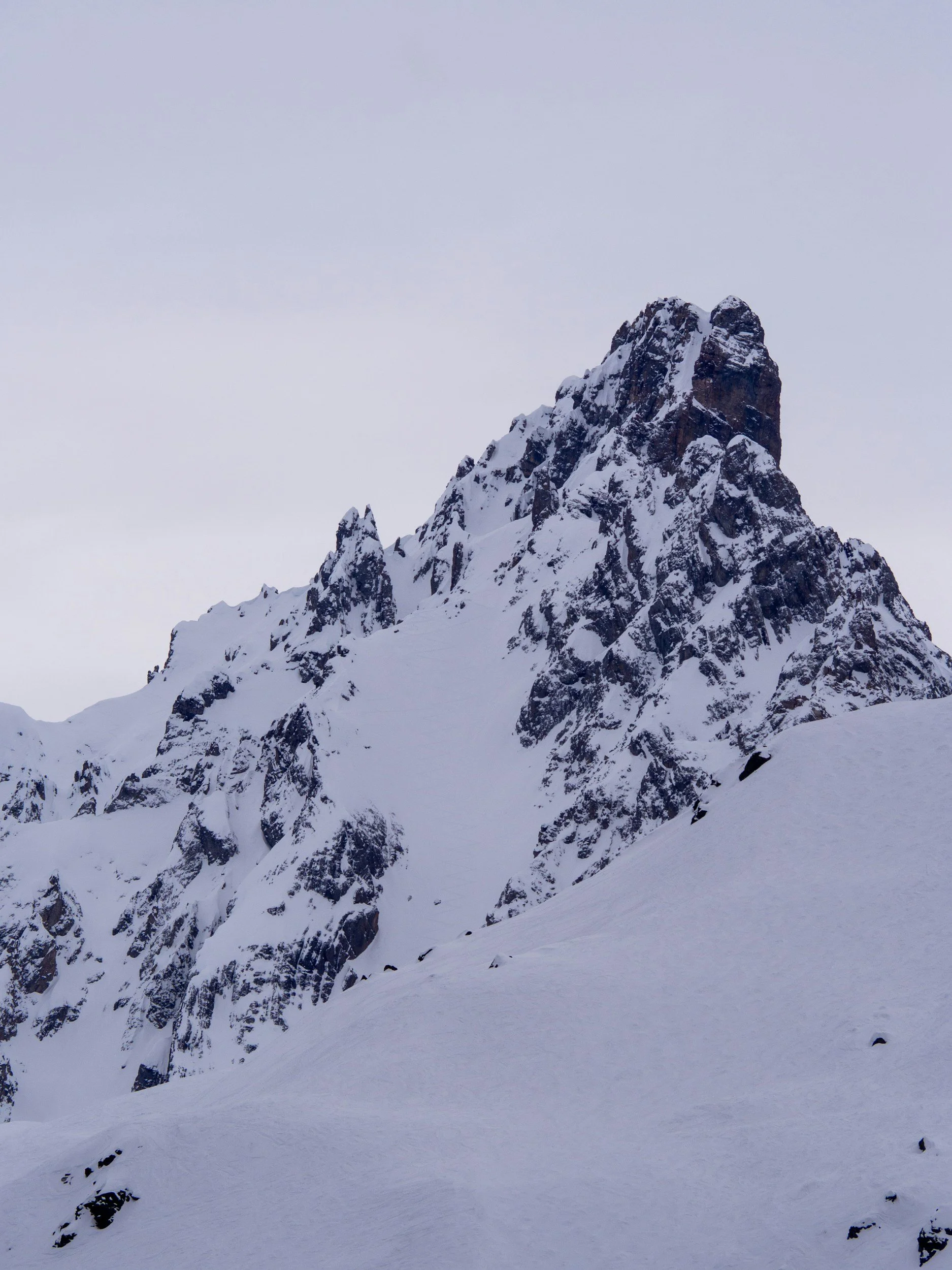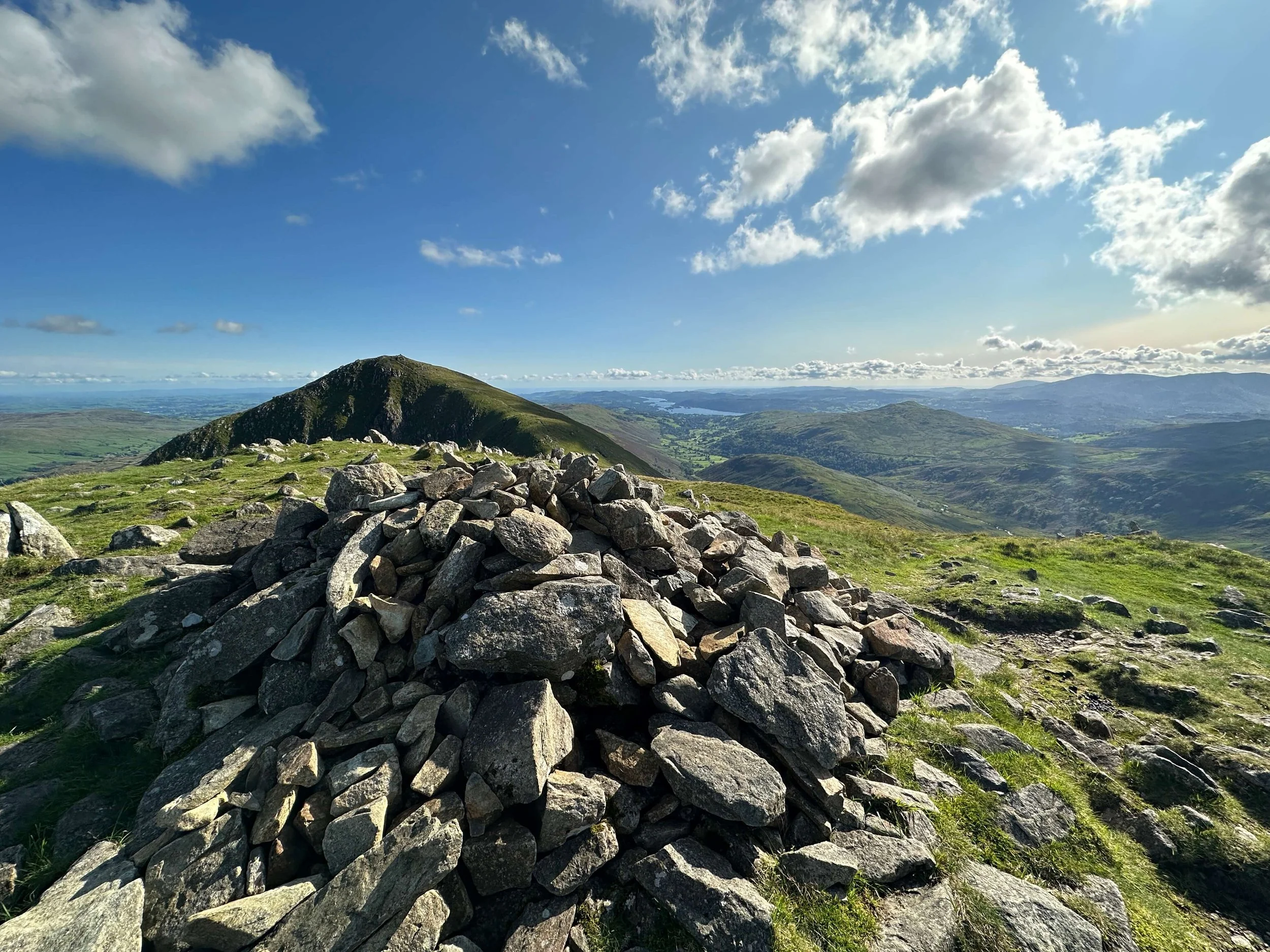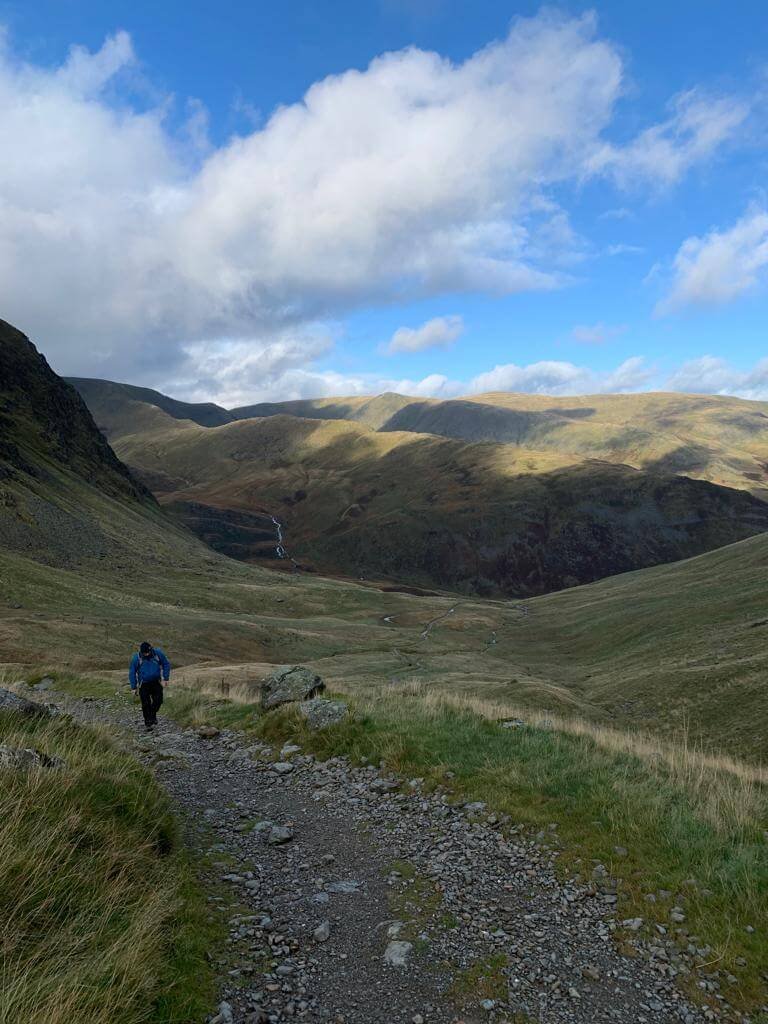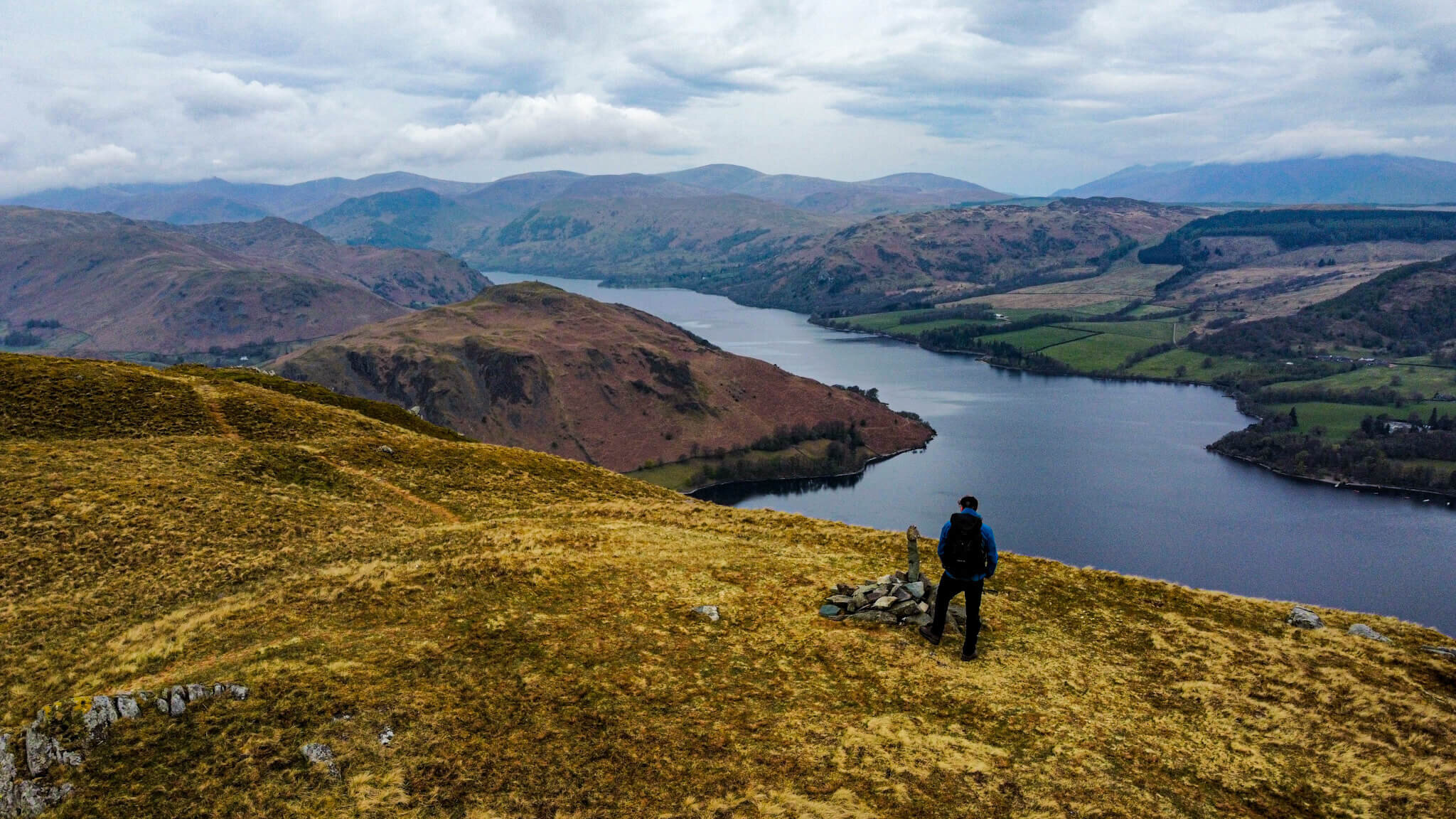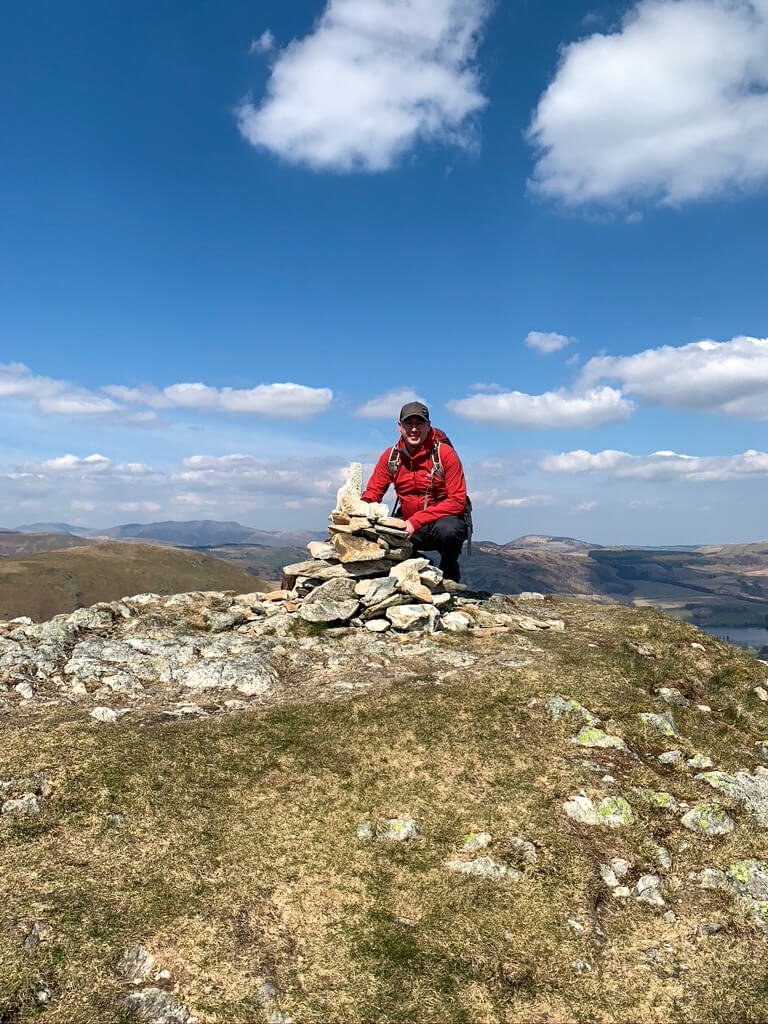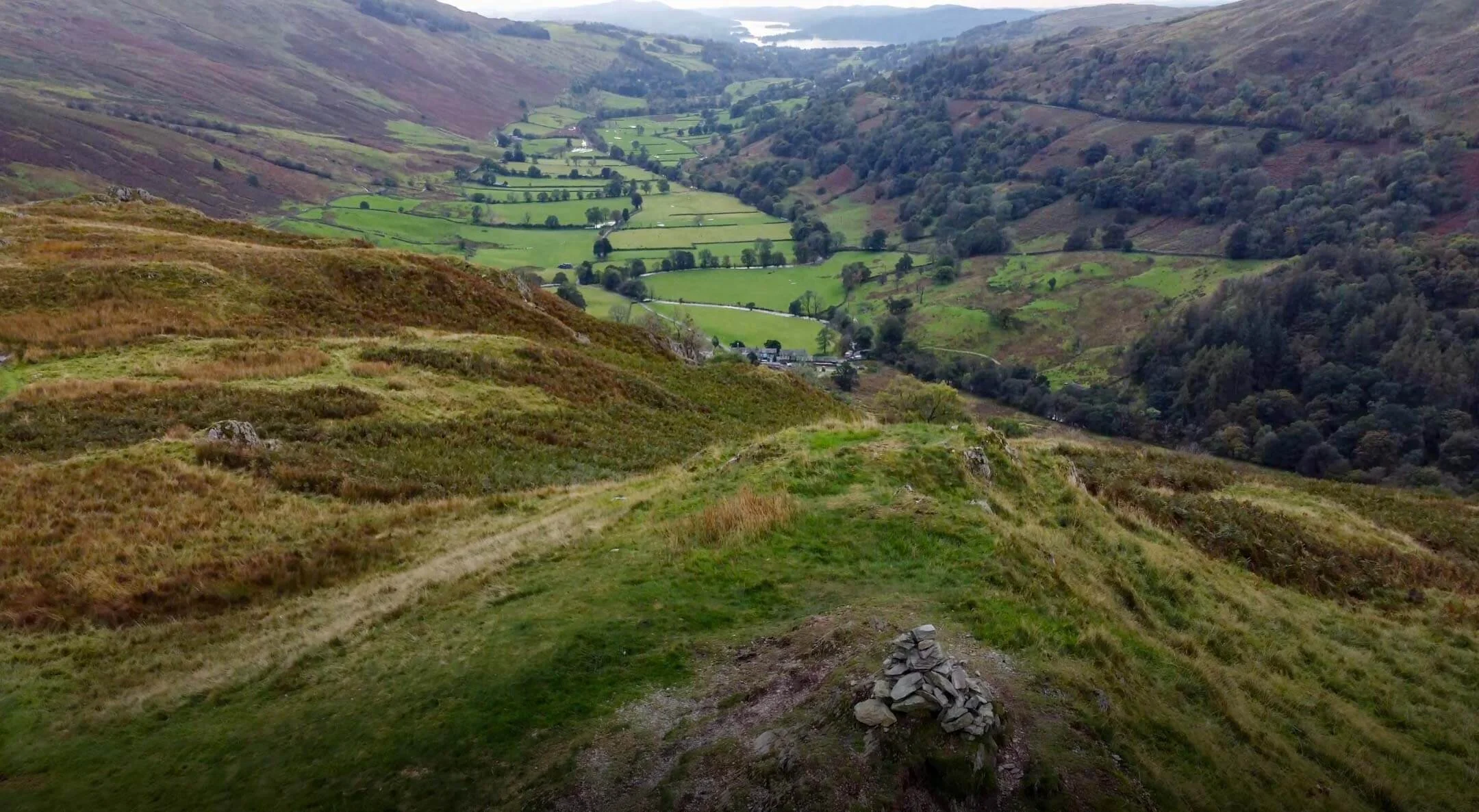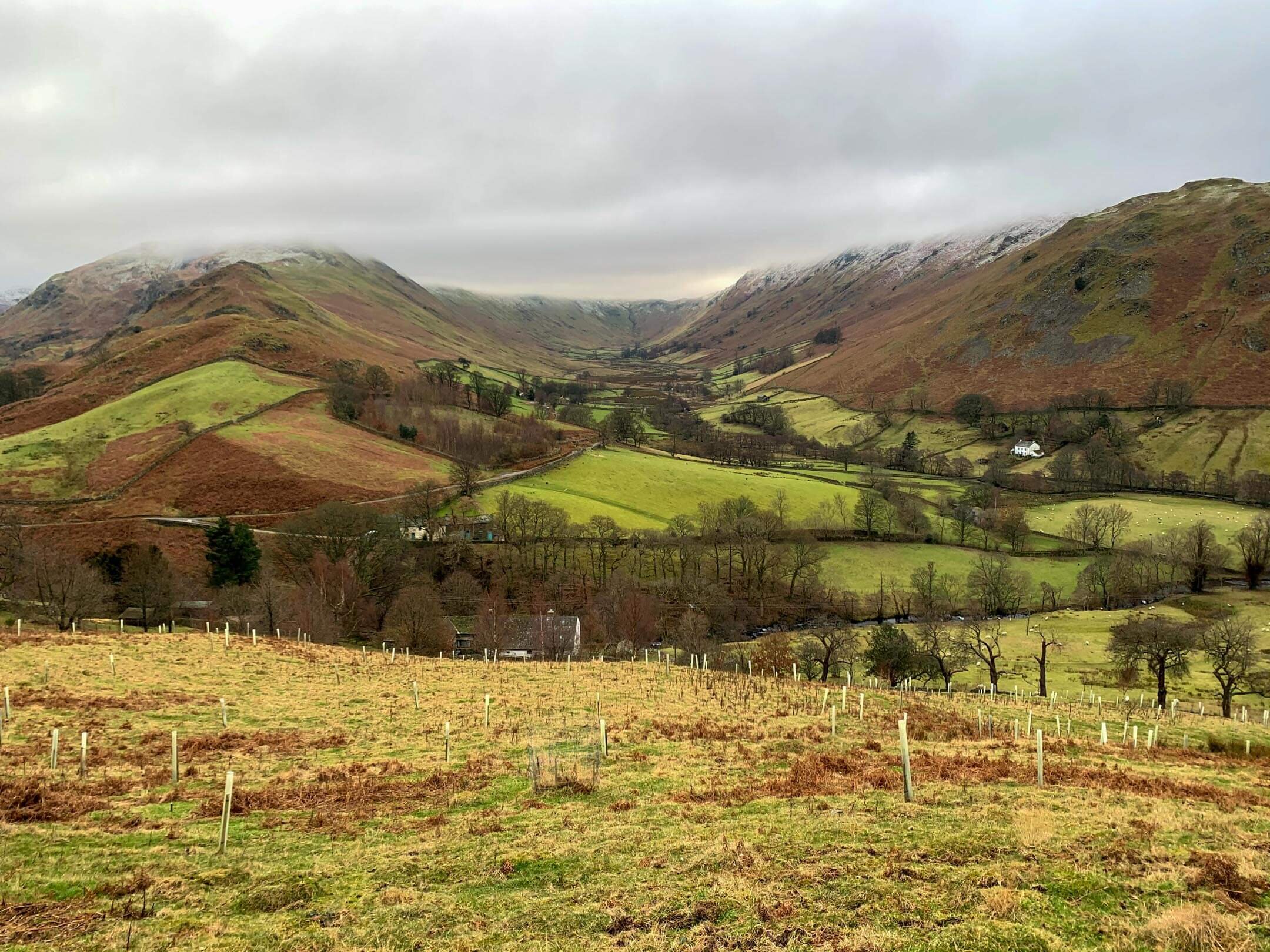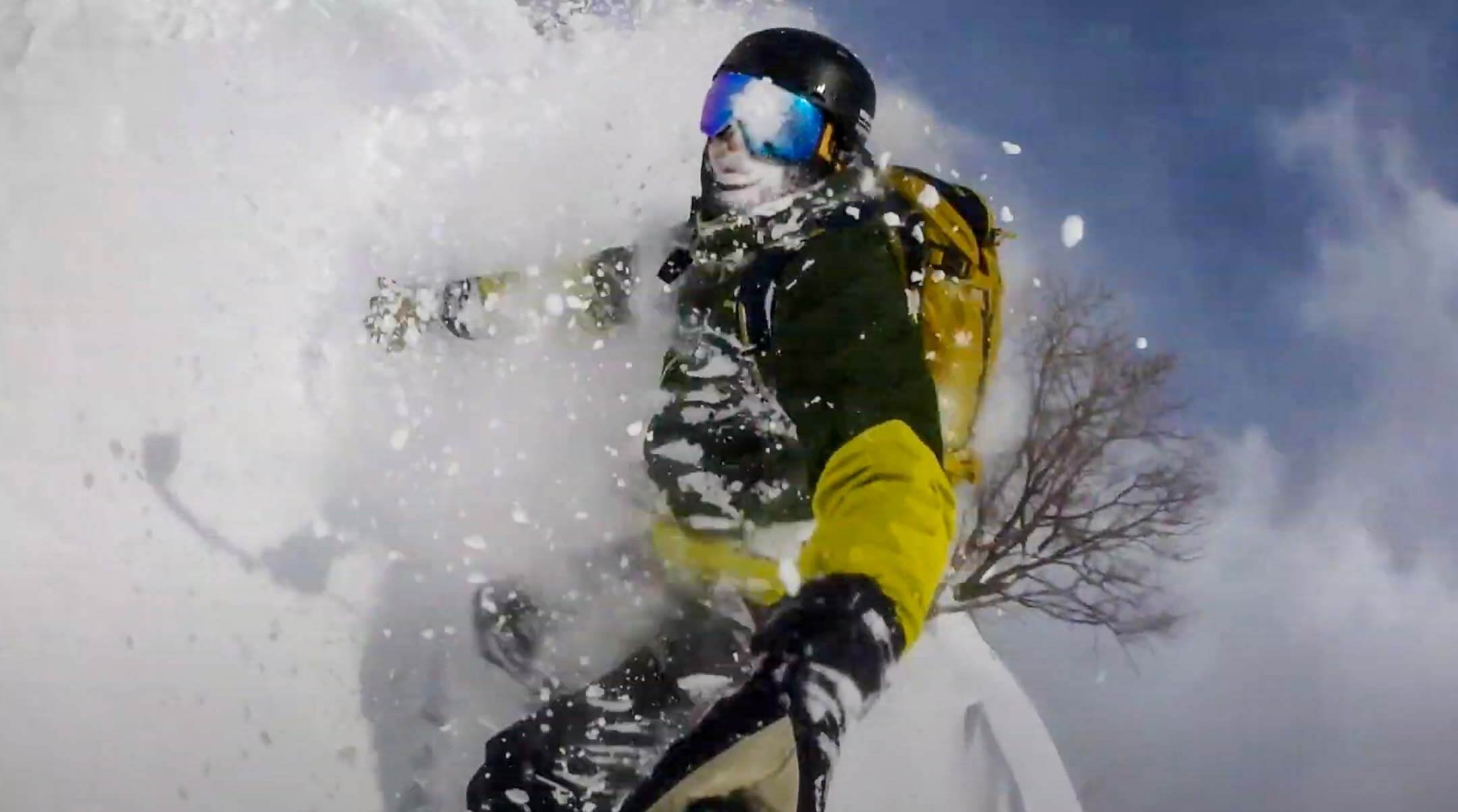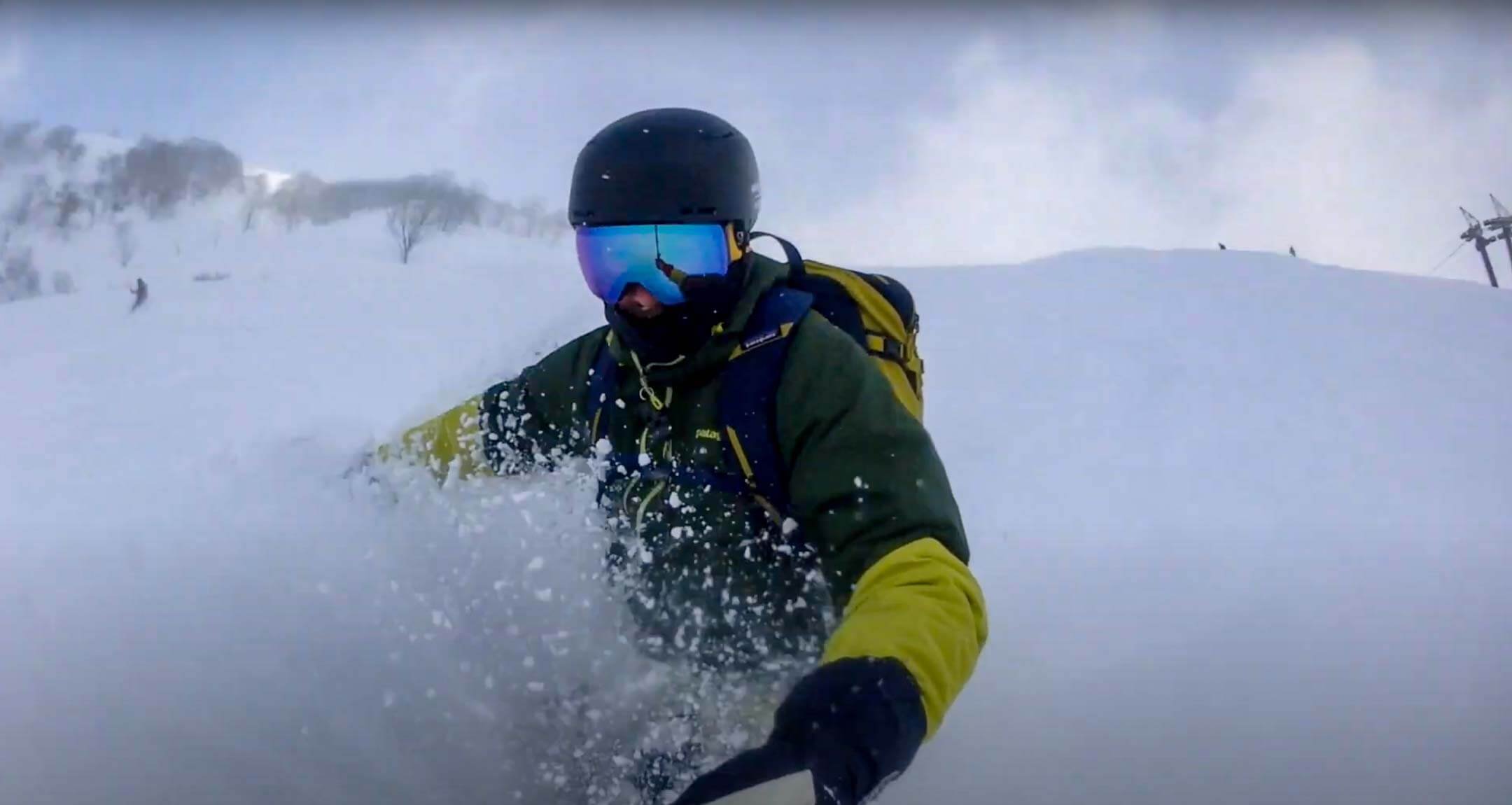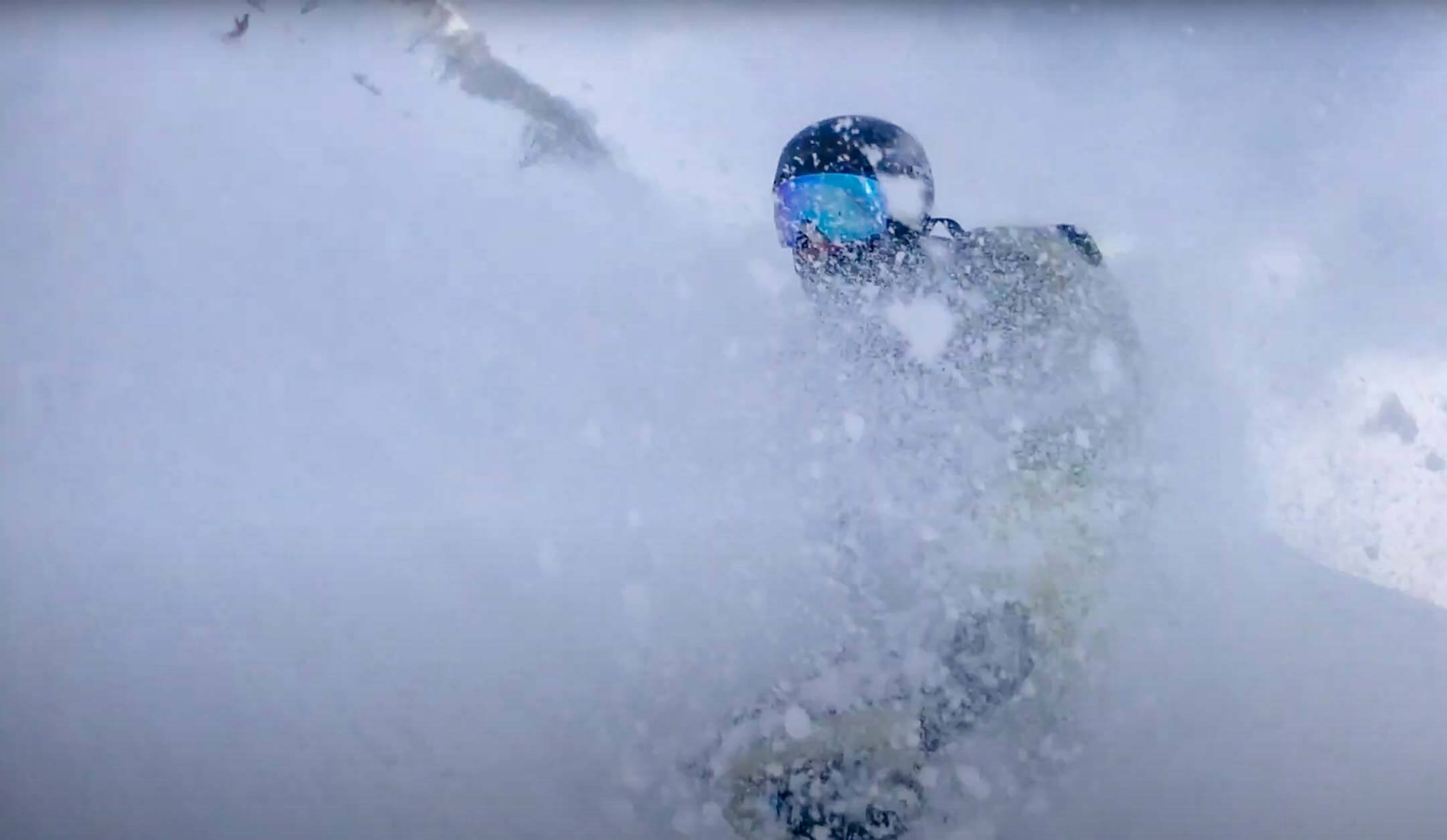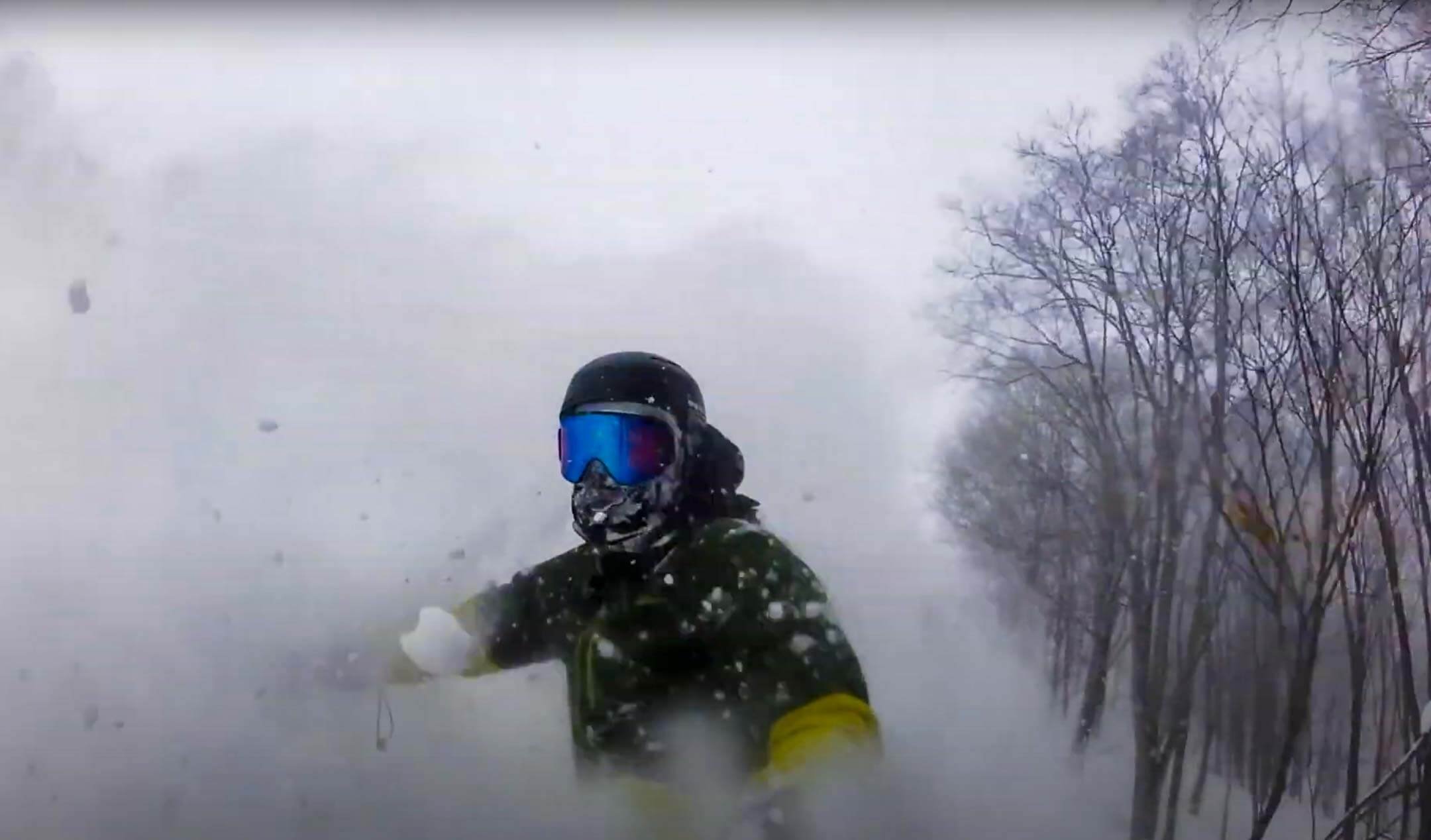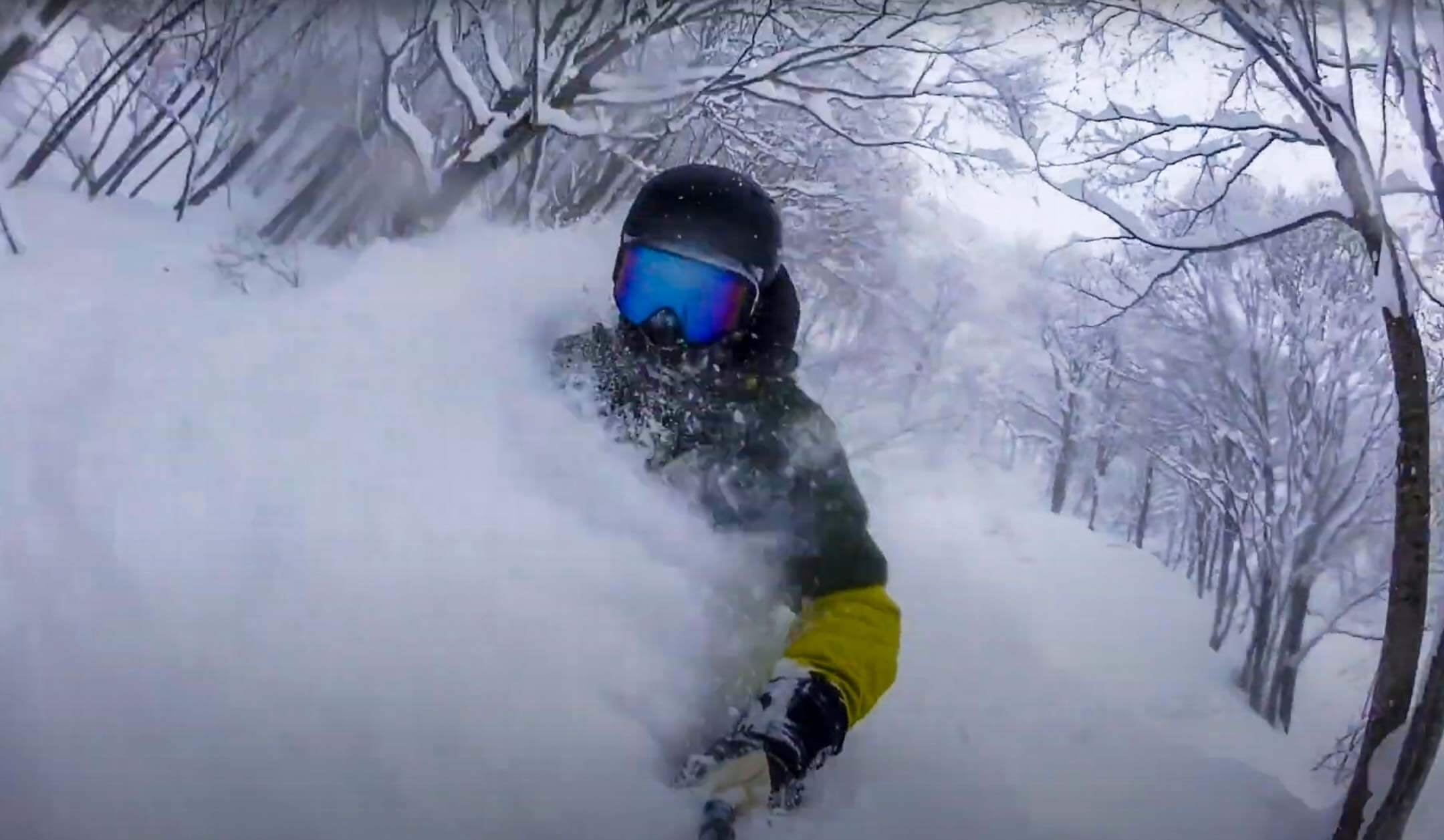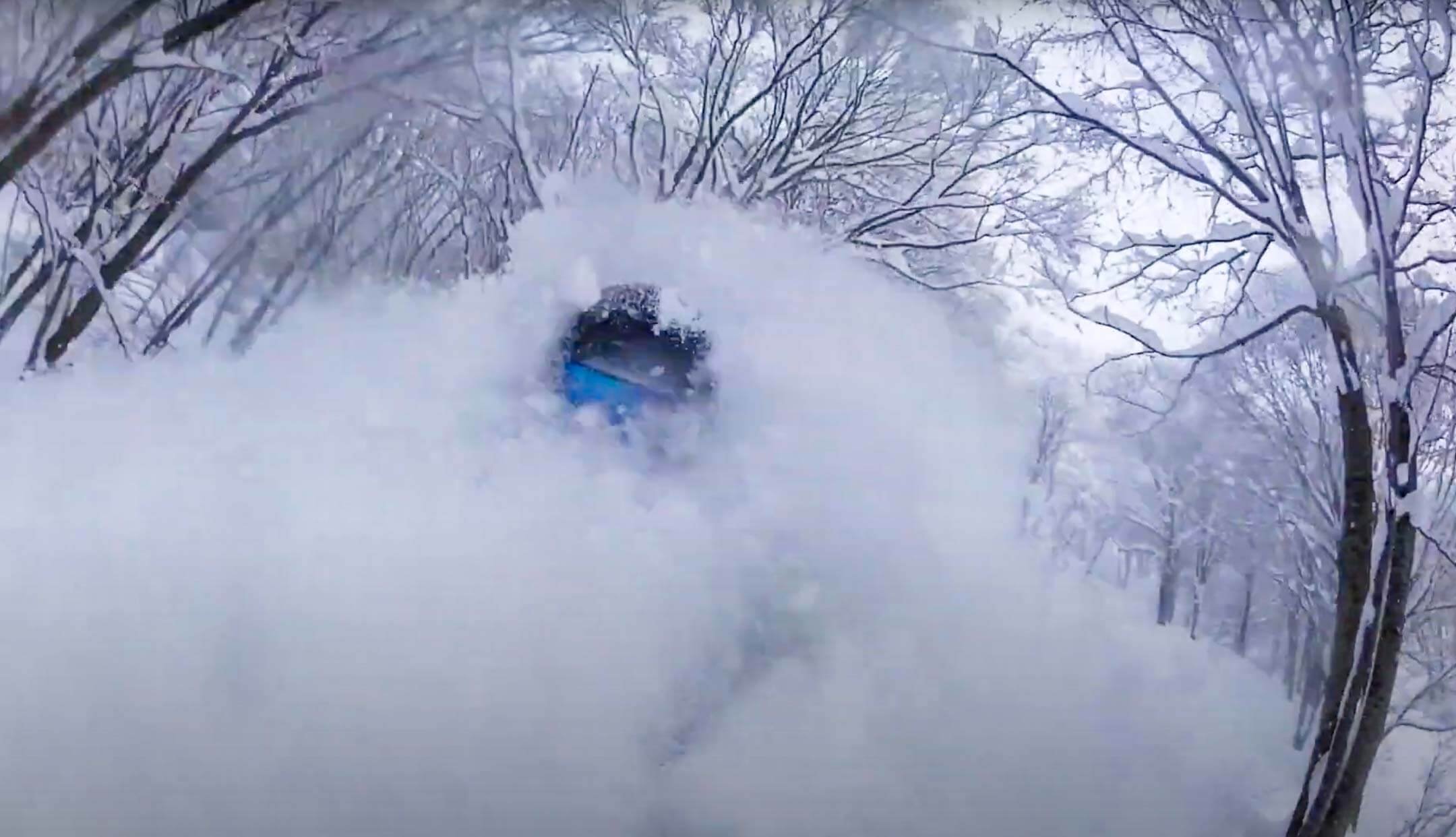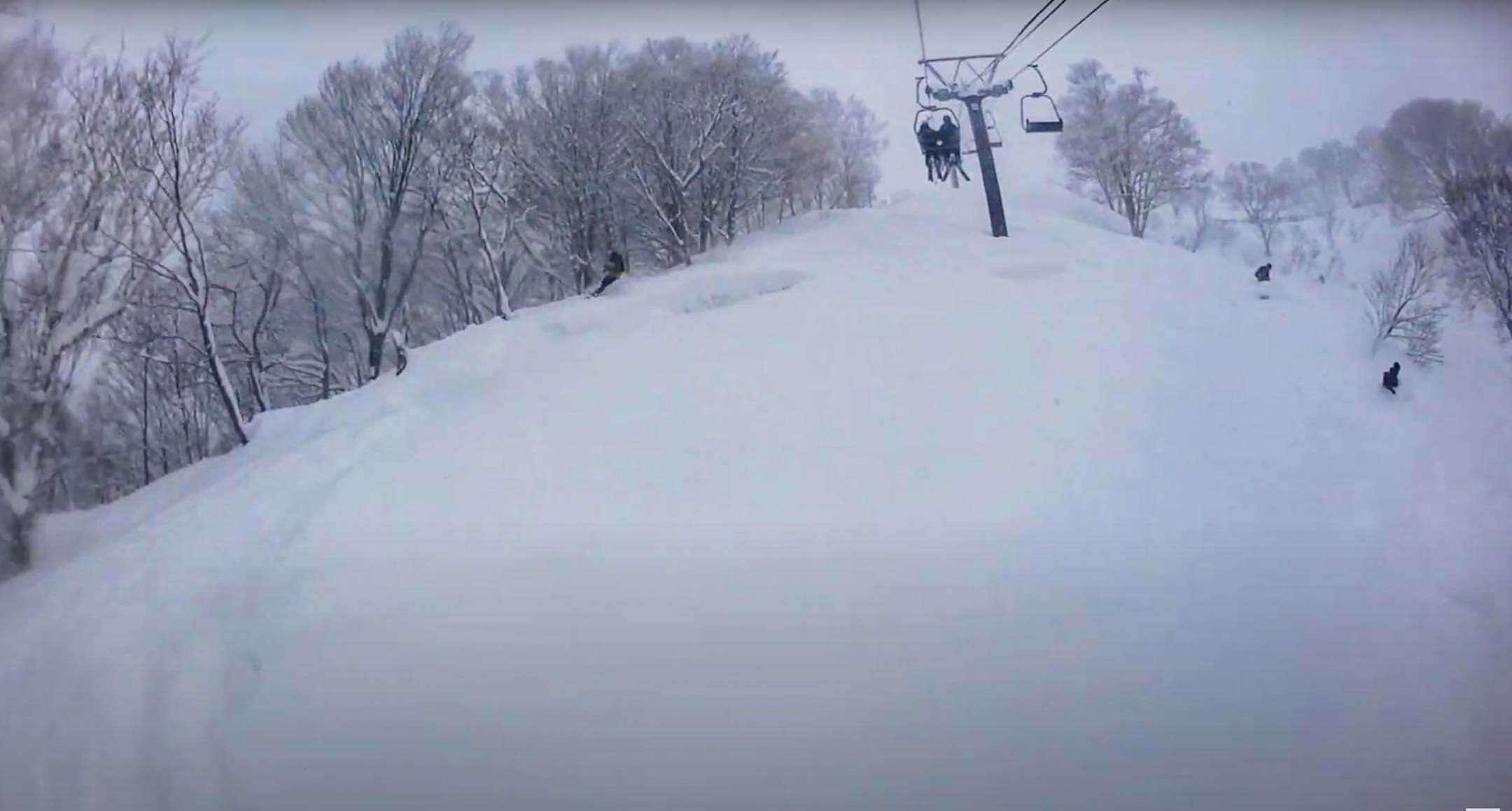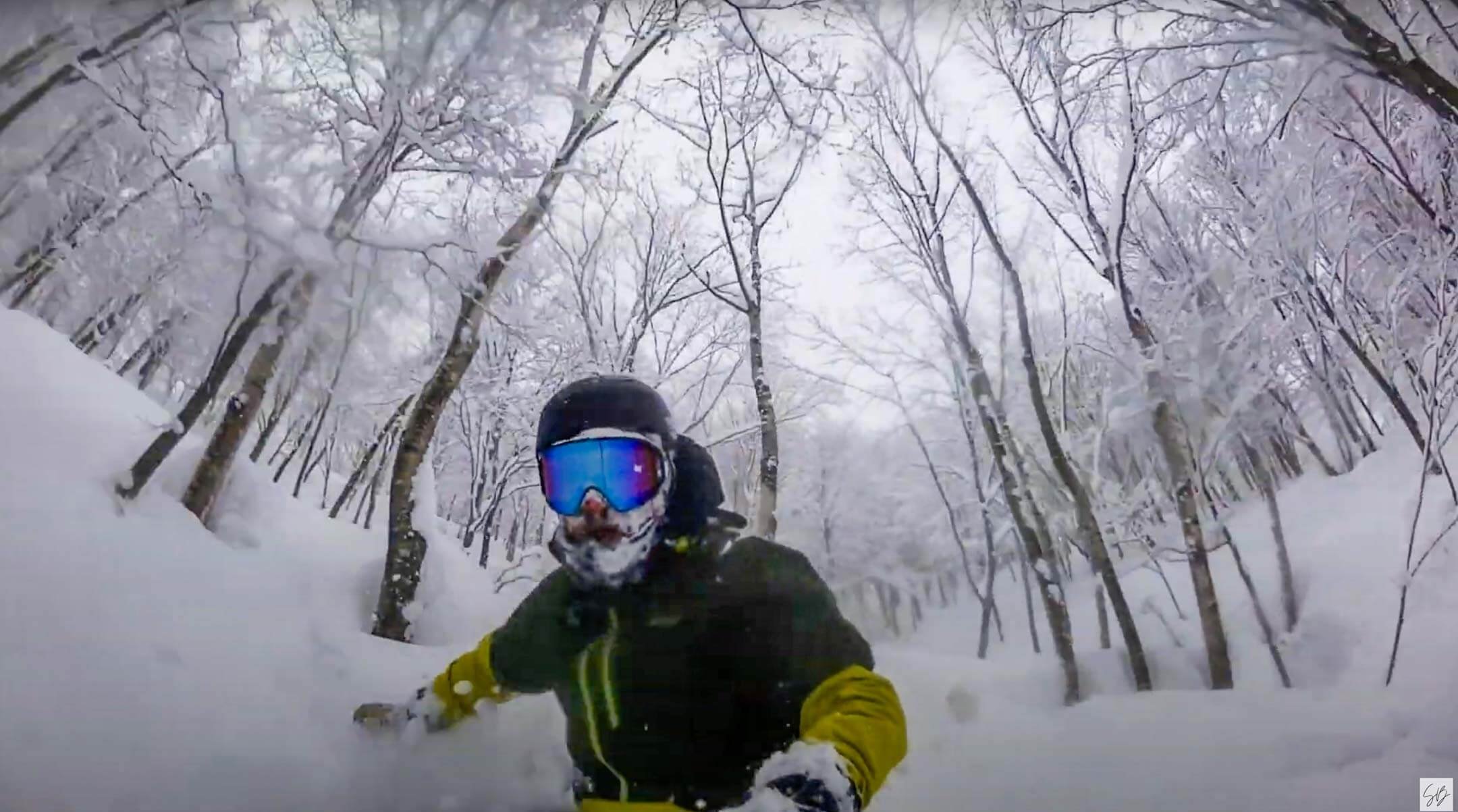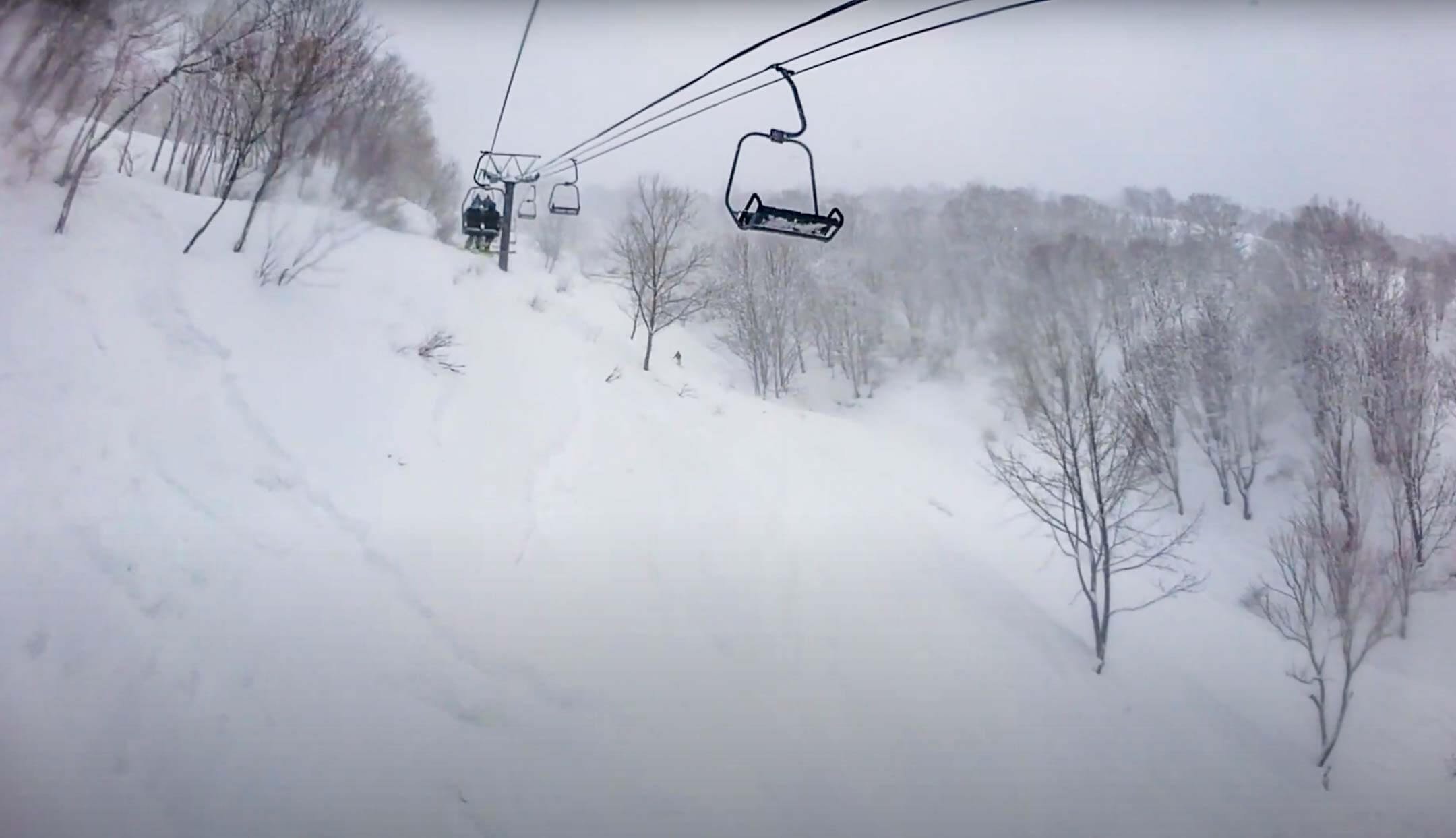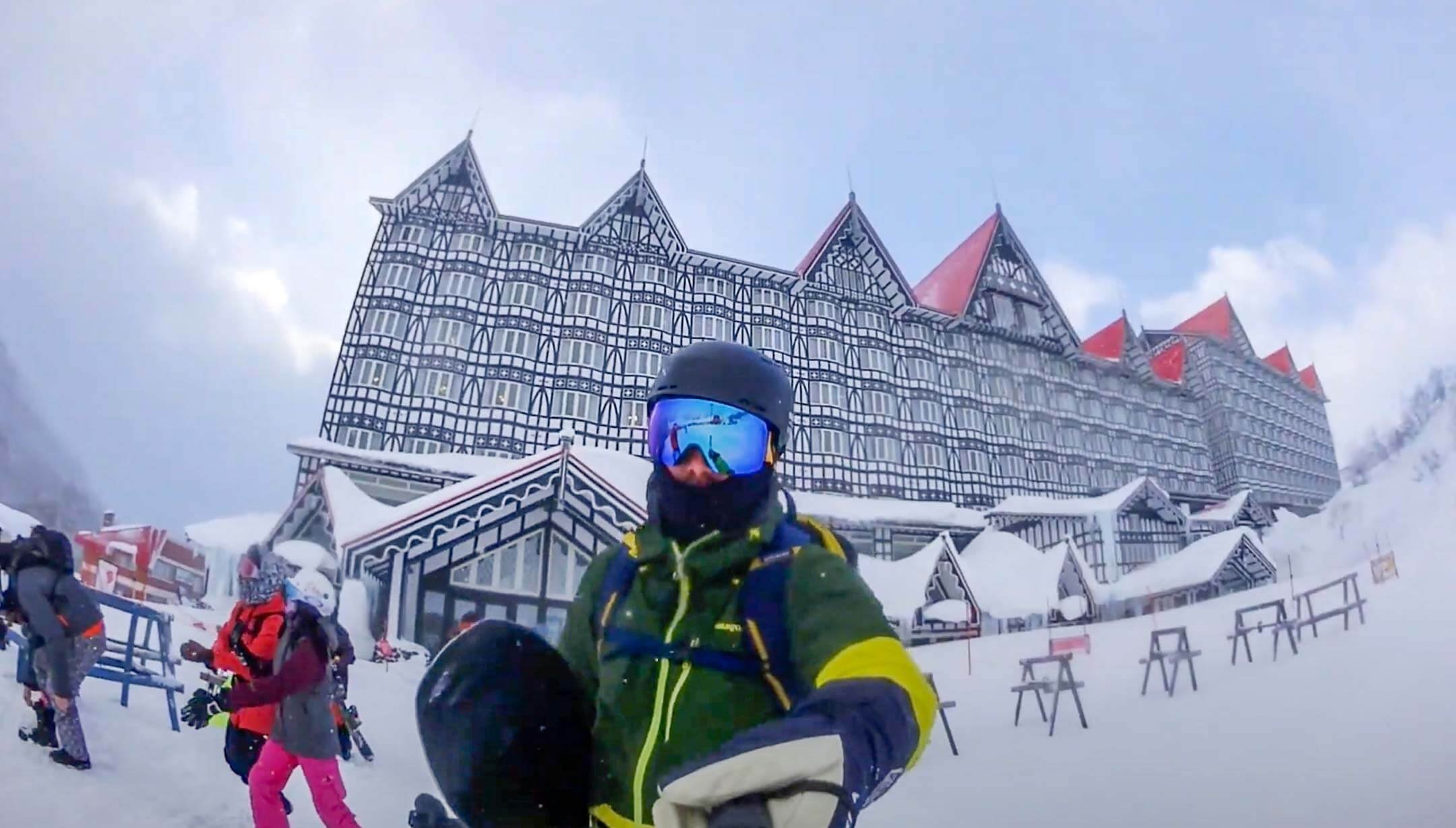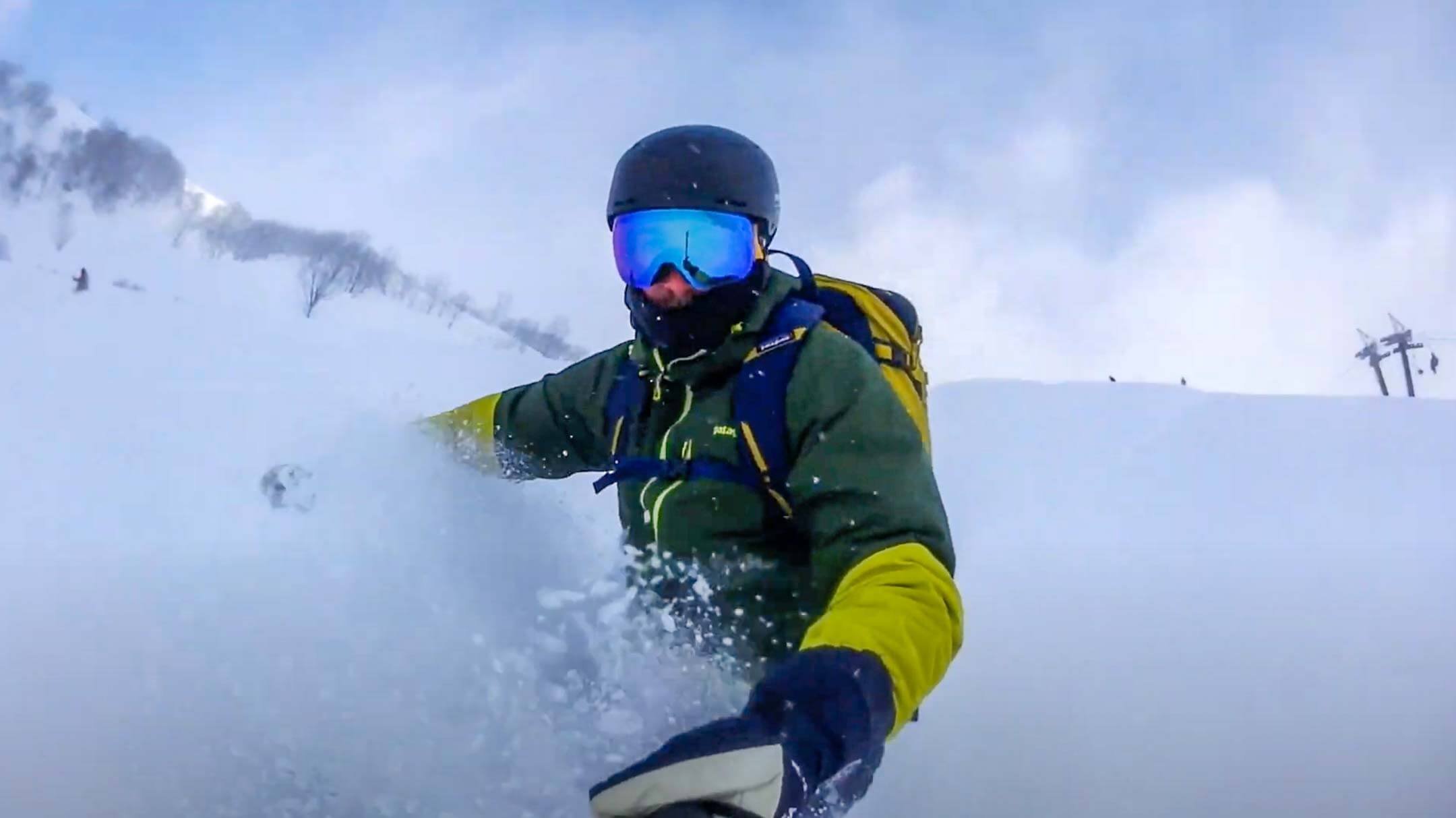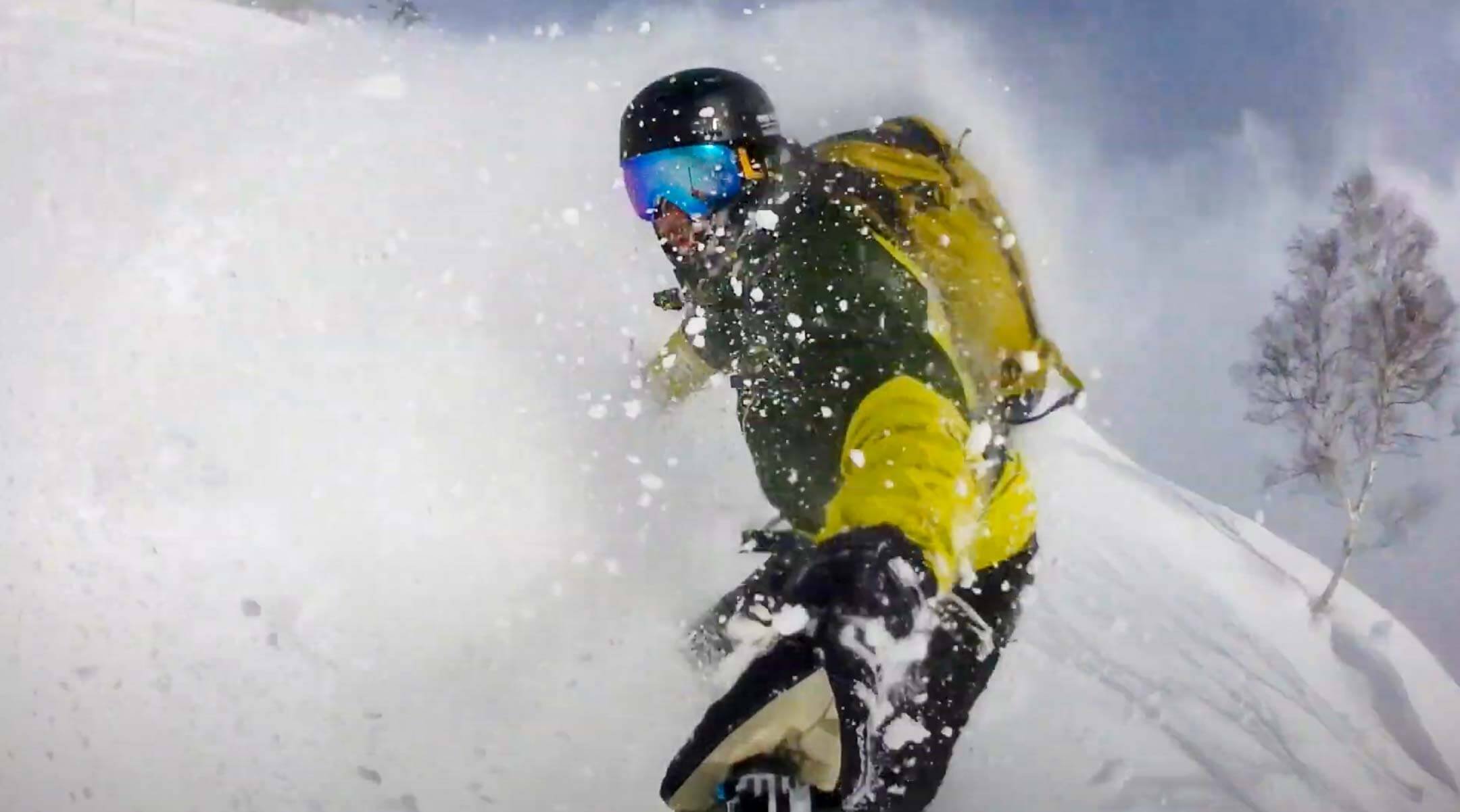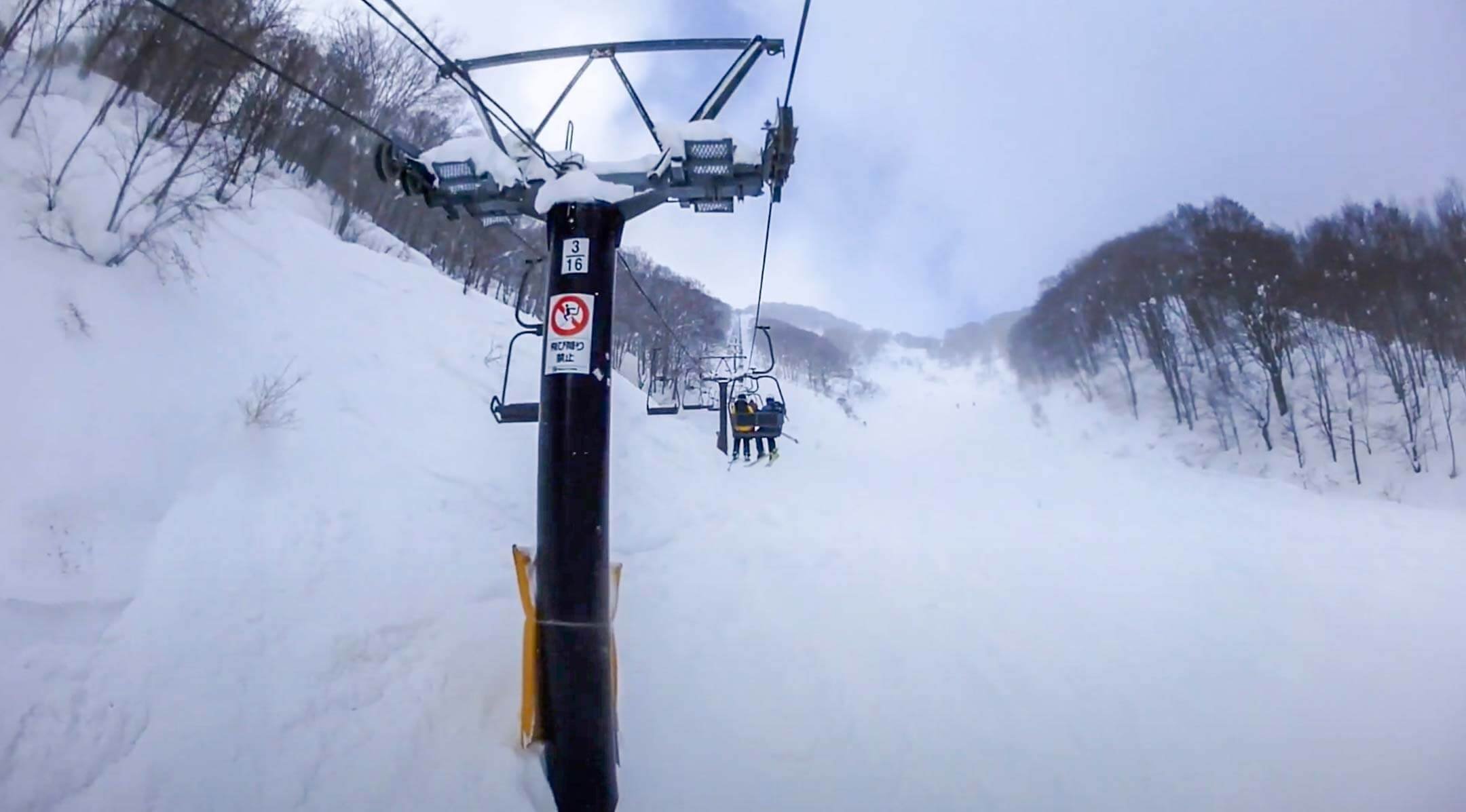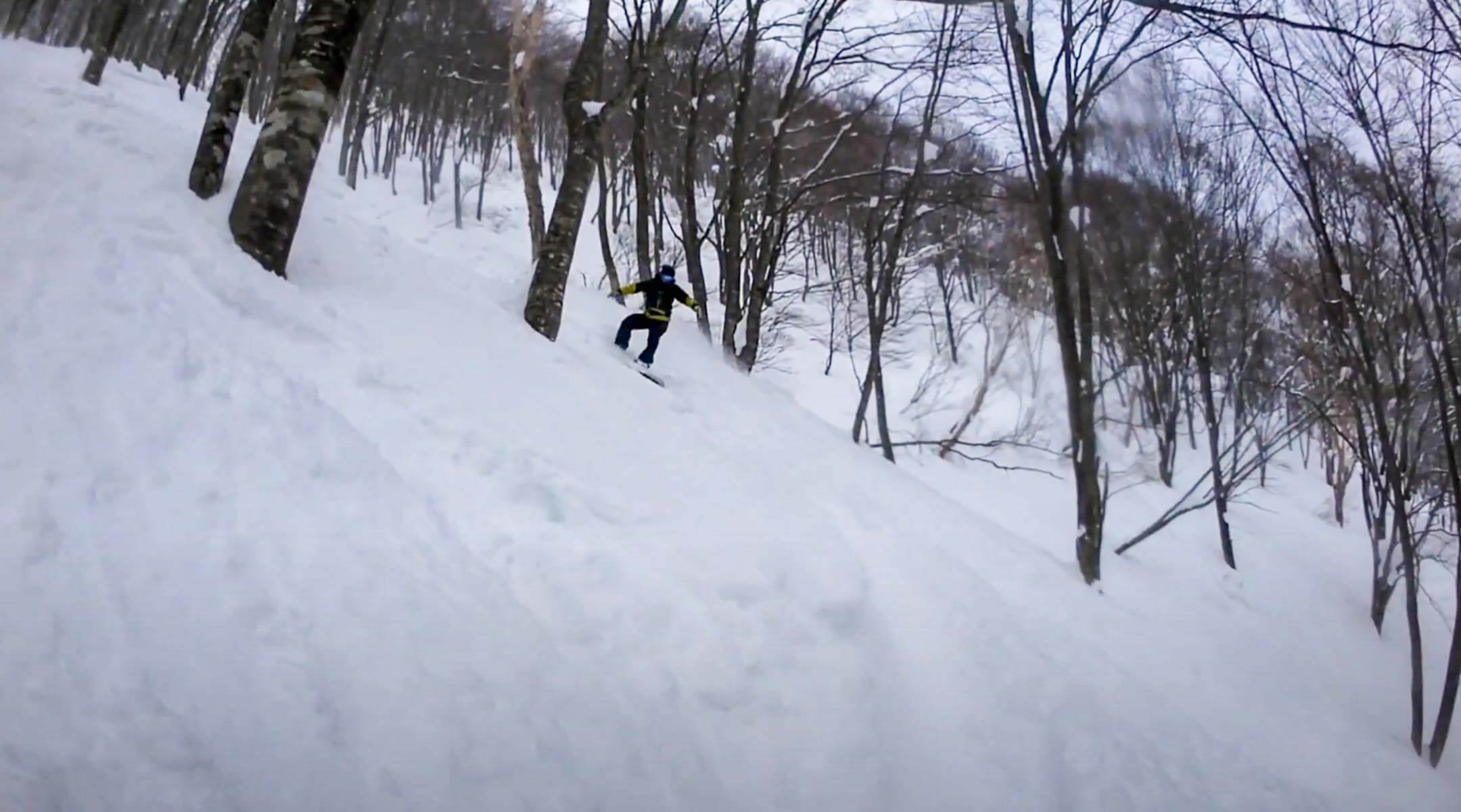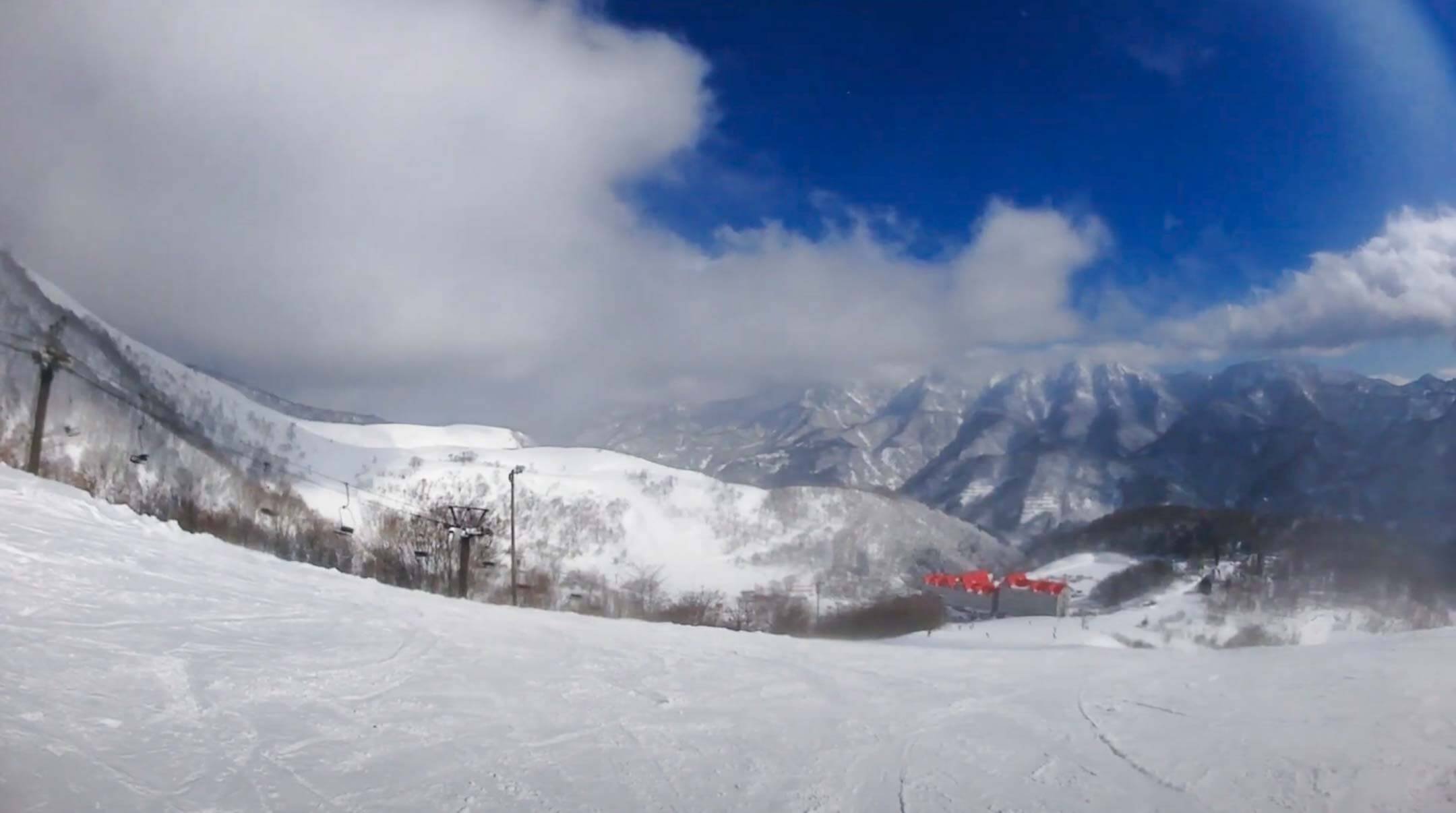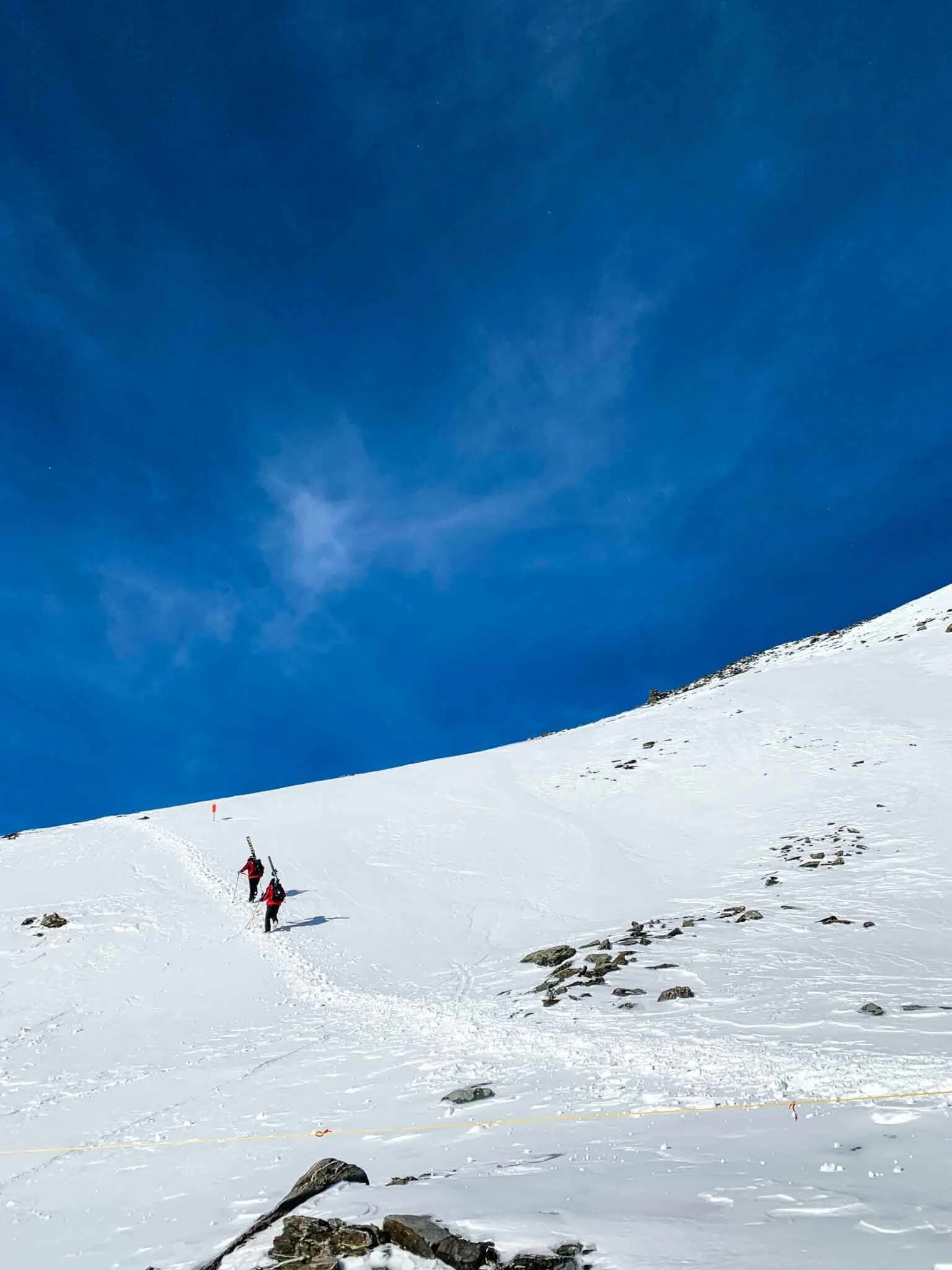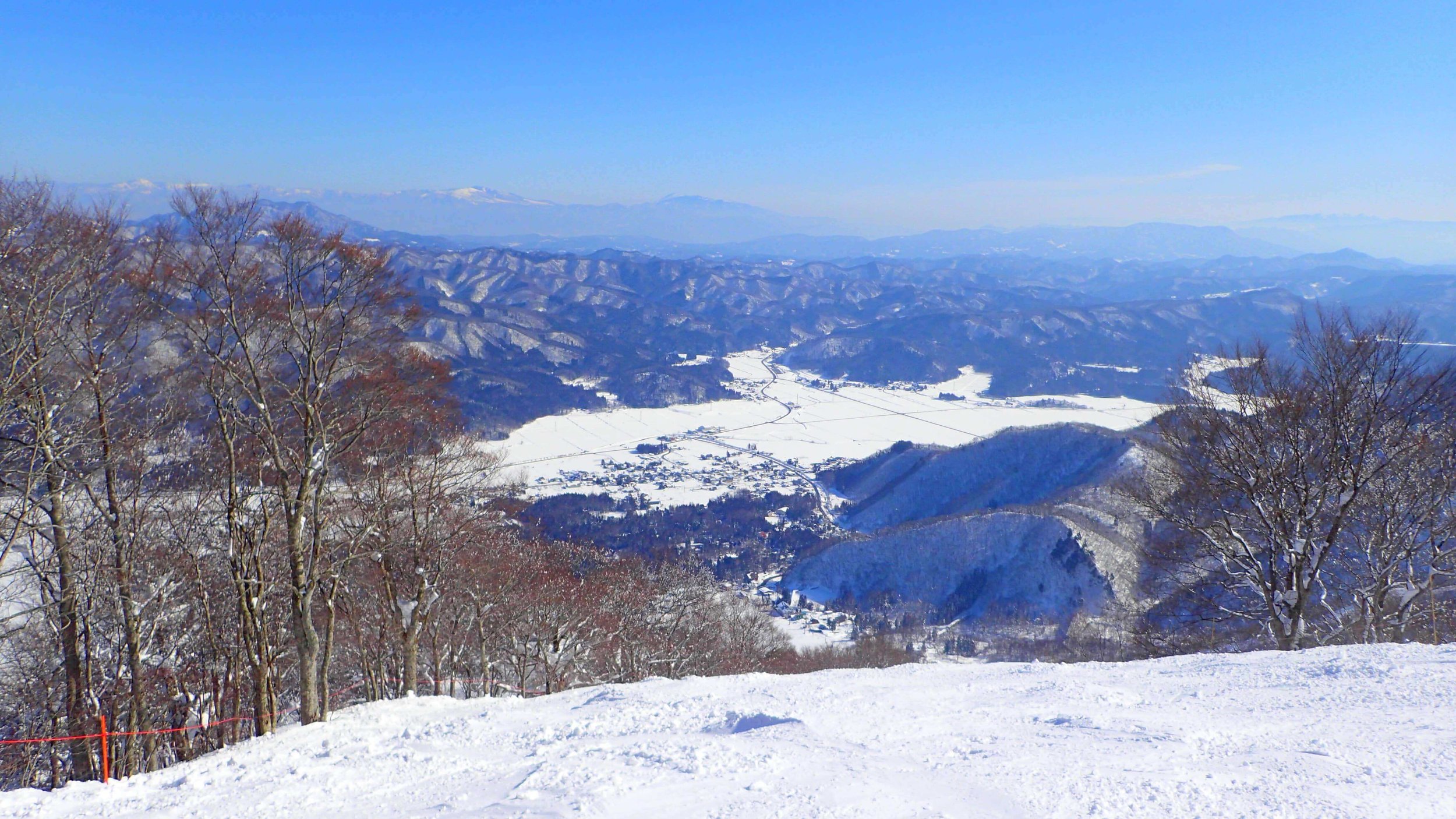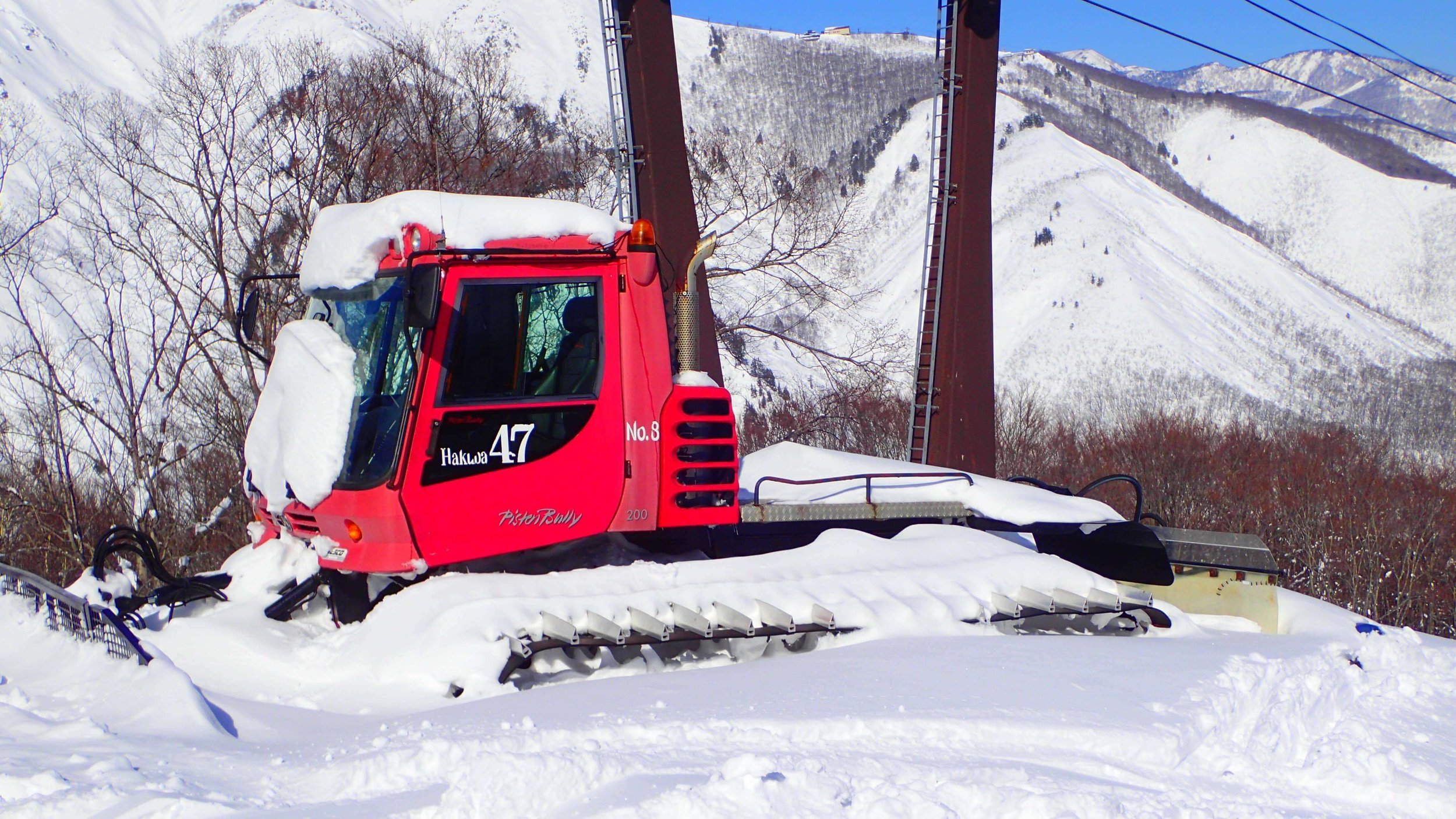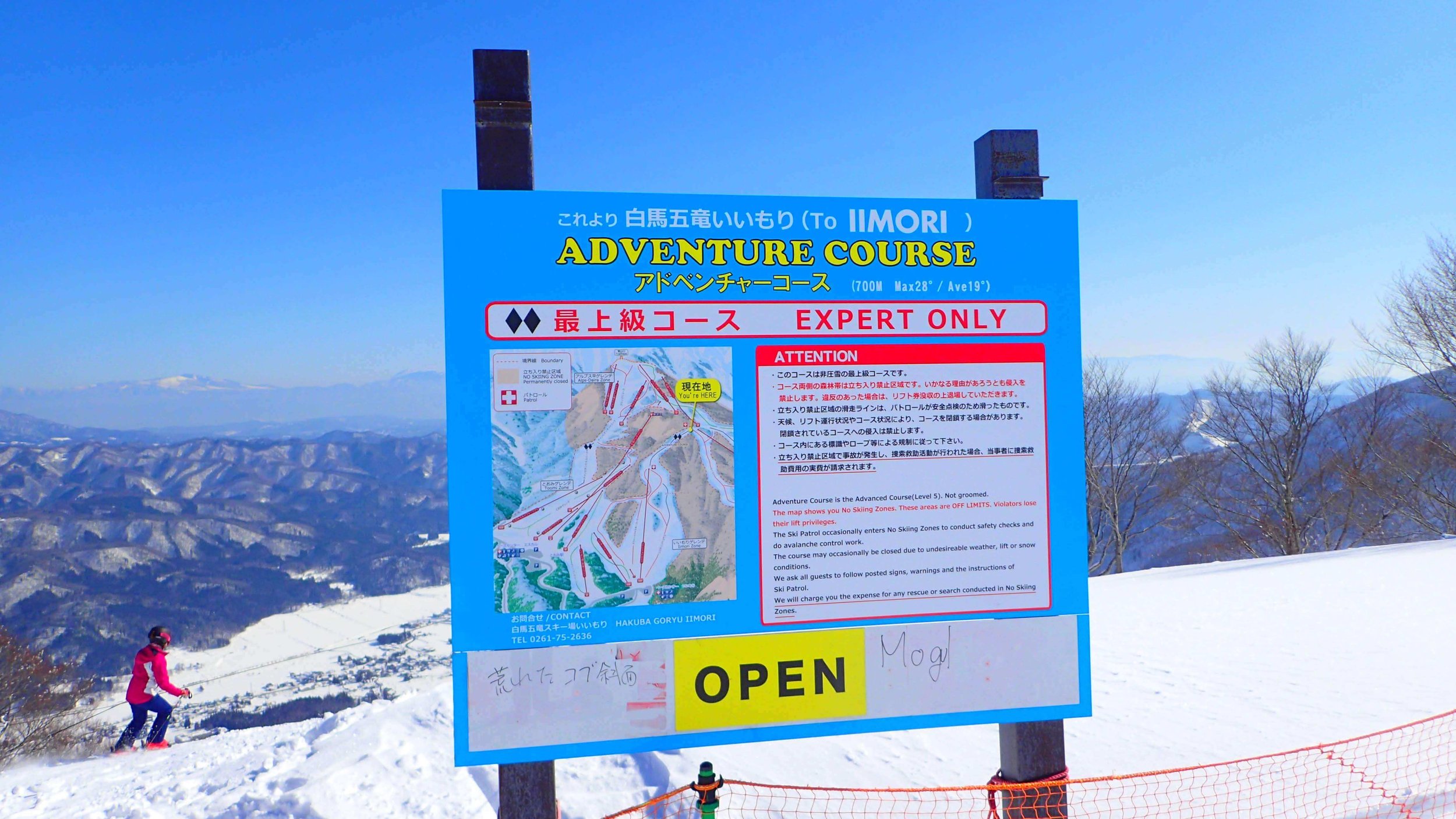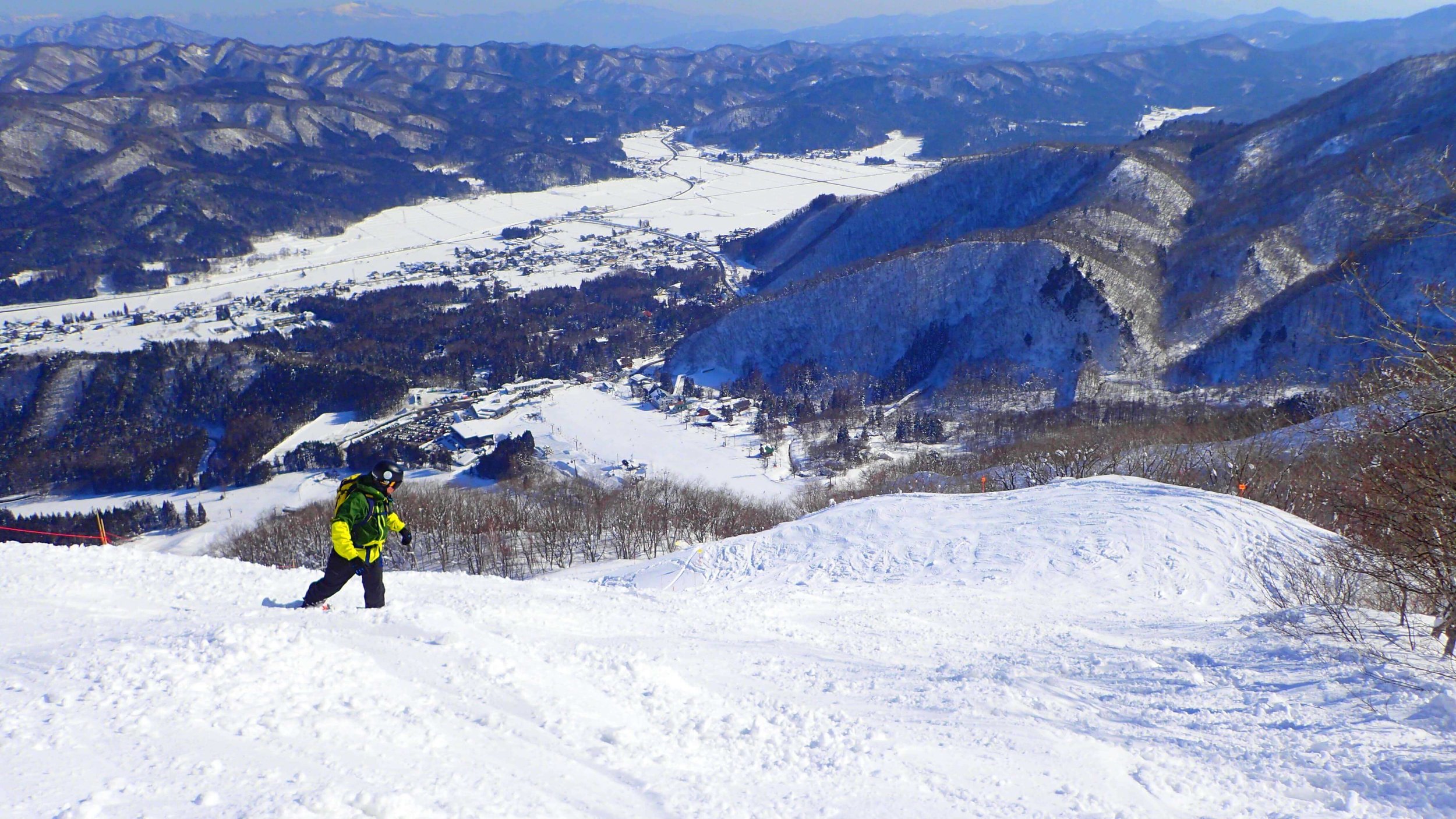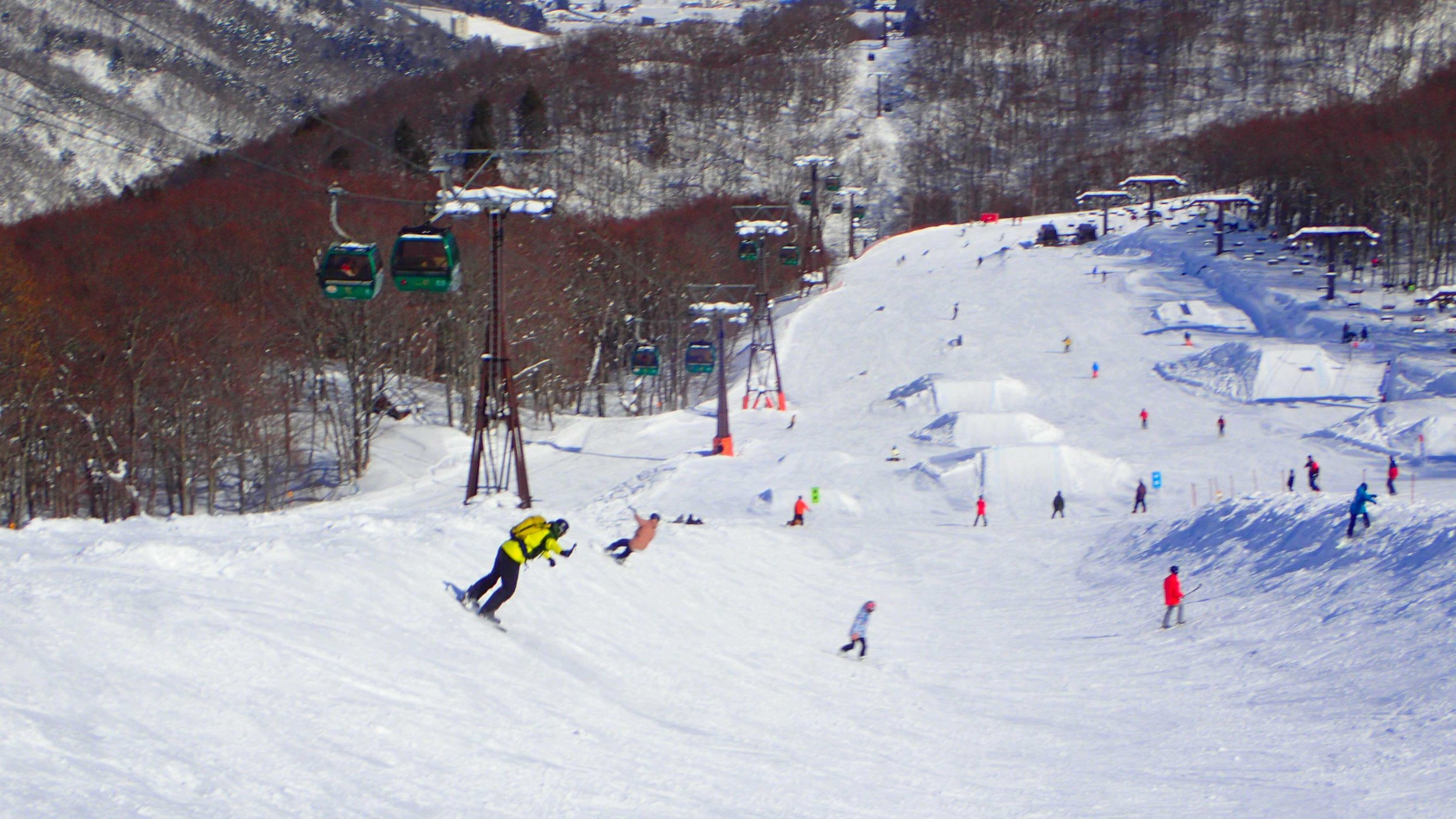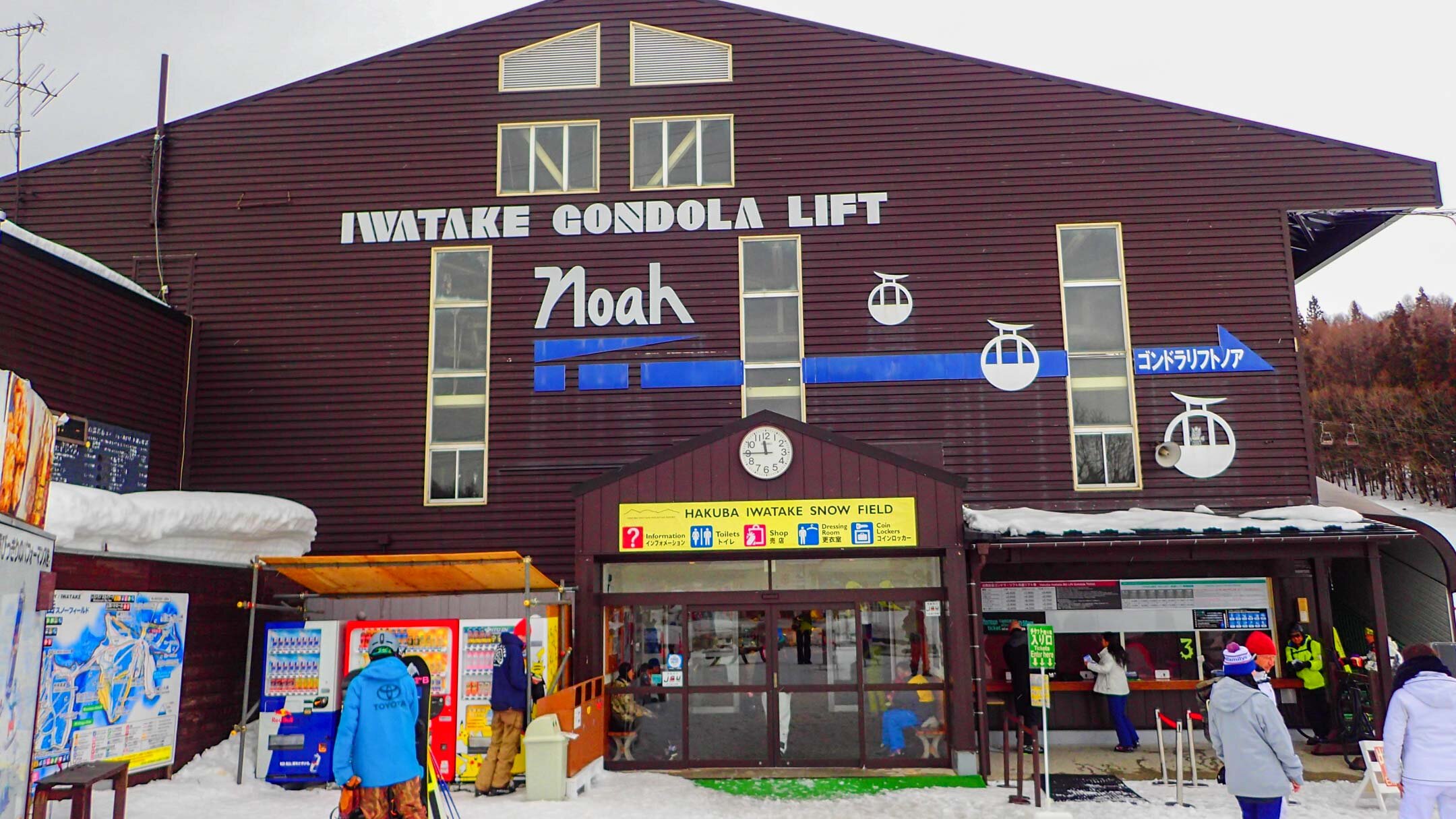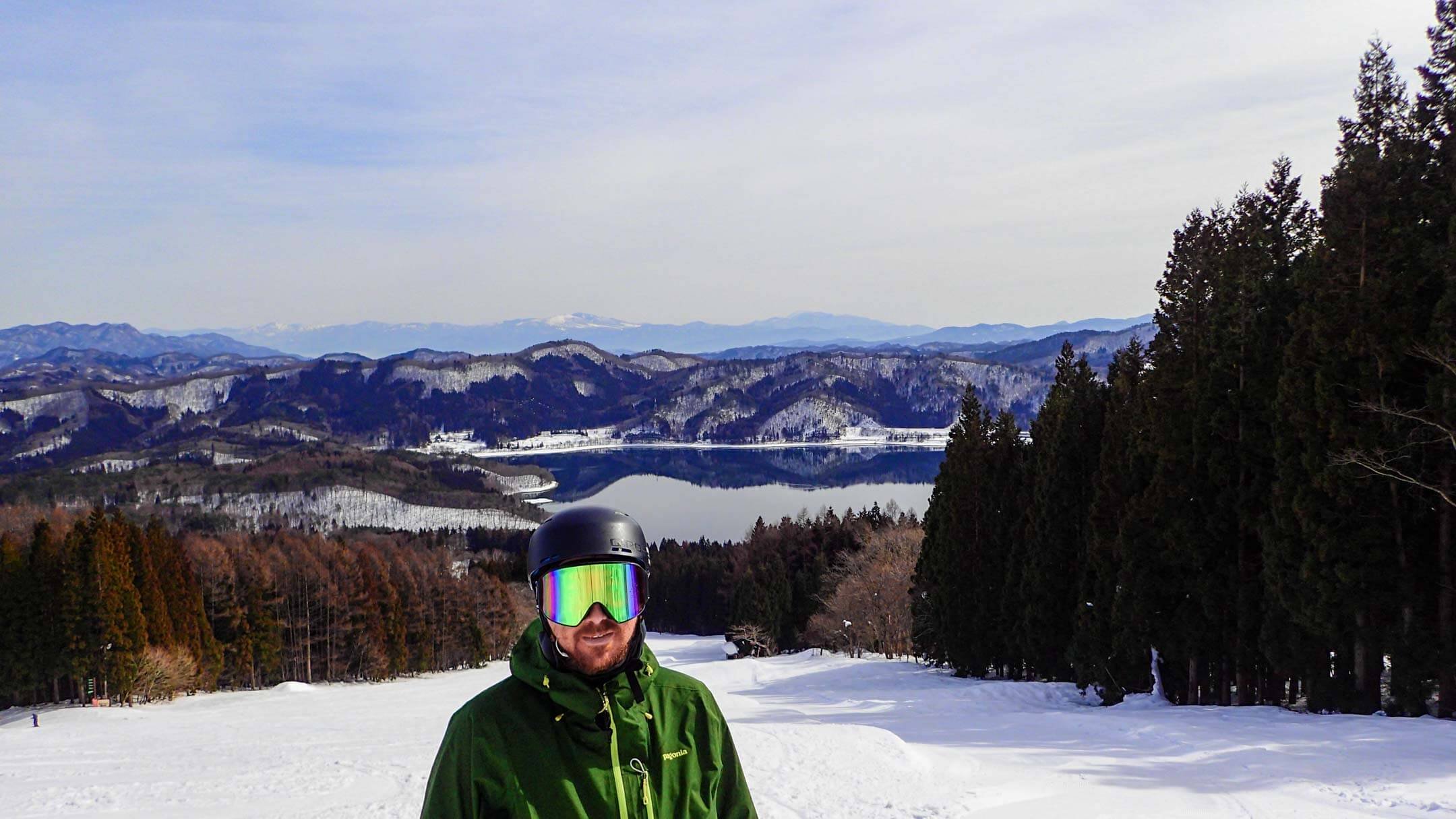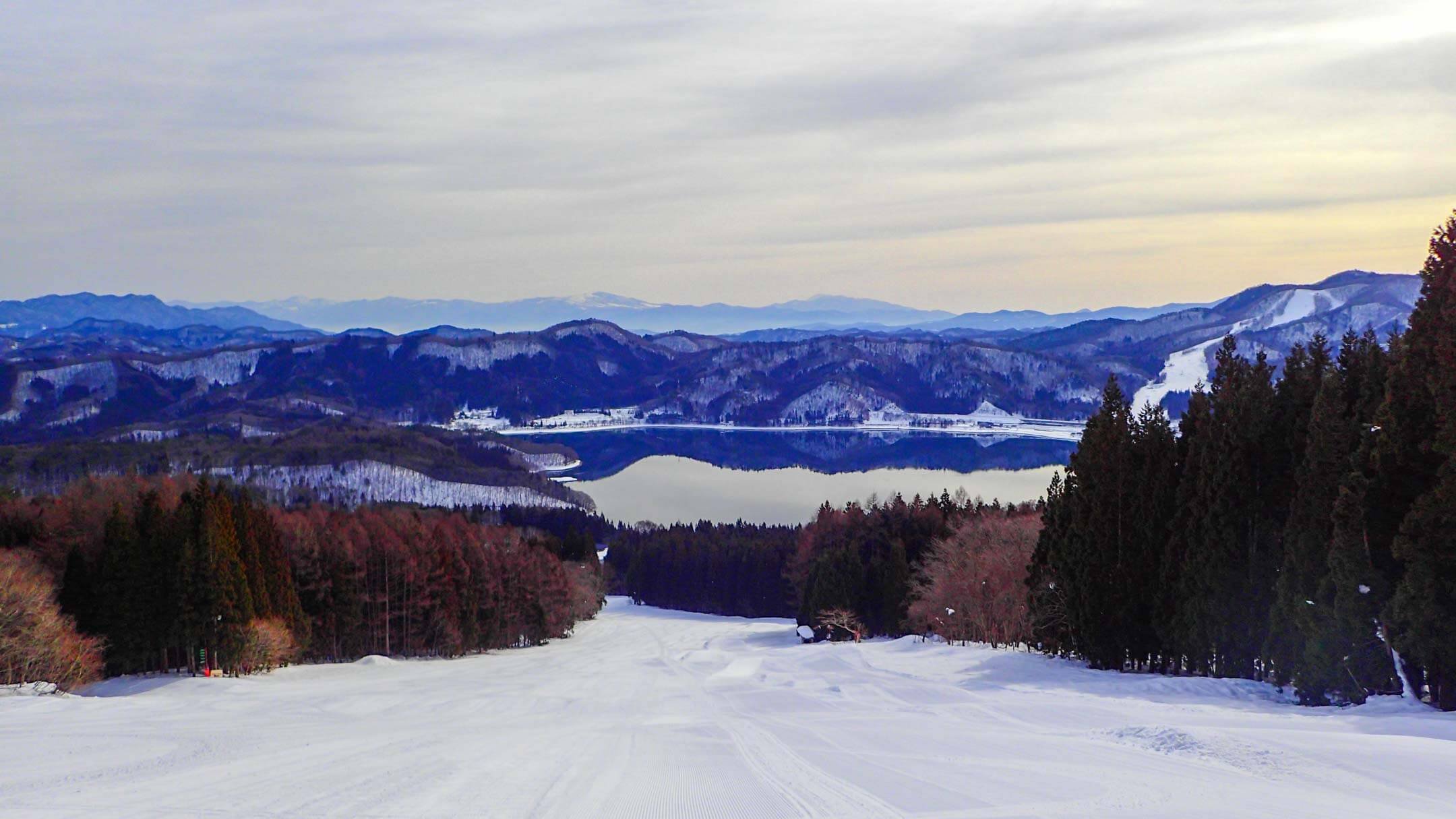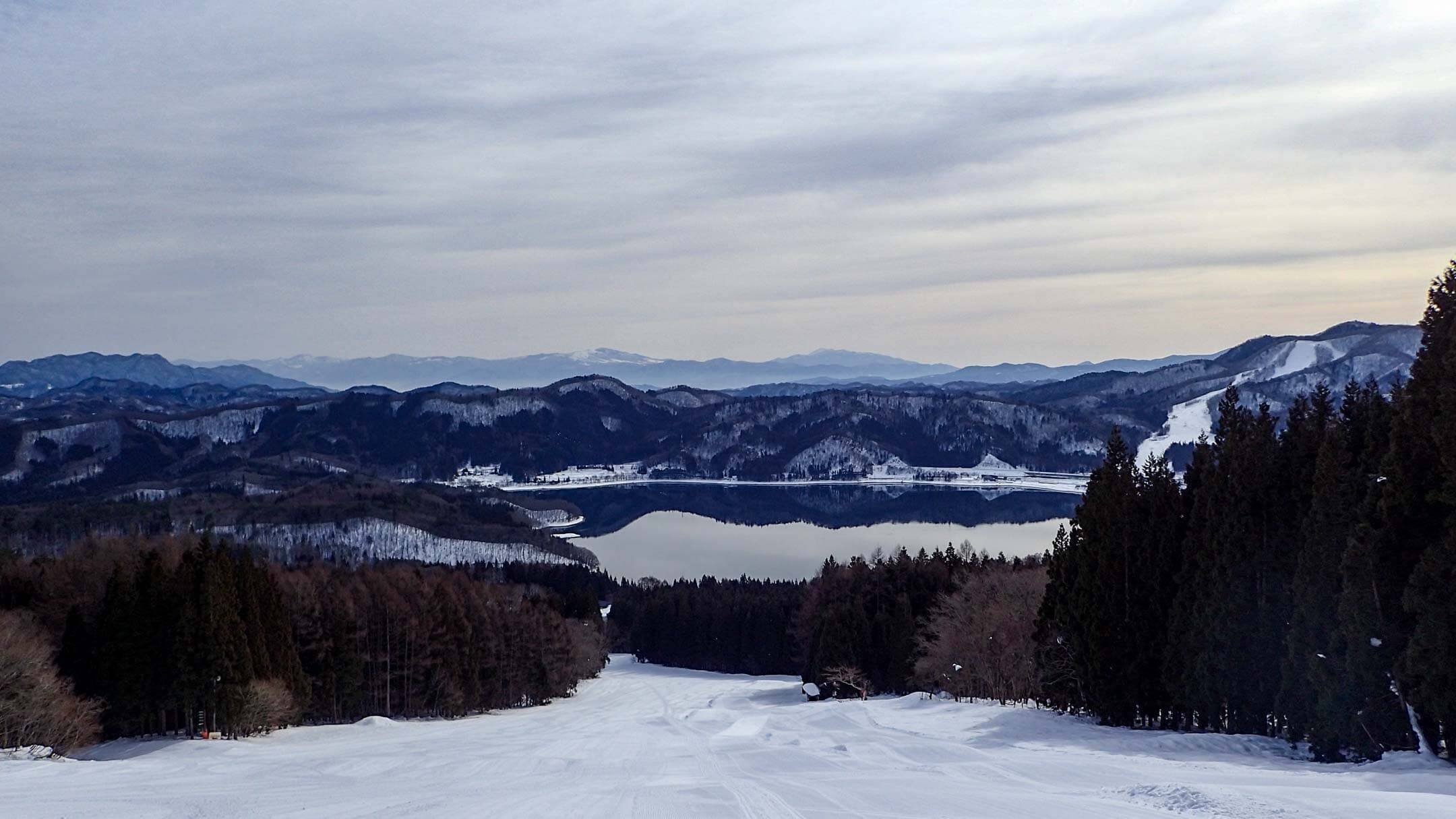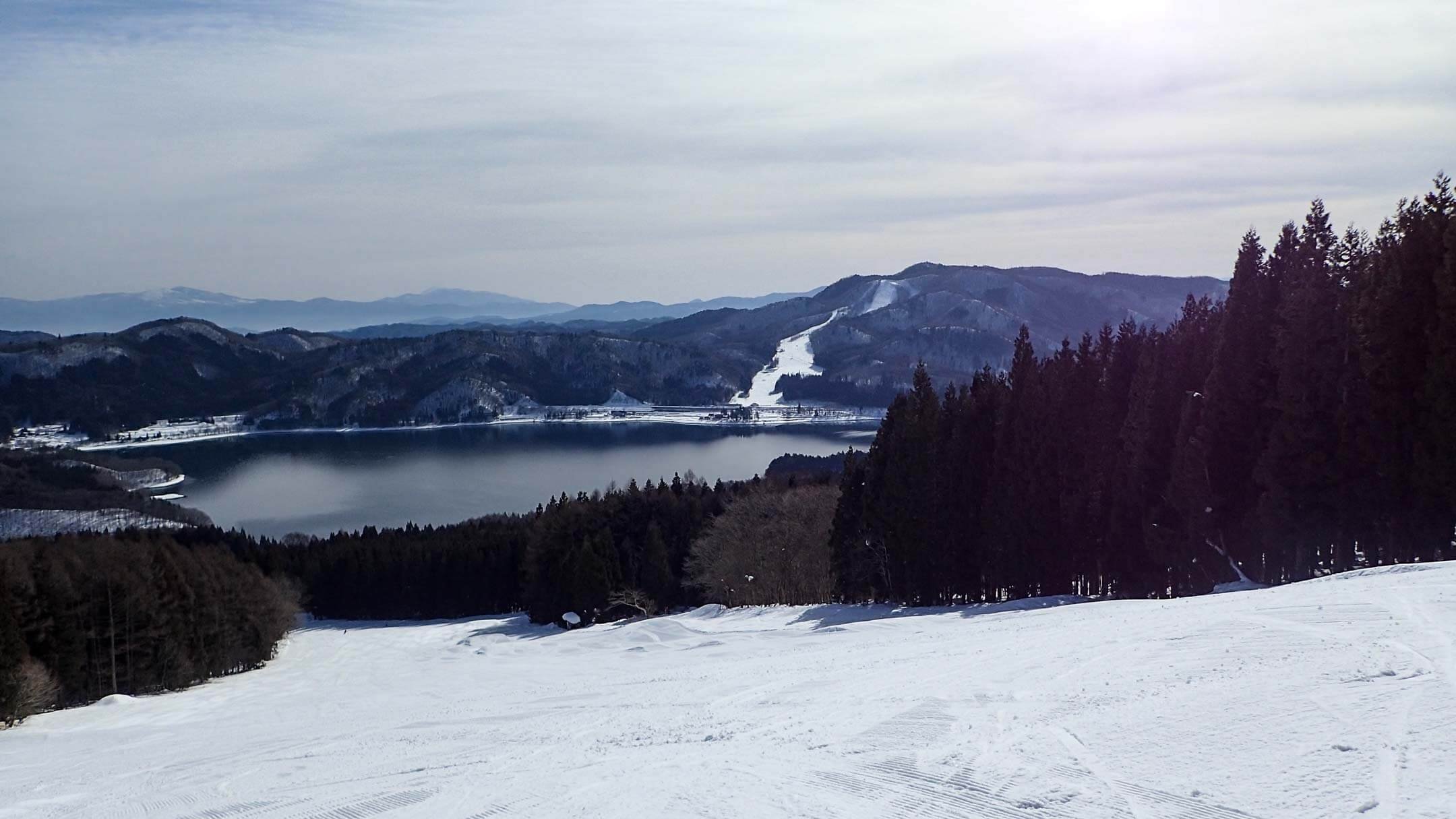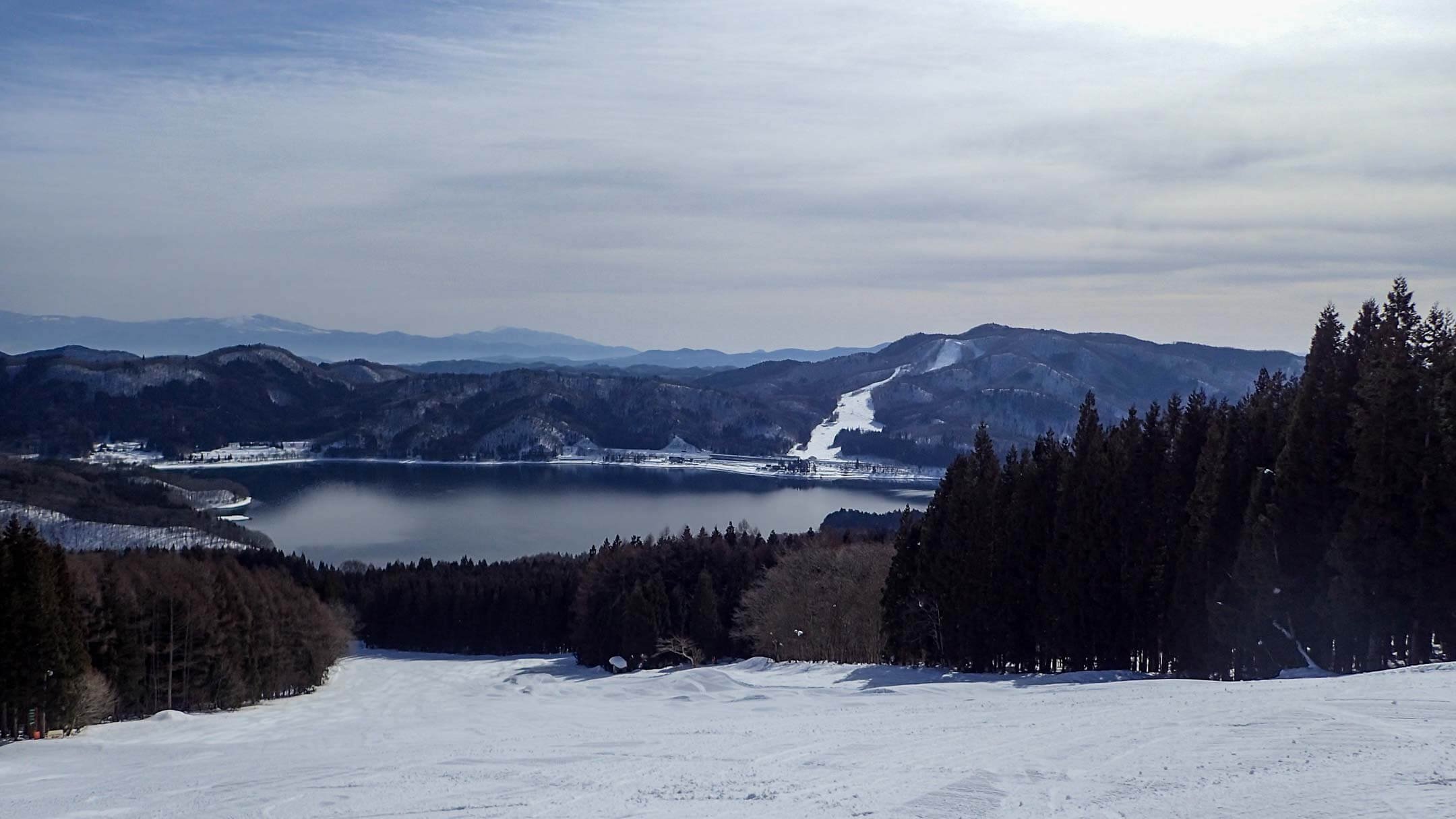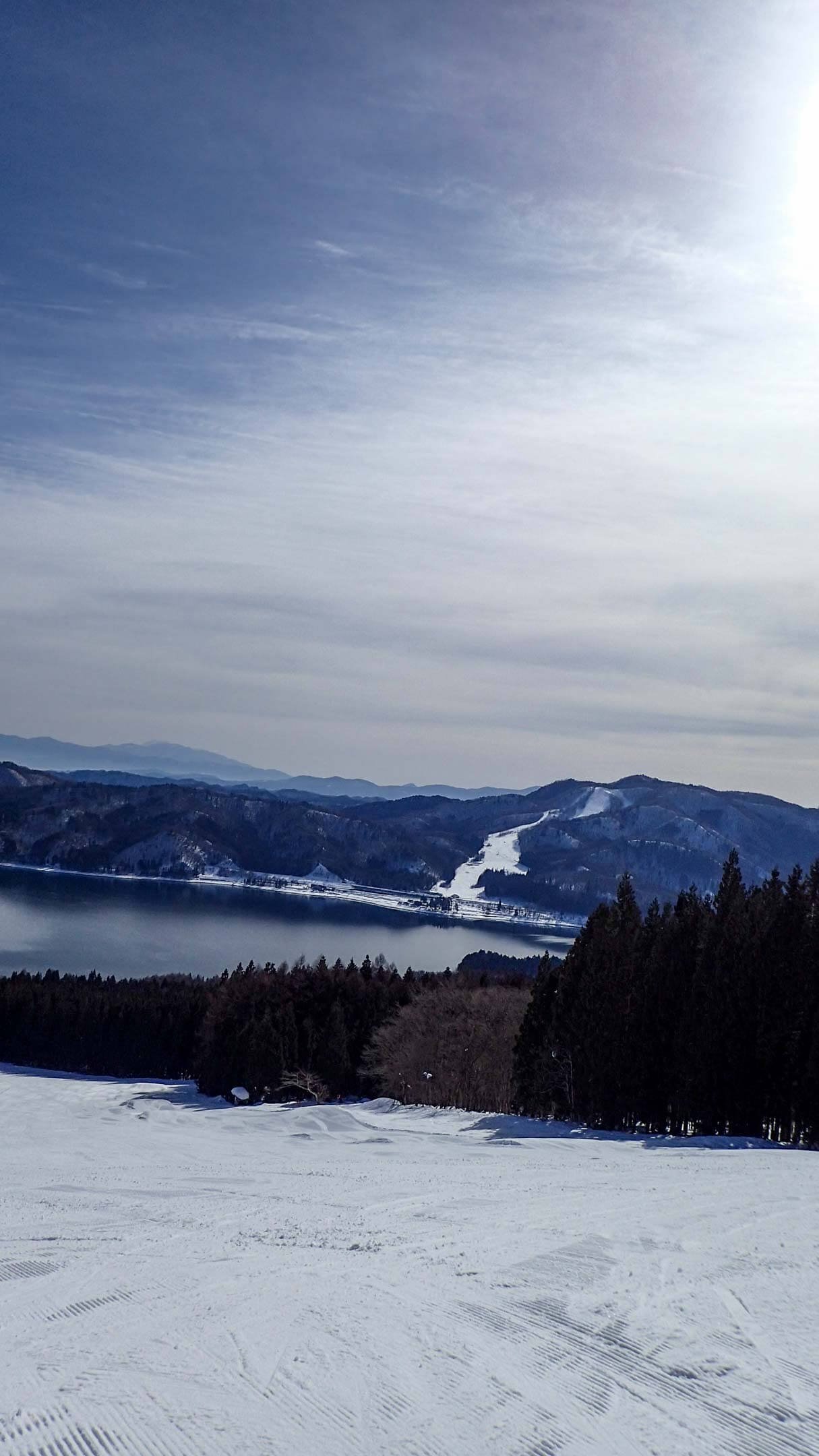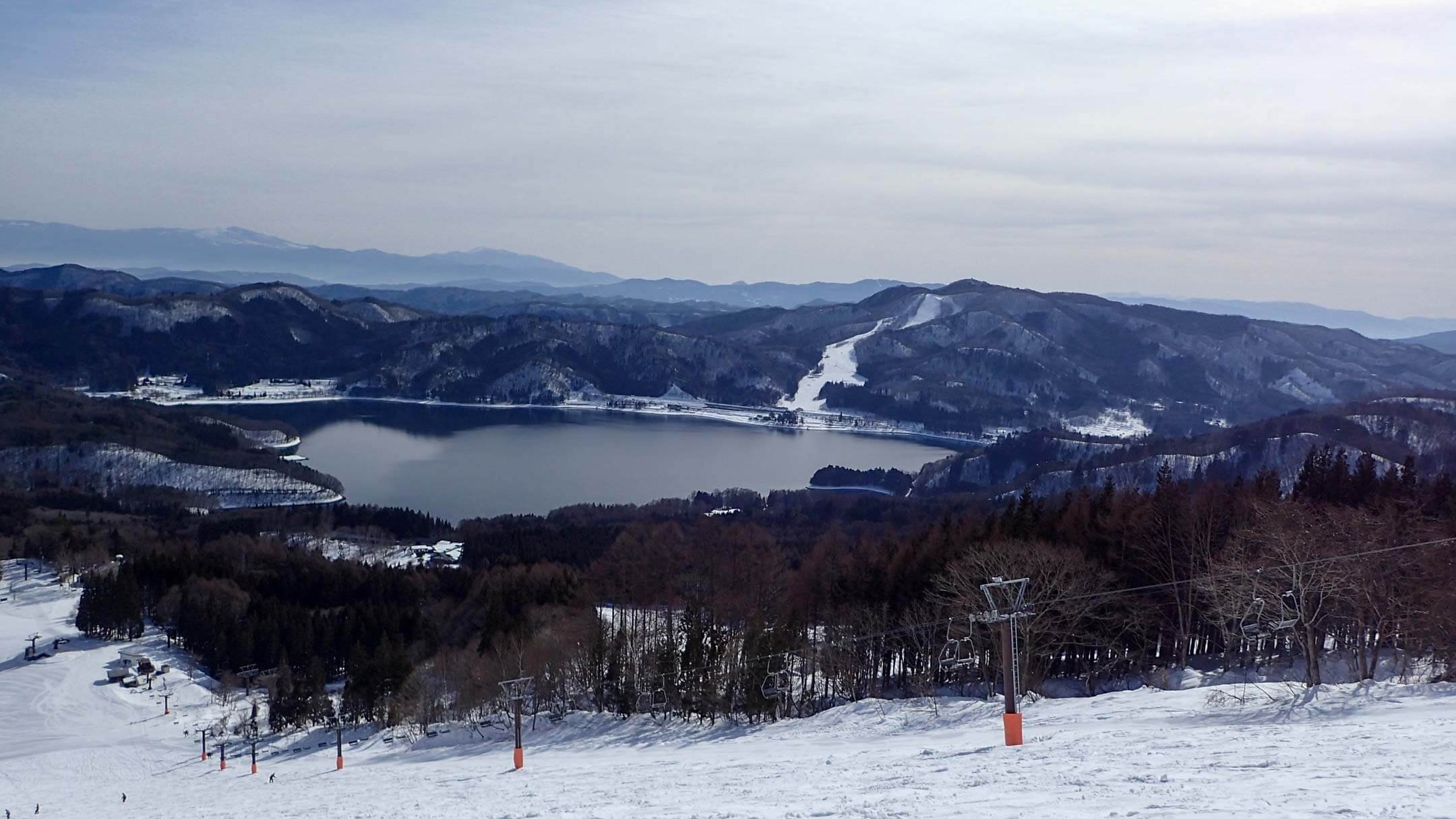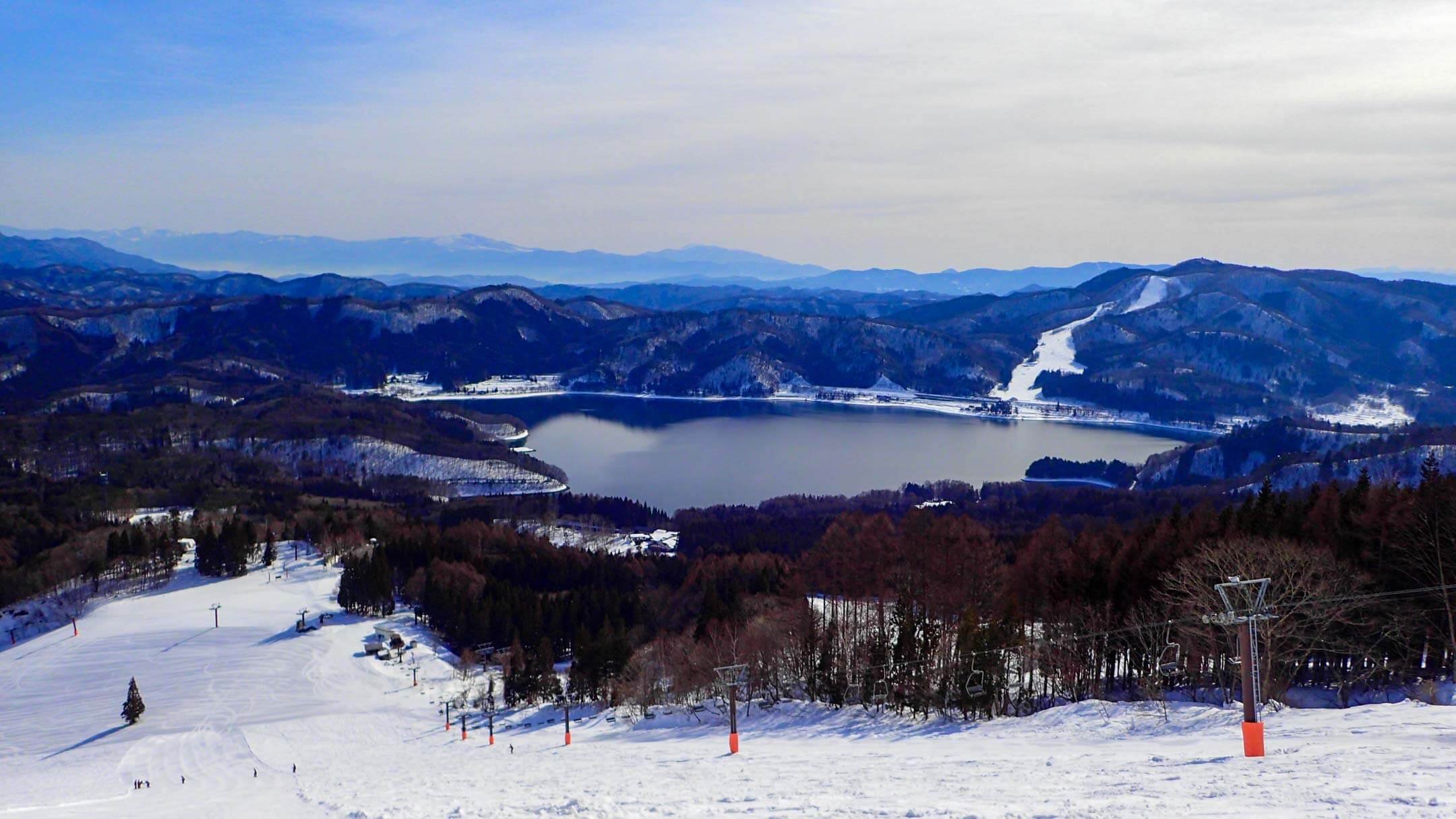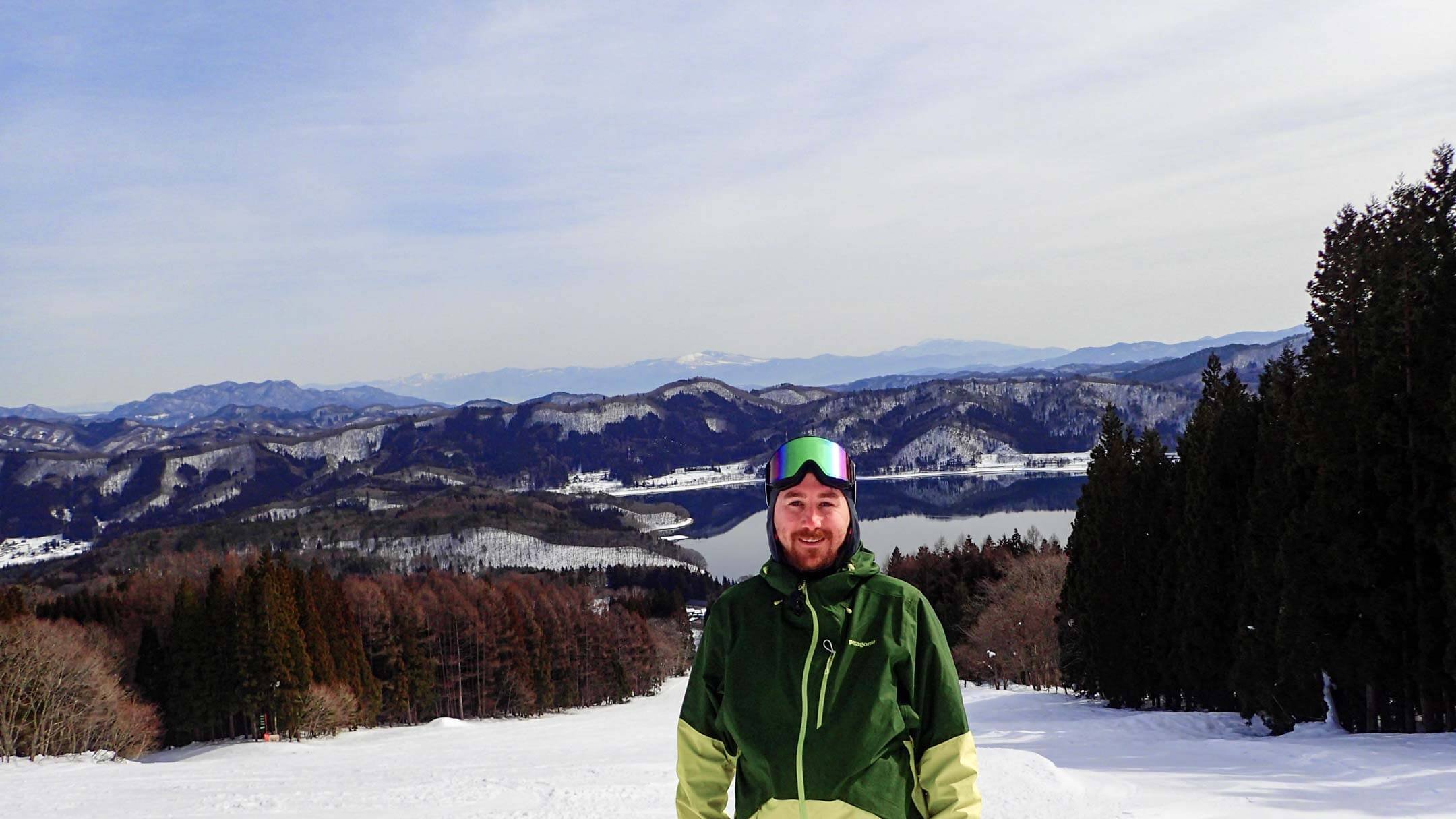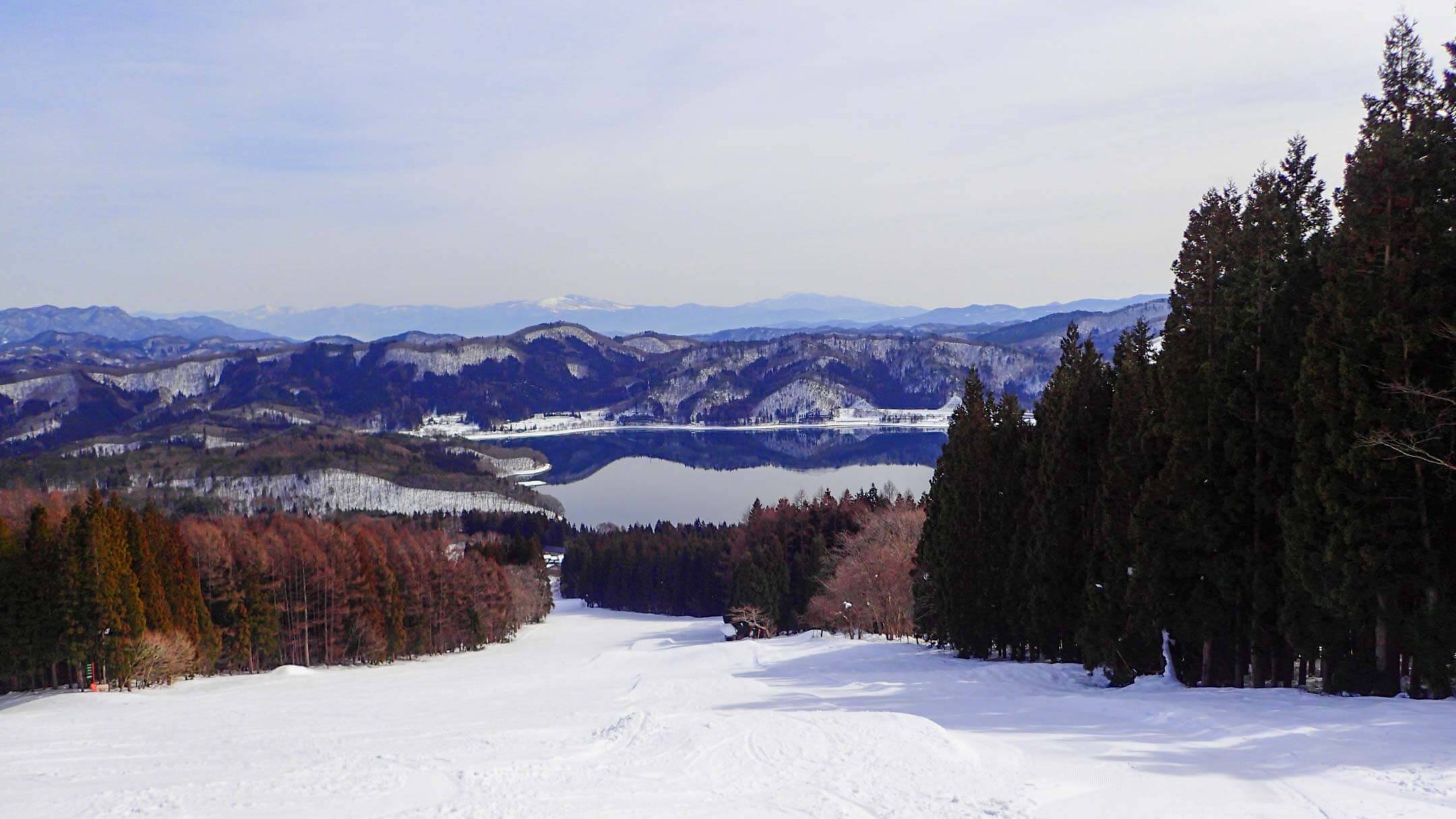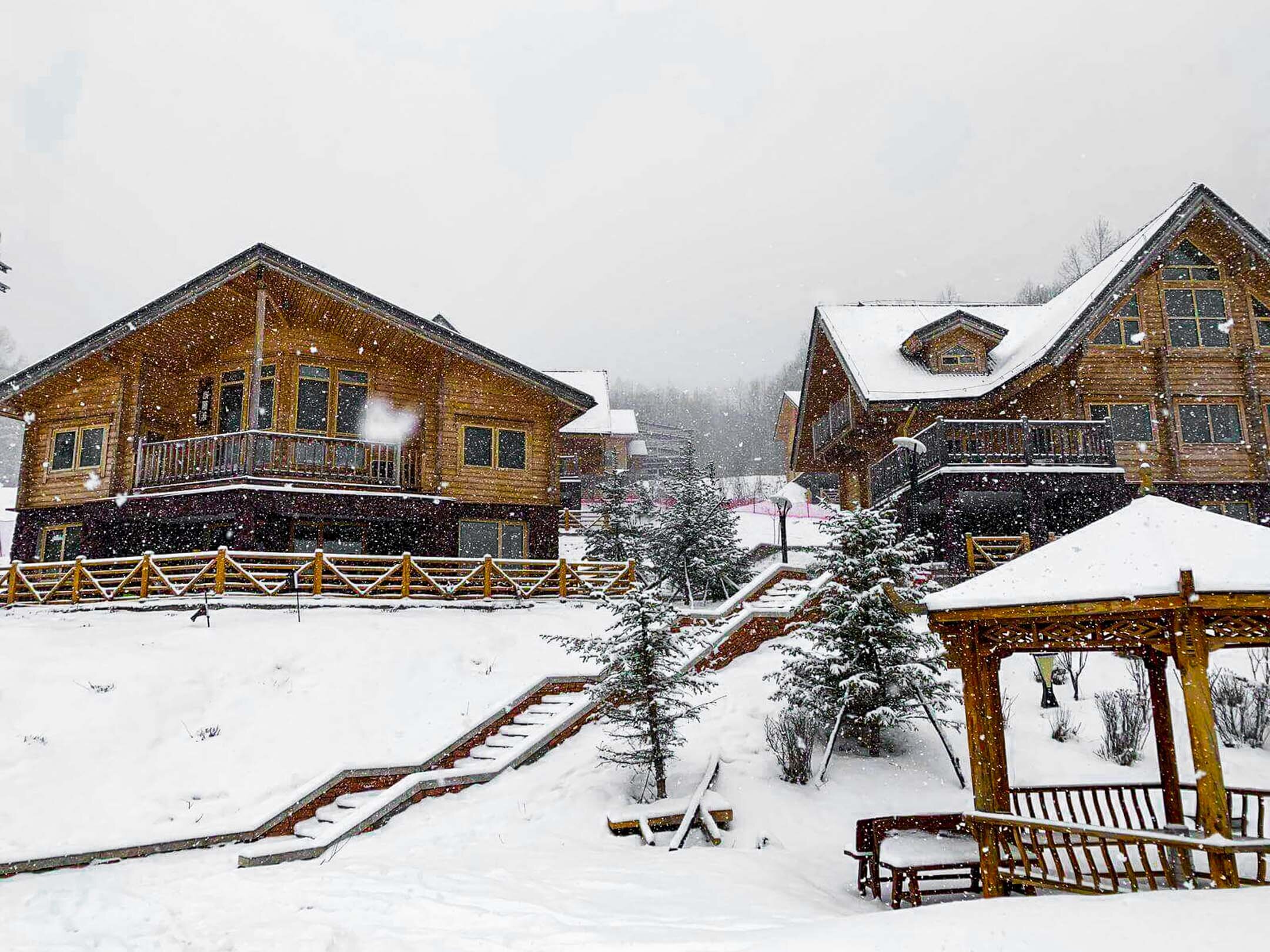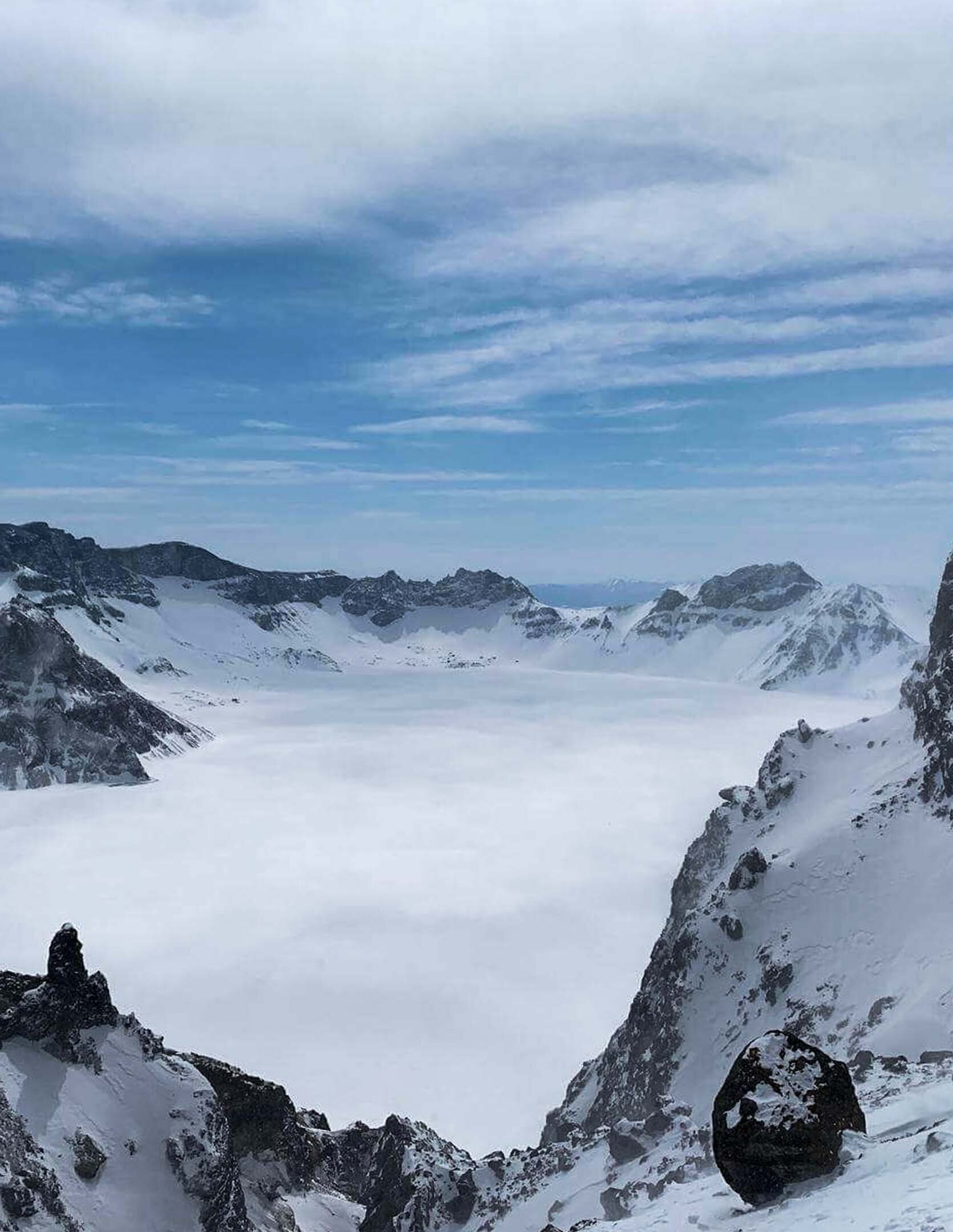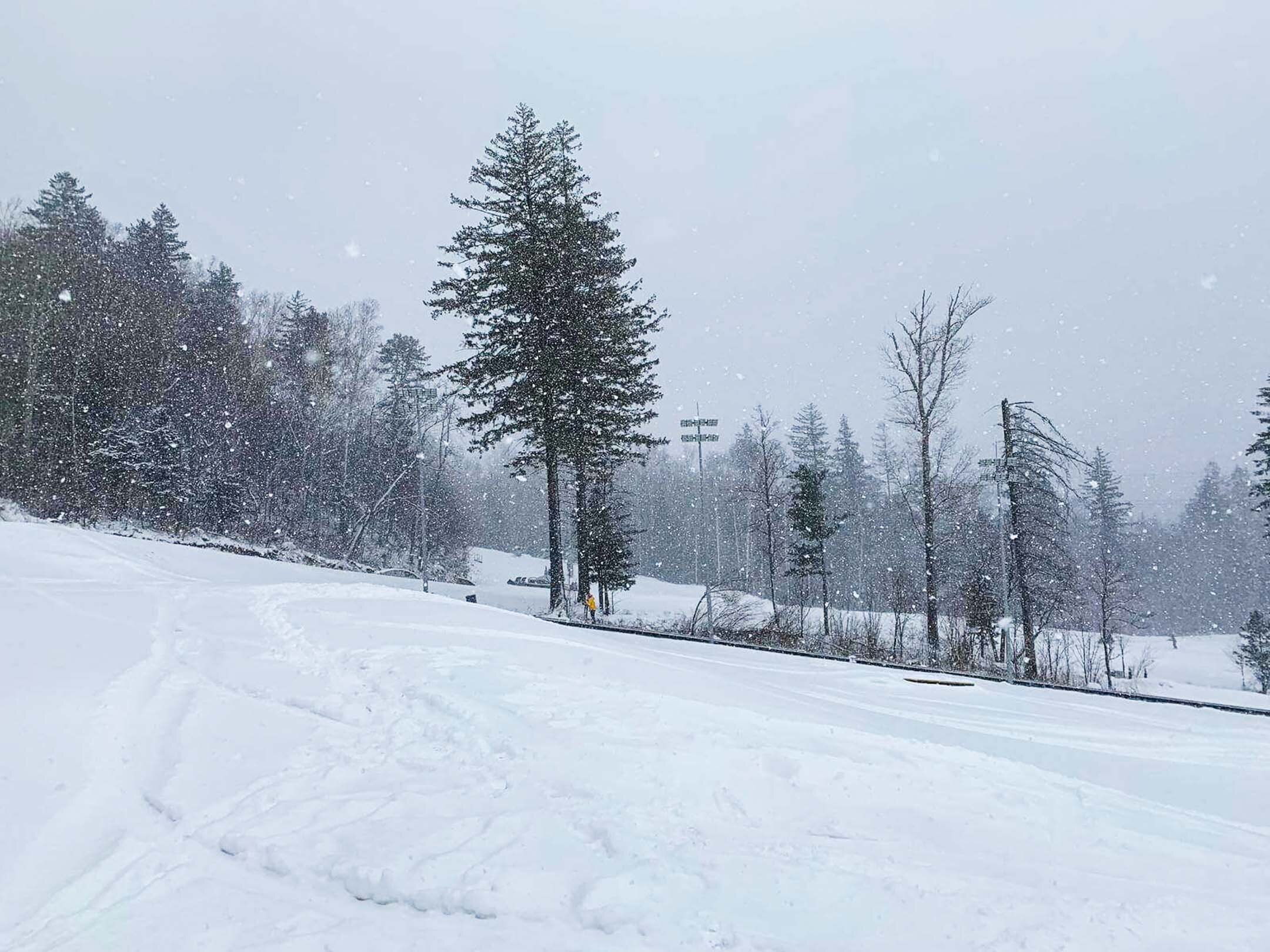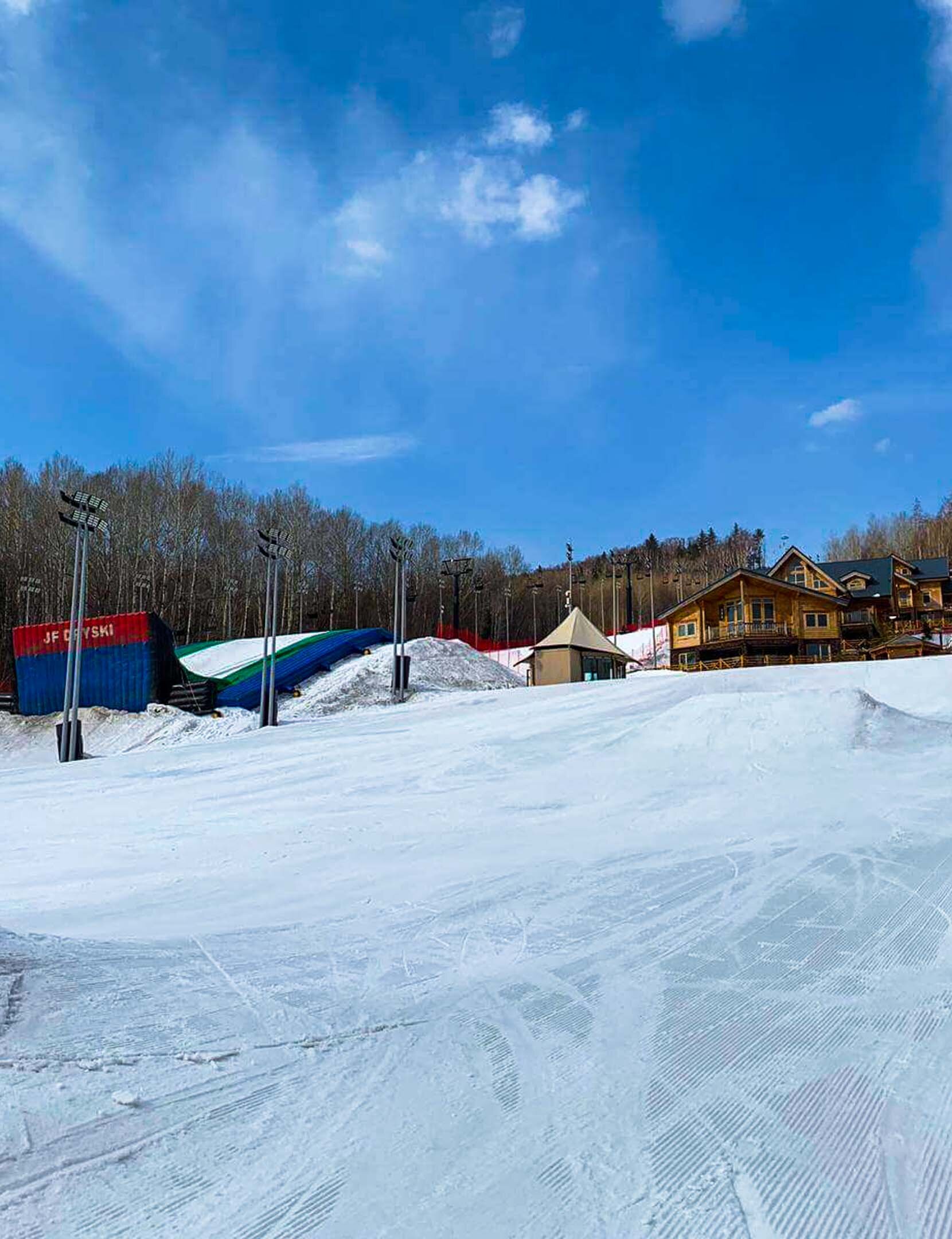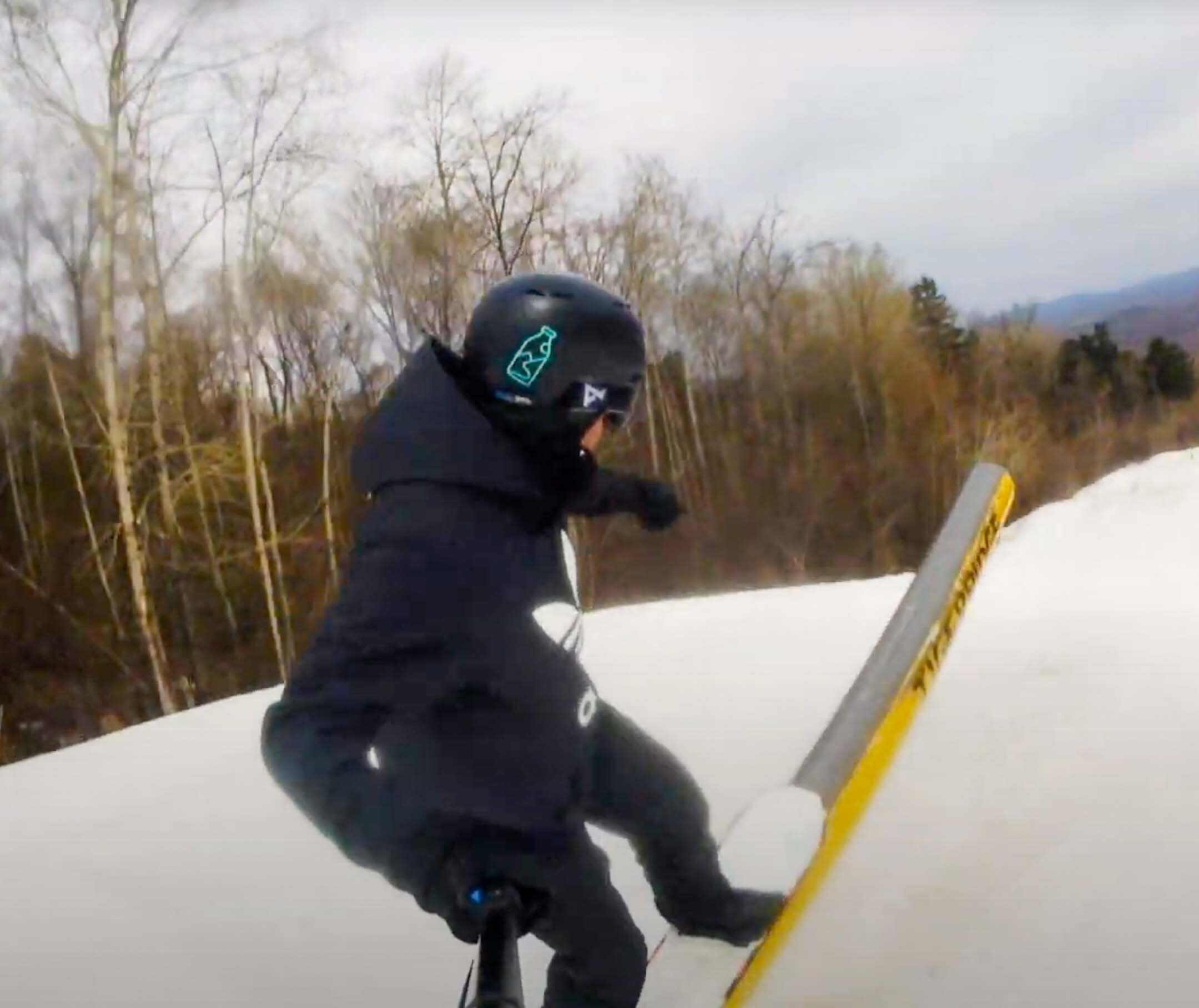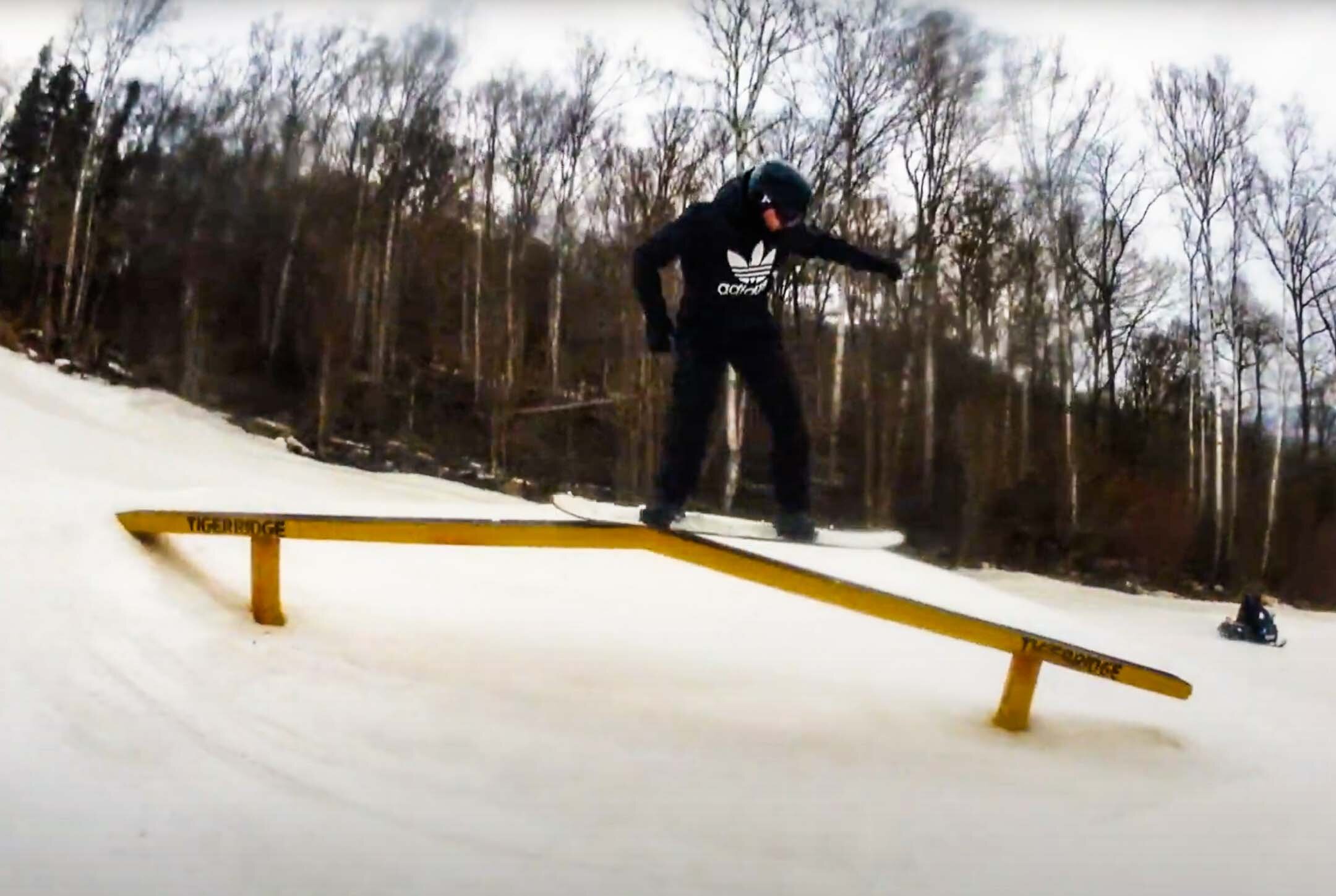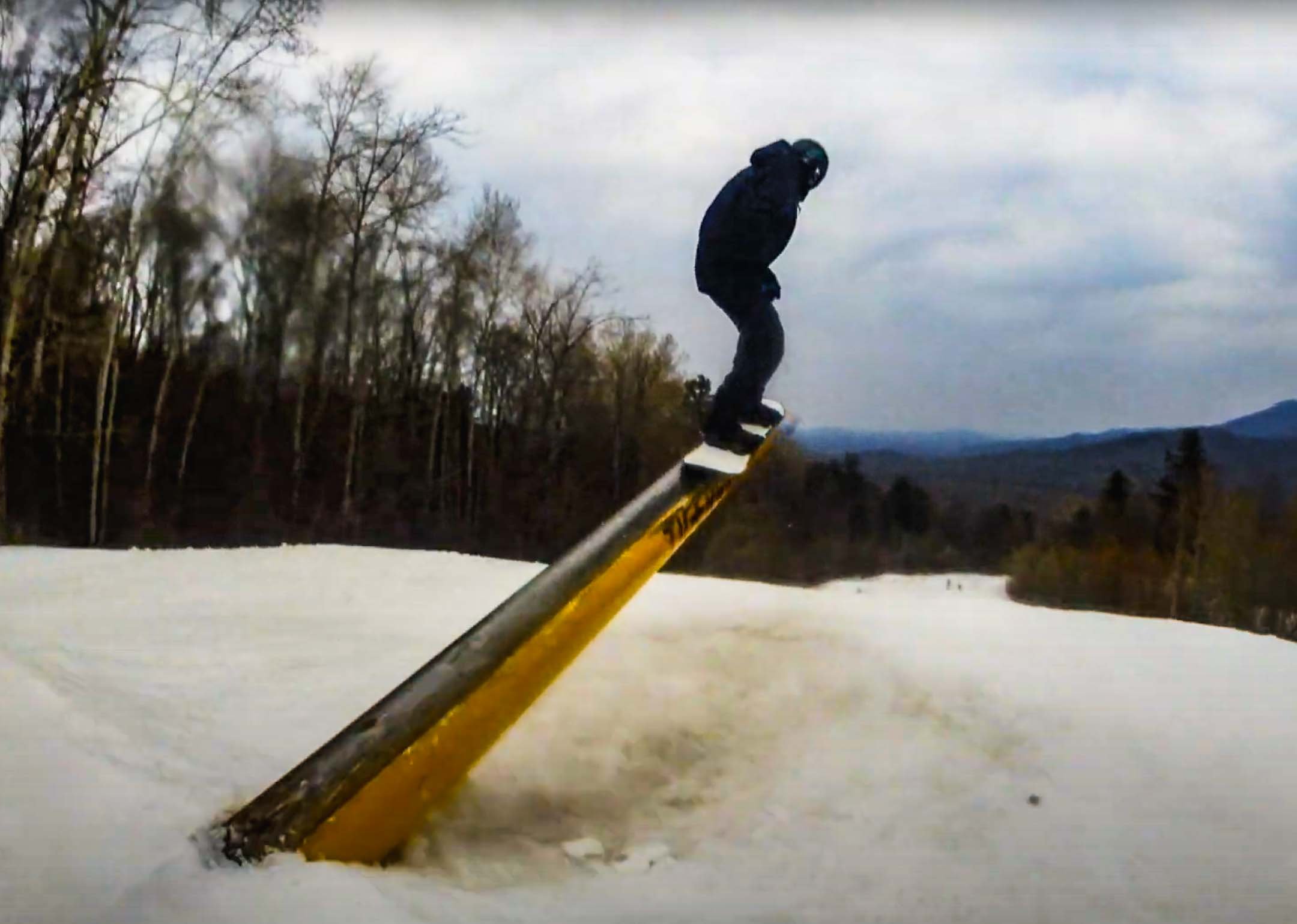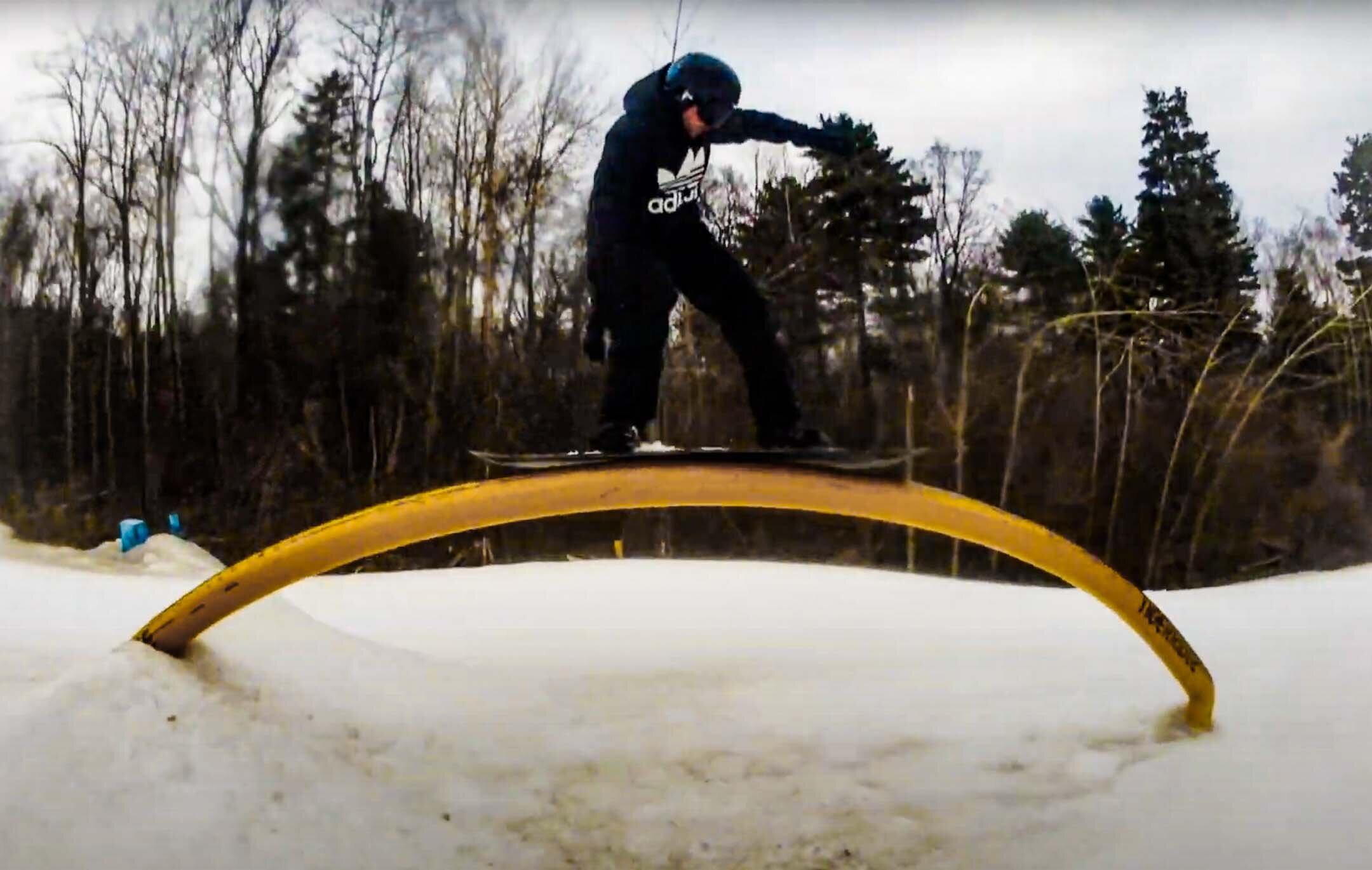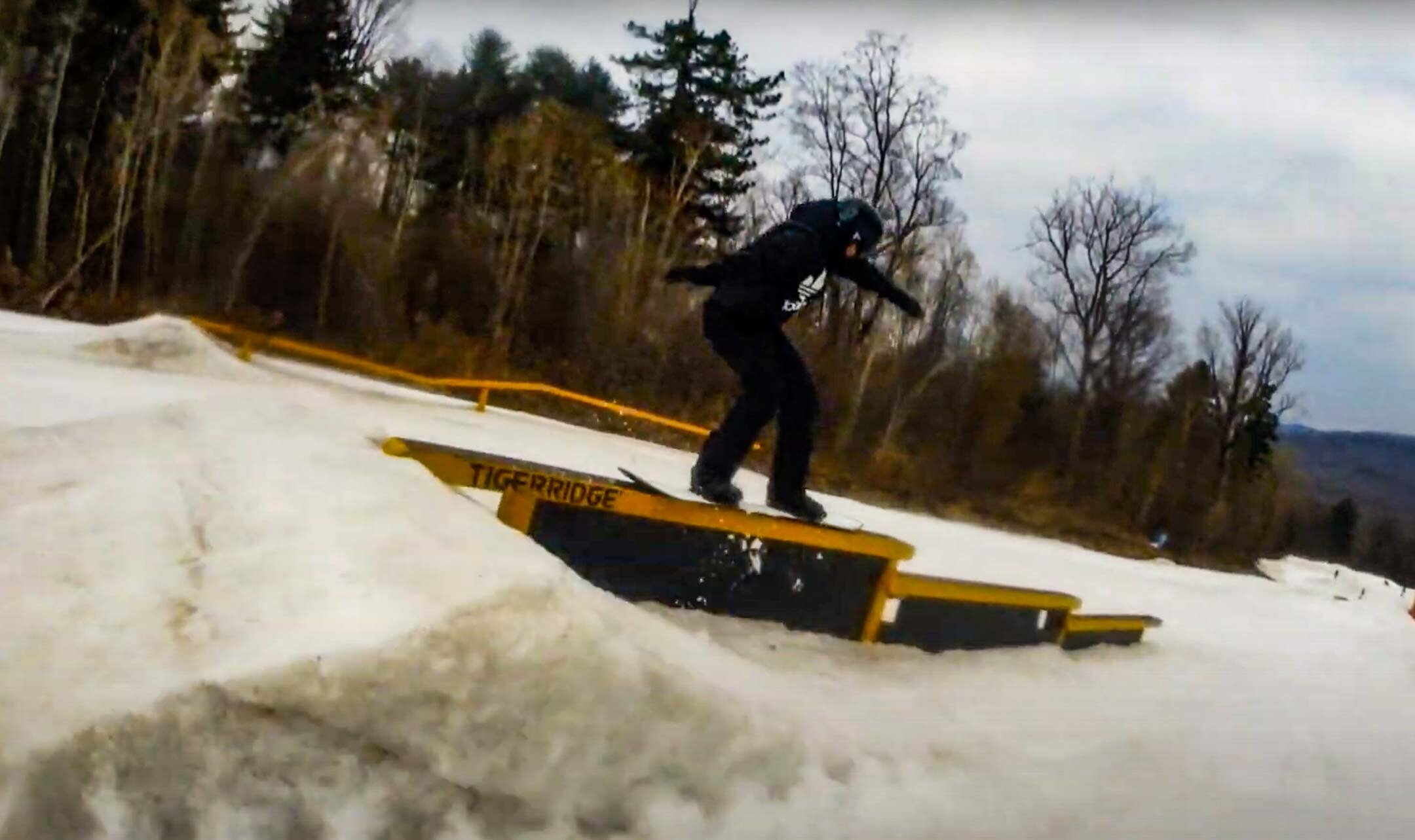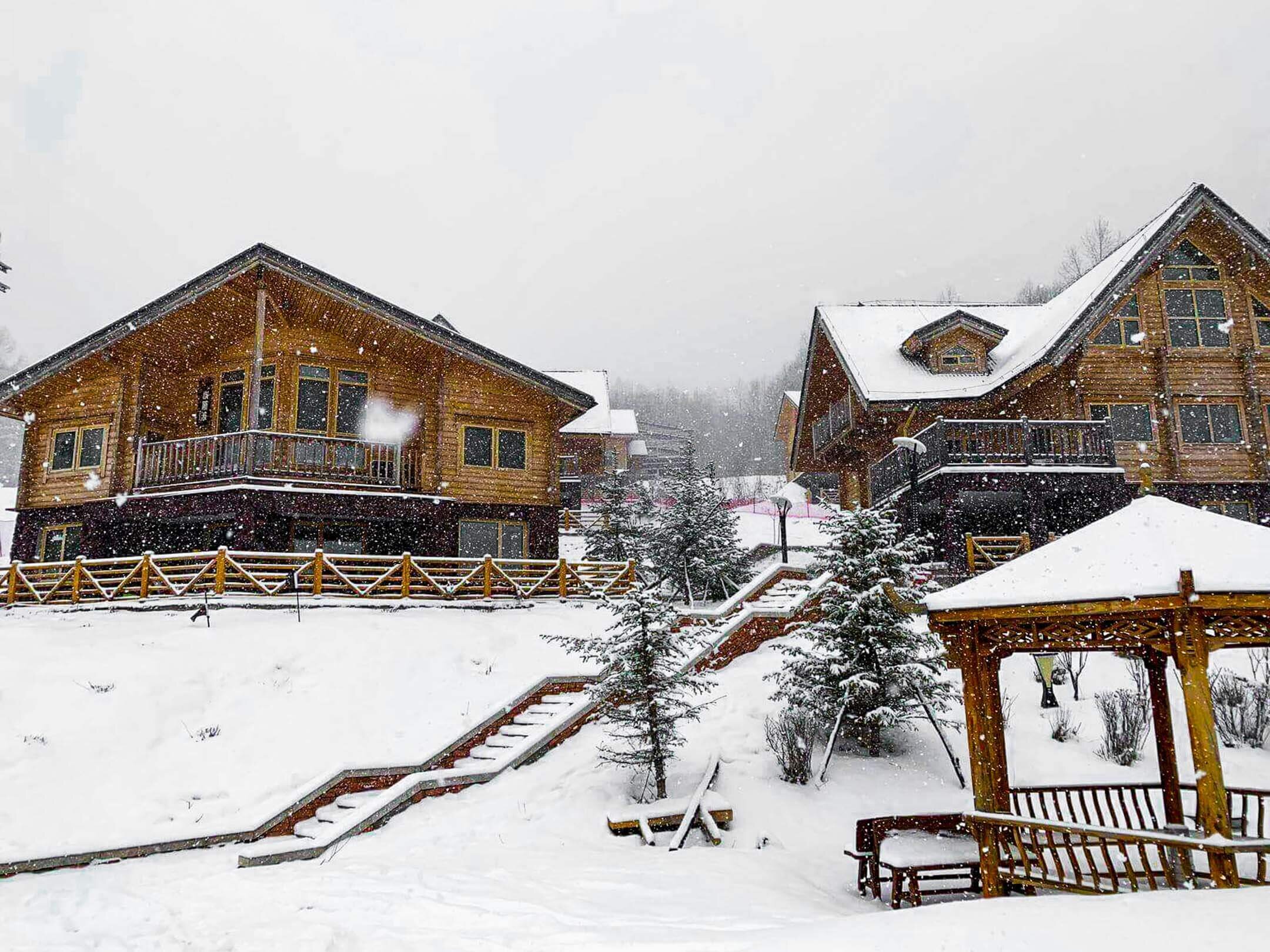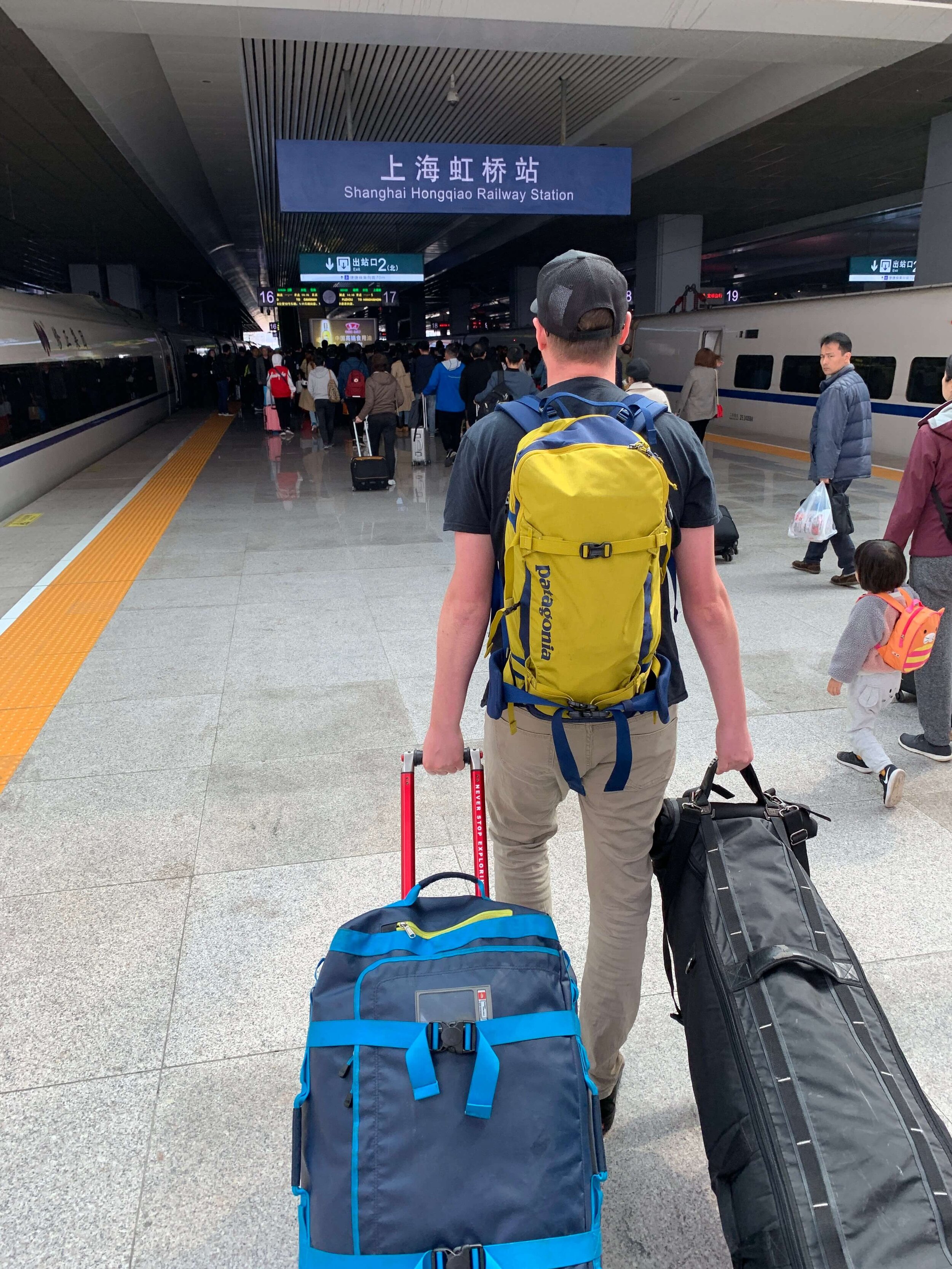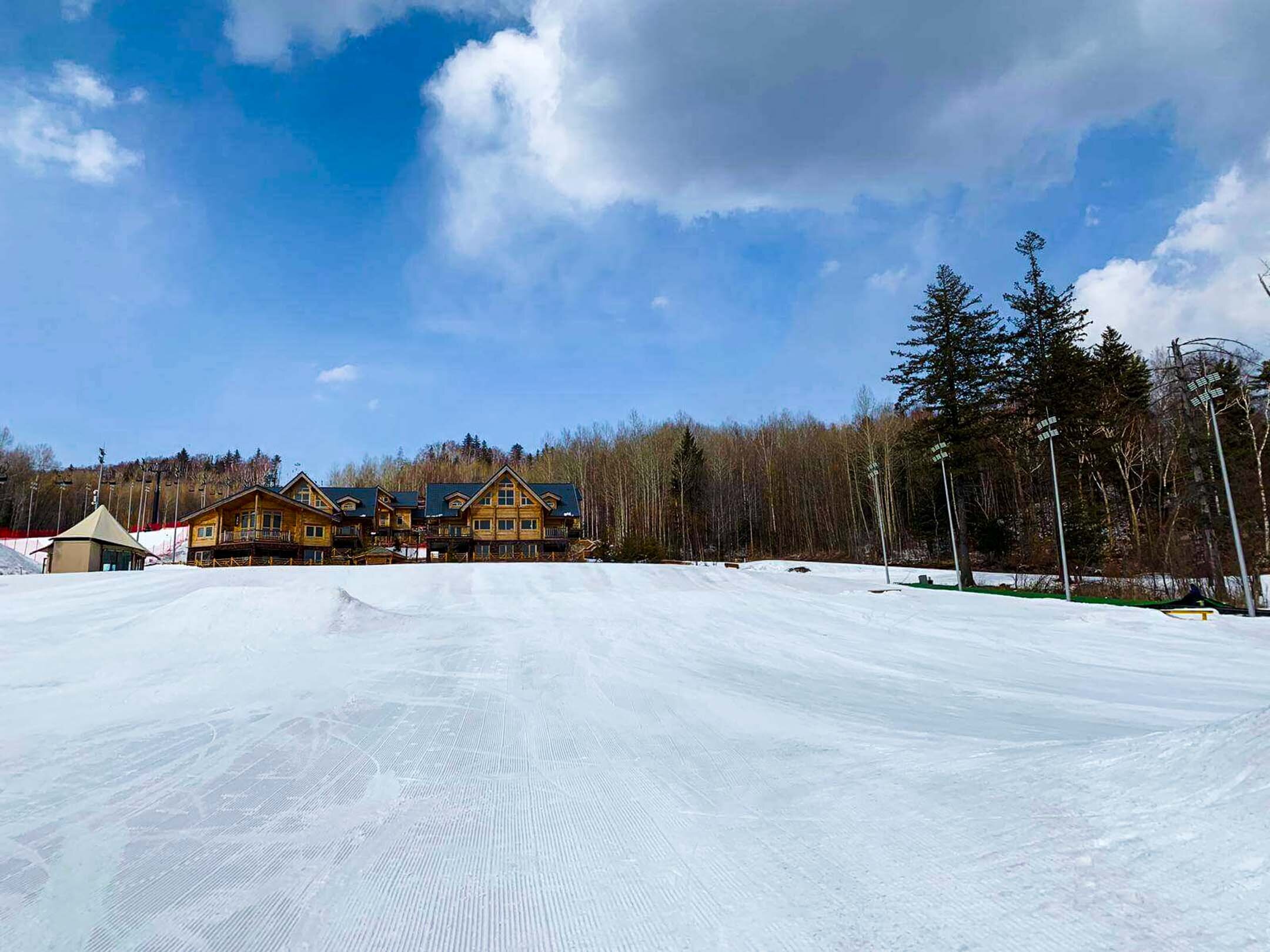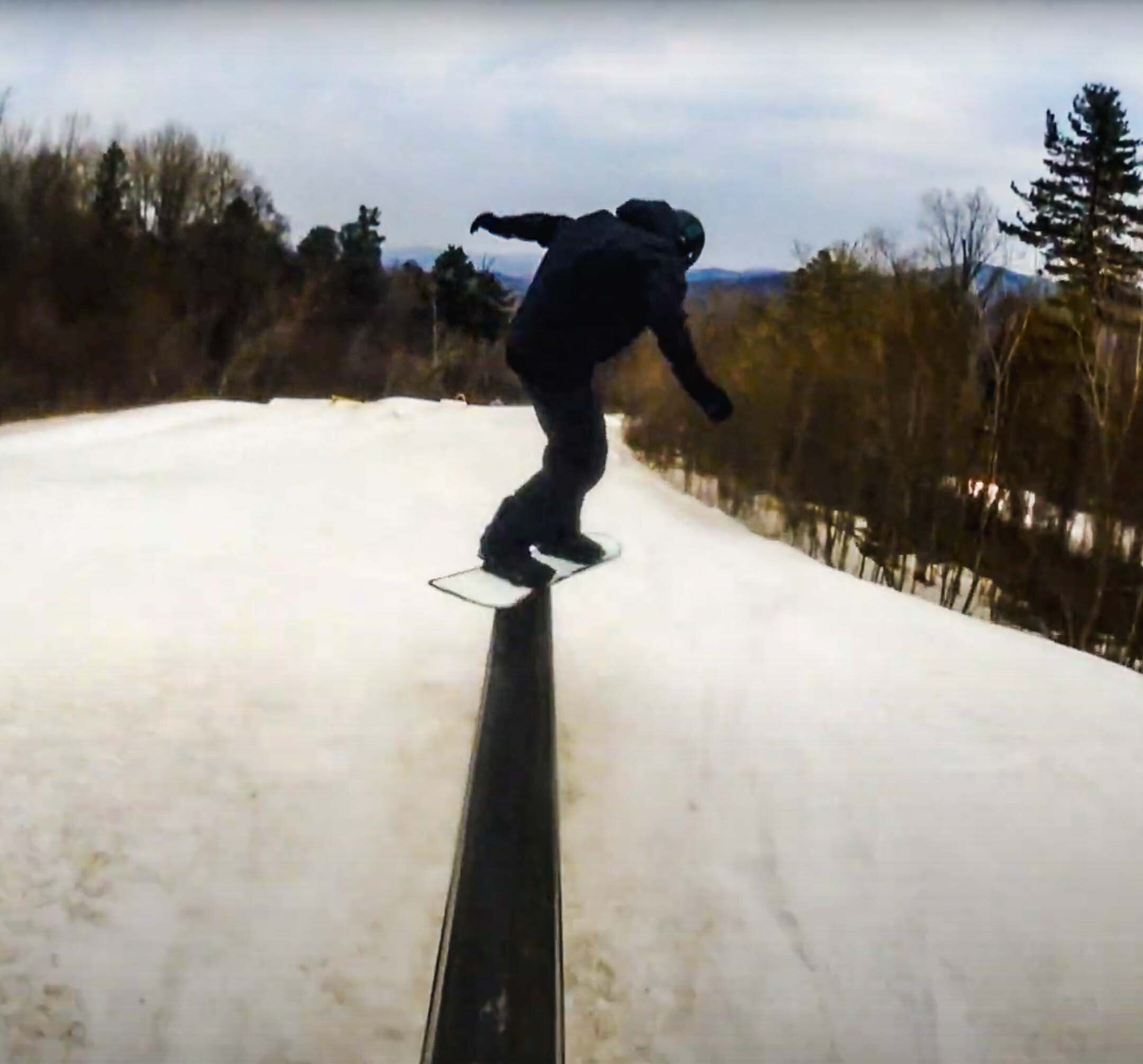Hakuba Cortina Ski Resort Guide
Hakuba Cortina is by far the best resort in the Hakuba Valley for those in search of steep and deep turns on a Japanese powder day. A combination of factors makes Hakuba Cortina ski resort the ultimate destination for those deep days, starting with the pitch of the trees. Unlike other Japanese resorts, Cortina opens its glades without restriction and this makes for an incredible experience. The steep pitch combined with the widely spaced trees makes this the pinnacle of a trip to Hakuba. Sadly, talk of the quality of Cortina’s tree riding is widespread meaning it is no longer a secret. This can result in some pretty big lift cues after a snowfall.
HAKUBA CORTINA FIRST IMPRESSIONS
Arriving at Cortina you at met by the sight of the iconic Green Park Hotel. A Tudor style hotel offering ski in ski out accommodation at Cortina. Most of the resorts facilities are inside the hotel, which can be pricey so if like me you are on a budget… bring your own lunch. Walking through the hotel to the slopes you will soon get a sense of excitement and anticipation, everyone is talking about getting in the lift line for the first lift.
Stepping outside the hotel you can be forgiven for thinking Cortina is a bit of nothing. There are three lifts at the base area which all run fairly slowly and it’s hard to get an appreciation for the terrain from the base area.
HAKUBA CORTINA SKI AREA
Similar to most Hakuba Valley ski resorts the terrain stats are nothing to get excited about, but who goes to Cortina to ride its 16 trails? Well, the Japanese, which is another reason it’s great because its best asset is mainly avoided by the locals. Cortina’s 16 runs sit mainly within a bowl and can be expanded if you consider that it is linked to neighbour Hakuba Norikura, but you will either need the Hakuba Valley Pass or a combined lift ticket to make use of this link.
There is some pretty decent beginner runs at Cortina however there are better Hakuba resorts to learn at. The real draw is the free ride zones including the backcountry lap that leads through to Norikura. The trees through these routes are well spread out, perfectly so! The combination of the well-spaced trees and the steep pitch makes Cortina an absolute must-visit resort.
The approach to off-piste at Cortina ski resort is different to the neighbouring Hakuba resorts. Most Hakuba resorts make you attend a course before you can ride in the dedicated off-piste zones. Hakuba Cortina is more relaxed and you are free to explore the terrain at your discretion. The tree-skiing at Hakuba Cortina is steeper, better and blessed with huge amounts of snowfall what’s not to love? Well, the one downside to skiing and snowboarding at Hakuba Cortina is that everyone knows how good it is. Be prepared to stand in lift queues but don’t worry, there is plenty of Japow to go around.
As mentioned above Hakuba Cortina ski resort is a small resort if you only take the trail map into consideration. Connected via lift to Hakuba Nortikura this opens more terrain including a fantastic backcountry route to Norikura through the trees from the top of the Number 4 chair.
BEGINNERS TERRAIN AT HAKUBA CORTINA
Cortina isn’t best known for its beginner ski and snowboard terrain but actually, it would be a decent place to learn your turns. The main beginner trail runs back down to the base area from the No. 1 chair and is a fairly long stretch. The beginner’s trail is nice and wide offering plenty of space for beginners to learn.
Also, what better place to learn than in a ski resort with copious amounts of snow, think about those soft landings.
INTERMEDIATE TERRAIN AT HAKUBA CORTINA
Intermediates will enjoy riding at Hakuba Cortina but should also consider adding the Norikura ski resort to their lift pass. A dual Cortina Norikura lift pass will open up more intermediate terrain. The Hiedayam Rinkan Course from the top of No. 4 chair allows intermediates to ski from the top of the resort dipping in and out of the trees within their comfort level.
ADVANCED TERRAIN AT HAKUBA CORTINA
Advanced skiers and snowboarders will have an absolute field day at Hakuba Cortina. The steep Hiedayama Courses are great but in reality, everyone is at Cortina for the trees. This is where Hakuba Cortina really stands out with its wide tree runs. Tree skiing at Hakuba Cortina is at your own risk and you should treat it with caution. If possible ride with a friend and bring the correct safety gear. Although the terrain is in bounds there is more snow than most skiers and snowboarders are used to so it wouldn’t be that difficult to run into trouble.
FREESTYLE TERRAIN AT HAKUBA CORTINA
There is no terrain park at Hakuba Cortina, but neighbour Norikura has a Pipe, a small terrain park as well as a boarder cross, and a mogul run. If freestyle is your thing then consider looking at these Hakuba Valley ski resorts; Hakuba 47, Tsugaike Kogen.
LIFTS AT HAKUBA CORTINA
Hakuba Cortina’s lift infrastructure can be quite frustrating. Seven lifts in total but none of them run particularly fast. Well, they do say good things come to those who wait and I can assure you that the run down is well worth the slow uplift. To access the more advanced terrain you will need to catch the No. 1 lift from the base area where you can then head up the No. 4 chair. There are normally long lift queues for the No. 4 lift on a powder day so if you are impatient then head to the No.5 chair which also accesses some incredible tree skiing.
HAKUBA CORTINA PROS
Hakuba Cortina ski resort has some of the best trees runs out of any resort I have visited. The combination of steepness, the spread of trees and the quality of snow all help this.
Hakuba Cortina and nearby Norikura receive more snow than the resorts closer to Hakuba village.
The quality of the snow at Hakuba Cortina is unrivalled in my experience.
Hakuba Cortina is one of the few resorts in Hakuba linked via chairlift to another. Ride between Cortina and Hakuba Norikura on the same day and explore both resorts.
Free shuttles are available to Cortina from the Happo Bus Terminal
HAKUBA CORTINA CONS
Hakuba Cortina Ski Resort is no longer a secret and due to the slow speed of the chairs, you can expect to spend 30-40 minutes in lift lines on busy days (it is more than worth it).
Despite having free transport it is not an enjoyable journey with the bus normally packed full. You will need to get the 7:30 am bus to make the first lift at Cortina Japan.
TRAVEL TO HAKUBA CORTINA SKI RESORT
Free shuttle buses run to Hakuba Cortina from the Happo Bus Terminal throughout the day. If you are planning to get first tracks, you will need to get the 7:30 am bus, but be warned this is incredibly popular so be early or you could miss out. This bus also stops at Tsugaike Kogen ski resort which is another favourite in Hakuba. Cortina is the furthest resort from Hakuba Village and the drive takes around 30 minutes.
HAKUBA CORTINA SNOW RECORD
Cortina gets the most snow out of all the Hakuba Valley ski resorts. 12m plus during the winter season! That is insane. Whether Cortina gets more snowfall or it catches the snowfall better with its bowl-shaped terrain matters not as the facts are as follows. The amount of snowfall that Cortina Hakuba receives is legendary and it is more than enough to blow your mind!
HAKUBA CORTINA LIFT PASSES
HAKUBA VALLEY PASS
If you are planning to visit more Hakuba Valley ski resorts than Hakuba Cortina it may be worth picking up a Hakuba Valley pass. The Hakuba Valley Pass not only offers access to the slopes but the interconnecting resort shuttles. This means your transport and skiing is included on the same pass. Find out more by watching the video below.
EPIC PASS
If you are an Epic Pass season pass holder than you will get access to the resorts of the Hakuba Valley included with your pass. The Epic Pass allows for 5 consecutive days of skiing in the Hakuba Valley, additional tickets can be purchased at a discount.
PAY AS YOU PLAY
If you want more freedom to choose your day to day activities and resorts you won't lose much money by paying on the day. Paying for your lift passes on the day offers a number of benefits. You can get full-day, morning or afternoon passes which offers flexibility.
MORE HAKUBA CORTINA VIDEOS
HAKUBA CORTINA GALLERY
To be fair I wasn’t stopping very often to take photos and in hindsight needing photos for a blog post that wasn’t that great an idea. But the conditions were insane so it was just go go go. These screenshots below should give a pretty decent idea about what to expect when snowboarding at Hakuba Cortina.
ACCOMMODATION AT HAKUBA CORTINA
If you have the money, a stay at the Green Plaza Hotel will leave you as close to the lifts as possible. A stay in this Tudor style hotel will cost around £200 per night. More likely is that you will stay in Hakuba Village and travel to Cortina when the forecast is good.
NEARBY RESORTS
FINAL THOUGHTS ON HAKUBA CORTINA
Hakuba Cortina brought me not only some of my best days on snow but also some of the best days of my life. Although there can be crowds (usually at No.4 chair) there is some great skiing and snowboarding to be had. The traverse left from the No. 5 chair before dropping into the trees is less crowded than other parts of the resort but has some great turns.
Five Best Ski Runs In Hakuba Valley
The Hakuba Valley is an area of Japan renowned for world-class skiing and snowboarding. Blessed with an average of 12m of snow per winter, it is no wonder that people flock from around the globe to experience Japanese powder conditions. In this post I share the five best ski runs in the Hakuba Valley.
With ten resorts included on one pass there is an expanse of terrain to choose from when heading to Hakuba. This means whittling all the options down to a list of the five best runs possible in Hakuba was a hard task. This list is based on my experience of snowboarding in Hakuba in Jan-Feb 2019 and my fondest memories of the trip. The runs I have selected are varied and I will fully explain my reasoning below.
5. TSUGAIKE DBD GATE 3
Tsugaike is nicknamed ‘powder heaven’ and this should tell you all you need to know. Geographically it is close to Hakuba Cortina but it doesn’t draw the same crowds despite receiving similar amounts of snow. This is most likely down to the restriction on tree riding at Tsugaike, requiring you to take a course to enter to the tree areas or DBD. There are four main gates into the Tsugaike DBD area and I enjoyed the lines through Gate 3 the most. Gate 3 provides a longer run than Gate 1 with a steeper incline but the same well spaced trees!
4. HAKUBA 47 TERRAIN PARK
When you think of a Japanese snowboard trip heading to the terrain park is not what comes to mind. Sadly not every day can be a powder day and Hakuba 47 offers another option to keep you entertained during your trip to Hakuba. The terrain park at Hakuba 47 is in my opinion the best in Hakuba. The layout is great with its own (fairly slow) chairlift, making park laps a fairly simple task. Hakuba 47 has Hakuba’s only half pipe at the top of the park which leads down to a choice of lines. Skiers and snowboarders can choose between simple ride-on boxes to large kickers and more advanced rail features.
3. CORTINA CHAIR 5 TREE RUN
Cortina was bound to feature in this list and it does twice, but the run from the number 5 chairlift might be a surprise entry to some. This is where I found some of my best and less contested turns in Cortina. With the crowds that flock to Cortina if you want to make the most of it you need to get away from the crowds. Number 4 chairlift accesses some great terrain but you can expect a 40 minute lift cue on a busy day. With this in mind the trees that are accessible from Number 5 chairlift are a great option. My advice is from the top of the chairlift go left, take a short traverse and then drop in. Most skiers and snowboarders go right of the chair meaning you can find untracked lines well into the afternoon. Whatever chairlift you use at Cortina will lead to widely spaced trees and copious amounts of JAPOW! Taking chairlift number 5 just means you don’t need to share.
2. SANOSAKA LAKE DOWN TRAIL
Sometimes good things come in small packages and Sanosaka is a prime example. Making the list at number two is my favourite non-powder day run in Hakuba, Lake Down Trail. It blows my mind how quiet this resort is and you can have the groomers to yourself all day. Lake down trail is a wide blue run offering great views of Lake Aoki. Stood at the top you have the option to take the groomed piste or go to skiers right where there is a pump track… as the run mellows out towards the chairlift, you will also find some small park features. This means in one run you can; take in a great view, carve a groomer, build up speed on the pump track, hit a jump, slide a rail and then head up for some more…. oh did I mention dogs are allowed? So be sure to keep an eye out for a furry friend.
1. CORTINA TO NORIKURA BACKCOUNTRY RUN
Hakuba Cortina not only has no restrictions on where you can tree ride but it is also linked to neighbouring resort Norikura Onsen Ski Resort. From the top of number 4 chairlift at Cortina, you can access a backcountry run that takes you between the two resorts and this was a highlight of my days at Cortina. As soon as you drop in you are met with perfectly spaced trees and a steep incline that make face shots a regular occurrence. The amount of snow combined with the terrain makes this a run I have not found elsewhere on my snowboard travels. You will want to gradually ride towards skiers left as this will take you towards Norikura resort where you will be able to head back up and do it all again.
Have you visited Hakuba? Do you have a favourite run? Let me know in the comments.
RELATED POSTS
Norikura Onsen Ski Resort Guide
Norikura or Norikura Onsen Ski Resort is one of the ten resorts included on the Hakuba Valley ski pass. Much less westernised than other ski resorts in the valley, Norikura feels a world away from Hakuba Village. You will not find any large chain rental shops or bustling restaurants at Norikura but you will discover an authentic Japanese skiing experience. Much quieter than the resorts of Happo or Goryu, it can feel like you have the resort to yourself which is always an incredible feeling.
HAKUBA NORIKURA ONSEN FIRST IMPRESSIONS
Arriving at Norikura feels a little different to arriving at the other Hakuba Valley resorts. To start with, if you are taking the free Hakuba Valley shuttle buses you will notice that most people stay on the bus and head to the neighbouring Hakuba Cortina ski resort. It is a strange feeling to arrive somewhere with a bus of 50 people and be the only person to get off! Once off the bus, you will not notice any major infrastructure other than the hotels at the base of the resort. You will walk straight off the bus and onto the chairlifts!
The second noticeable thing was the lack of crowds at Norikura. The majority of skiers and snowboarders appeared to be Japanese and I could count the western visitors I noticed on one hand. Once away from the base area, which has some mellow beginner slopes, don’t expect lift lines because there aren’t any!
HAKUBA NORIKURA ONSEN SKI AREA
Similar to most of the resorts in Hakuba you will not find a particularly large ski area at Norikura. With only 500m of vertical drop 1300m-800m and 14 trails, it’s a good job that Norikura is linked to its neighbour resort Cortina. The link to Cortina adds an additional 16 runs to the Norikura ski area which should be enough to keep most people occupied for a week of skiing or snowboarding, especially when you consider the amount of snow these resorts receive.
There is nothing particularly challenging about the terrain on the Norikura Onsen side with perhaps the most challenge to be found in the trees. The tree riding at Norikura is similar to Cortina in that it is open with skiers and snowboarders taking responsibility for their own riding in these areas. With 80% of the terrain marked as beginner or intermediate, those looking for a challenge should take the connecting lifts over to Hakuba Cortina where the runs are steeper. For those staying on the Norikura side, you will face less competition for your turns.
FREESTYLE TERRAIN NORIKURA ONSEN SKI RESORT
The ski area at Hakuba Norikura has a terrain park which features a good-sized half pipe. You will also find a border cross course and freestyle moguls set up. The freestyle terrain at Hakuba Norikura Onsen is minimal and if freestyle is your main interest you should consider visiting Hakuba 47 ski area.
BEGINNERS TERRAIN NORIKURA ONSEN SKI RESORT
If you are a beginner you will find that Norikura is a great place to learn and to have easy progression. There are some nice mellow runs just opposite the Hakuba Alps Hotel, near the bus stop, accessible from lift 1. Similarly, the green trail beneath the No. 6 chair will be enjoyable for beginners. A real perk of skiing or snowboarding at Norikura as a beginner is the lack of crowds. The runs at Norikura allow plenty of space to practice your turns without worrying about crashing into other skiers.
INTERMEDIATE TERRAIN NORIKURA ONSEN SKI RESORT
Norikura Onsen ski resort is great for intermediates looking to take their first steps into tree skiing. The tree runs here are widely spaced and lack the steepness found at neighbouring resorts. This combination makes tree skiing here less worrying and more enjoyable. Partner this with the copious amounts of snow received at Hakuba Norikura and this could be the perfect intermediate powder playground.
ADVANCED TERRAIN NORIKURA ONSEN SKI RESORT
The aptly named Expert course at Norikura is one of the few black trails on offer within the bounds of the resort. Just like other black ski trails at Norikura Onsen, the Expert Course is short and over in a flash. A real treat for expert skiers is the backcountry run between Hakuba Cortina and Norikura. This route can be lapped starting in Cortina and finishing at Norikura Onsen.
The nice thing about off-piste skiing at Norikura and the neighbouring Cortina ski resort is the lack of restrictions. A number of ski resorts in the Hakuba Valley require you to attend safety briefings (Tsugaike Kogen) or to register with ski patrol (Hakuba 47). This can be a bit… over the top when you compare the terrain you can access at European resorts without restrictions. The freedom to ski in the tree areas at Norikura and Cortina is perfect, especially on a powder day! Just be careful as the amount of snow you will encounter is probably much more than you are used to!
LIFTS AT NORIKURA ONSEN SKI RESORT
In what seems commonplace for Japanese ski resorts, Norikura has nearly as many lifts as trails. The nine total chairlifts are fairly basic and run at a mild speed without being overly slow. I guess the low vertical means you don’t spend too long riding the chairs.
No.3 and No.5 Pair lifts will offer the most challenge at Norikura Ski Resort. These chairs access the steeper terrain in the resort. Beginners will enjoy the terrain under the No.6 chair which offers mellow green ski trails back to the base area.
SNOW RECORD AT NORIKURA ONSEN SKI RESORT
The ski resort of Hakuba Norikura is situated to the North of the Hakuba Village close to Hakuba Cortina and Tsugaike Kogen. This end of the Hakuba Valley is best known for receiving the most snowfall and makes it the place to go for powder turns. If you are an experienced skier or snowboarder you should make the most of the linked ski pass that Norikura shares with Hakuba Cortina as this will allow you to make the most of the great tree skiing in the area.
NORIKURA PISTE MAP
SEASON DATES
The ski seasons at Hakuba Norikura typically runs between December and April with the best skiing found between the end of January and the end of February. It is during this period that Norikura receives massive amounts of snow fall. There is a reason they call it “Japanuary”.
TRAVEL TO NORIKURA
Where is Norikura Onsen
Norikura Onsen ski resort is in-between two of the most popular resorts in the Hakuba Valley. On one side is Tsugaike Kogen ski resort known for its DBD tree skiing area. On the other is Hakuba Cortina, which is close enough to be linked via chairlift to Norikura Onsen. This part of the Hakuba Valley receives the most amount of snow and it is here you will want to head for the best Japanese powder skiing.
How to get to Hakuba Norikura
Free shuttle buses run to Norikura via Tsugaike and Iwatake ski resorts. The buses do not run very frequently so you will have to check the most up-to-date timetable. On your way back to Hakuba village the bus will leave Cortina before reaching Norikura which can mean that seats are few and far between. The drivers try to save seats on a busy day.
NORIKURA ONSEN ACCOMMODATION
If you wanted a more relaxed feel for your Hakuba holiday you could base yourself in Norikura. The Hakuba Alps Hotel is at the base of the slopes and would represent a good ski-in ski-out option. Alternatively, there is lots of accommodation options in Hakuba village and really depends on your preferences and budget. I stayed in a guesthouse which was fairly basic but provided a space to cook, wash and sleep.
NORIKURA PROS
Norikura Onsen main selling point for me would be the lack of crowds. There is less waiting in line, less competition for first tracks and more room on the pistes.
Being a linked ski area Norikura and Cortina combine to make one of the larger ski areas in the Hakuba Valley. This means there is more terrain to keep you occupied without having to repeat the same runs.
The backcountry run between Hakuba Cortina and Norikura Onsen ranked number 1 in my Five Best Runs Hakuba Valley
The resorts of Tsugaike, Norikura and Cortina receive larger amounts of snow than the other Hakuba Valley ski resorts.
Free shuttles are available to Norikura Onsen Ski Resort from the Happo Bus Terminal
NORIKURA CONS
Although free shuttle buses connect Norikura to Happo Bus Terminal and the other Hakuba resorts, they do not run as frequently. This can make inter-resort travel a little tiresome.
No major challenge for advanced skiers or snowboarders meaning you could find yourself repeating certain runs.
NORIKURA VIDEOS
NEARBY SKI RESORTS
NORIKURA ONSEN FINAL THOUGHTS
Hakuba Norikura Onsen Ski Resort was great to visit for its more relaxed vibe and I found myself visiting the combined Cortina-Norikura ski area multiple times throughout my trip. Although by staying on the Norikura side you may sacrifice some challenge, I do feel it’s worth it for less competition for fresh snow.
Multi-Resort Lift Passes in Japan
Multi-resort lift passes have been all the rage ever since EPIC and IKON waged their war on the US ski scene. Whatever you feel about partner ski resorts versus independent ski hills it is undeniable that these passes can offer some of the best value skiing and snowboarding across the globe. It is fair to say that there are now a number of really great products across the world from Switzerland’s Magic Pass, Europes Snow Pass and Austria’s Tirol Snowboard… but what are the best value ski passes for snowboarding in Japan?
YOUR EXPERIENCES
Before I get into it I would love to hear from you on your experiences of using the below lift passes in Japan? Have you taken your IKON or EPIC pass to Japan? Are you planning to hit the INDY resorts this winter? Let me know in the comments.
EPIC AND IKON PASSES
Let’s start with the big players in the world of multi-resort ski passes EPIC and IKON. The EPIC and IKON passes could rightly consider themselves amongst the best multi-resort ski passes in the world. Both passes entitle holders to skiing across multiple continents. This was the reason I chose Epic back pre-pandemic as my plan was to ski in Europe, North America, Asia and Australasia all on the same lift pass.
In terms of Japan, Epic Pass offers holders 5-days of skiing and snowboarding at the 10 Partner resorts in the Hakuba Valley. Further to this EPIC has also partnered with Rusustu to offer a further 5-days of additional lift privileges. IKON has added Niseko United to its offering with 7days of access to the 4 mountains in this area.
INDY PASS
Not on the same scale as IKON and EPIC but certainly making a name for itself is North Americas INDY pass. The INDY pass offers 2 days riding at 76 resorts, four of which are in Japan. Get Kogen, Okunakayama Kogen, Shimokura and Tazawaka are all accessible on this pass that costs less than $300.
HAKUBA VALLEY PASS
The Hakuba Valley pass is great value if you intend to make the most of the 10 resorts in this area. Including world renowned Hakuba Cortina and Happo One this pass packs a punch. What I loved about this pass was the access to lesser known resorts like Sanosaka that I may not have visited had it not been for the Hakuba Valley pass. A 7 day Hakuba Valley pass will cost around £280 but remember Epic Pass holders get 5 days included for free.
NISEKO UNITED
Niseko is probably Japans most popular ski resort area famed for its endless snowfall between January and March. With 4 resorts included on the Niseko United Pass you can ski the interconnected area without having to worry about additional passes.
MOUNTAIN COLLECTIVE
Back to another American pass and the Mountain Collective is similar to INDY in that it offers 2 days skiing at its partner resorts. Niseko United is included on the Mountain Collective list of destinations but is the 2 days really worth it? This wouldn’t be my go to multi-resort lift pass of choice for Japan.
ALSO CONSIDER
It is also worth considering that lift tickets in Japan don’t always follow the same system as in Europe or America. It is possible at some ski resorts to pay by lift rather than by day. This normally works on a point system that charges points based on the list you choose. Slower lifts cost fewer points, whereas gondolas tend to charge more points as they travel further distances. Depending on whether you have a set plan for that day or are only using the lift to access a backcountry area, this could be a suitable way to access the slopes.
Hakuba 47 Ski Resort Guide
Hakuba 47 ski resort is a year-round resort that offers skiing and snowboarding during the winter and mountain biking during the summer months. Hakuba 47 is one of the few linked ski areas in the Hakuba Valley and you can ride via chairlift between Hakuba 47 and the nearby Hakuba Goryu ski resort. Hakuba 47 offers more advanced terrain than its neighbour with some steep runs but most impressive is its well-maintained terrain park.
HAKUBA 47 SKI RESORT FIRST IMPRESSIONS
Snowboarding between Hakuba 47 and Hakuba Goryu is a nice change of pace. Normally in the Hakuba Valley, you will need to take shuttle buses to ride between the resorts, but not here. Linked via shared runs and lifts, it is possible to ski both of these resorts in one day. The Hakuba 47 side of the ski resort has a beautiful red run that runs from the top of Quad Chair C, back to the base of the gondola. From the gondola, you can see why Hakuba 47 is so popular with freestyle skiers and snowboarders. The terrain park here has a small half pipe as well as a large, medium and small line of jumps and features.
HAKUBA 47 SKI AREA
Japanese ski resorts are not known for having lots of skiable terrain but when considering Hakuba 47 without its neighbour you are left with 8 trails and a half-pipe. The skiable terrain at Hakuba 47 increases when you consider the interconnected trails shared with Hakuba Goryu. The terrain at Hakuba 47 will appeal to intermediates and experts more than beginners. Beginners should consider the runs near the base of Goryu ski resort which has mellow beginner-friendly pistes.
The main draw to Hakuba 47 is the terrain park. Located next to the top station of the Hakuba 47 gondola, the terrain park is serviced by its own chairlift. The terrain park is probably the best in the Hakuba Valley with three distinct lines of features that have something for all abilities.
The features were incredibly well maintained and there was a clear progression of ride-on boxes to larger rail features. As with most terrain parks the kickers are placed adjacent to the chair lift so you can watch in awe as you plan your next lap from the chair.
The jewel in the crown for Hakuba 47 is the half pipe which was one of two that I came across in Hakuba (the other at Norikura). The half-pipe is at the top of the park and leads down into some more mellow features. This area of the resort can become busy during peak days so be prepared to queue to get your park laps in.
Away from the terrain park, Hakuba 47 has some fantastic tree skiing. To ski in the trees at Hakuba 47, you must visit the ski school to sign a waiver and collect a bib which must be worn whilst in the tree skiing zones. This is so that it is visible to ski patrol that you have taken the course and are permitted into the area. This seems overkill to me but at least the zone is open and available should you wish to partake. Entry into these zones without completing this process can result in having your ski pass confiscated.
There are further tree zones at Hakuba 47 and neighbouring Goryu that are strictly prohibited. These zones have an avalanche history so go at your own risk. If you ride in these zones you will lose your lift pass if caught by ski patrol but that could be the least of your worries.
The longest run at Hakuba 47 is 6.4km allowing skiers and snowboarders to make use of the 794m of vertical drop. The snow quality at Hakuba 47 is exceptionally good with regular dumps of Japow amounting to around 12m per season!
BEGINNERS TERRAIN HAKUBA 47
Hakuba 47 ski resort is not the best choice for beginners heading to the Hakuba Valley. The limited green terrain on offer means that beginners may find the runs at Hakuba 47 repetitive. The highlight for beginners at Hakuba 47 is the long winding green run from the top of the gondola back to the base area.
INTERMEDIATES TERRAIN HAKUBA 47
The stand-out run for intermediates at Hakuba 47 is the long red run down to the base area. This run is great and offers the chance to open up your turns and get some speed. Sadly, once you have skied it a few times it is no longer that exciting. That is why Hakuba 47 being linked to Goryu is great. This allows skiers and snowboarders to mix up their run choices a bit more throughout the day.
Intermediates looking to get into freestyle will appreciate the terrain park at Hakuba 47. The terrain park offers plenty of opportunity for progression with well-laid-out lines of features.
ADVANCED TERRAIN HAKUBA 47
Advanced skiers and snowboarders will appreciate the Adventure Course at Hakuba 47. This course heads back towards Hakuba Goryu ski resort and consists of some rather large moguls. If bumps are not your thing then consider getting a bib from the ski school and head into the trees. Like with most of the Hakuba Valley, the trees at Hakuba 47 are well spaced and the masses of snowfall doesn't hurt the fun factor.
TREE SKIING HAKUBA 47
The attitudes to off-piste skiing and snowboarding vary depending on which country you are riding in. If unsure you can check this post on where the boundary lies depending on the country. In Hakuba 47, they are becoming more open-minded to the idea of tree-skiing and allowing entry into dedicated tree zones after you have attended a safety course. The safety course is similar to the one at Tsugaike Kogen ski resort and is known as the DBD or Double Black Diamond Club.
I am all for increasing knowledge and safety awareness, especially given the amount of snowfall and avalanche-prone terrain in the Hakuba Valley but here are a couple of thoughts. Once you have attended the safety course you are free to ride the tree areas but there is no requirement to wear a beacon or ski with a buddy. These two steps are essential in dangerous terrain as I am not sure that the bib will save your life should you run into a problem.
HAKUBA 47 TREE RIDING ZONE (TRZ)
Below is a map of the dedicated TRZ or Hakuba 47 Tree Riding Zone. To enter the areas designated for member tree-riding you need to collect an armband (cost 200 yen).
To ride in the TRZ you must do meet the following requirements
Attend the TRZ safety Briefing and sign the waiver
Be older than 13 years old and taller than 150cm. (U18 must ride with parents)
Agree/be able to pay for rescue if required.
Wear the TRZ armband at all times when riding in the TRZ.
Hakuba 47 also has some open tree zones listed on the above TRZ map. Any purple open tree zone does not require TRZ.
HAKUBA 47 PISTE MAP
HAKUBA 47 LIFTS
Hakuba 47 has 5 lifts and a gondola which in my opinion were some of the quickest among the Hakuba Valley ski resorts. This meant that getting laps in was pretty quick unless riding the terrain park where crowds are prevalent and the lift is run slower. There is also a short magic carpet which runs in the kid’s park. There is a lodge at the base and at the top of the Gondola which has eateries and all the usual ski resort facilities.
HAKUBA 47 GALLERY
HAKUBA 47 SKI RESORT PROS
Hakuba 47 has some of the steeper runs in the Hakuba valley which is great for expert skiers and snowboarders
The link between Hakuba 47 and Hakuba Goryu opens up more terrain and this makes spending a couple of days at Hakuba 47 more interesting
The terrain park at Hakuba 47 was the best maintained out of the resorts I visited in Hakuba
Hakuba 47 is very accessible with regular shuttle buses running throughout the day.
HAKUBA 47 SKI RESORT CONS
With only 8 trails Hakuba 47 has a limited skiing area.
The terrain park can become crowded with long cues at the chairlift possible.
LIFT PASSES
Hakuba 47 is included on the same lift pass as Hakuba Goryu allowing you to ski both ski resorts on the same day. If you are buying your lift passes on the day, these are cheaper than purchasing the Hakuba Valley Pass. The Hakuba Valley pass however will provide you with greater flexibility should you wish to explore other ski resorts in the area. During my Hakuba stay I used the Hakuba Valley pass as this also includes all the available inter-resort shuttle buses.
HAKUBA 47 SNOW RECORD
Hakuba 47 is more central with the Hakuba Valley so receives less snow than the resorts of Cortina and Tsugaike further north. Hakuba 47 still gets its fair share of snowfall with ample left over for tree skiing. The ski resorts in the Hakuba Valley receive on average 11m-12m of snowfall per winter!
TRAVEL TO HAKUBA 47 SKI RESORT
Free shuttle buses run to Hakuba 47 from both the train station and Happo bus terminal. The buses to Hakuba 47 are really frequent and it is possible to visit Hakuba 47 and other Hakuba resorts on the same day. The buses to Hakuba are free if you buy a Hakuba Valley lift pass and this can represent good value if skiing at more than one resort.
ACCOMMODATION AT HAKUBA 47
There is no accommodation available at the base area of Hakuba 47 although you could stay near the base of Goryu ski resort. Alternatively, there are lots of accommodation options in Hakuba village and really depends on your preferences and budget. I stayed in a guesthouse which was fairly basic but provided a space to cook, wash and sleep.
HAKUBA 47 VIDEOS
FINAL THOUGHTS ON HAKUBA 47
Hakuba 47 is a must-visit for me for any trip to the Hakuba Valley. The terrain park is one of the best in Hakuba and the ability to ski at both 47 and Goryu is a real bonus. Absolute beginners should avoid Hakuba 47 as there will be little of interest here.
Kashimayari Ski Resort Guide
Kashimayari ski resort is a small ski resort included on the Hakuba Valley Pass. Outside of the main cluster of Hakuba Valley ski resorts Kashimayari does not draw the crowds it once did and there would be little reason to base your trip around Kashimayari ski resort. Kashimayari however is worth the visit as an add-on to your Hakuba Valley ski trip and could provide enough interest for a day or two.
KASHIMAYARI FIRST IMPRESSIONS
Kashimayari Ski Resort is a long way from the central hub of Happo and Hakuba Base Camp but this may actually be a good thing. With Kashimayari being further away from the hustle and bustle it draws fewer crowds. The transport links to Kashimayari are also less frequent meaning a trip here can be a little more awkward than some of the more prominent Hakuba Valley ski resorts.
I arrived at Kashimayari by train from Sanosaka and the journey was beautiful with some fantastic views of the Japanese Alps. The facilities at Kashimayari are in need of a facelift with the buildings and lifts needing investment.
HAKUBA KASHIMAYARI SKI AREA
The Kashimayari ski resort is small, even by Japanese standards. The area itself has gotten smaller with terrain closing due to potential financial difficulties. The ski areas highest point is at 1335m and has a 500m vertical drop. The resort of Kashimayari is now best suited to beginners and intermediates with the more advanced terrain inaccessible by chairlift.
One real positive of the ski area at Kashimayari is the view across to Lake Aokiko which can be seen from the pistes. Who doesn’t love skiing in an area with views of a lake surrounded by mountains!
Kashimayari Piste Map
There isn’t much to write home about in terms of Kashimayari terrain which is why no runs here made my list of the BEST FIVE RUNS IN HAKUBA.
BEGINNERS TERRAIN AT HAKUBA KASHIMAYARI
Beginner skiers and snowboarders at Kashimayari will have access to some wide mellow slopes that are good for learning on. There isn’t much terrain at Kashimayari so you may find that you are continuing to repeat the same slopes as a beginner.
INTERMEDIATE TERRAIN AT HAKUBA KASHIMAYARI
Kashimayari ski resort is an intermediates mountain, the terrain from Lift no 1 has a gradient of beterrn 25 and 28 degrees. There is nothing overly scary at Kashimayari which means it is a great ski resort for intermediates to gain confidence and explore.
ADVANCED TERRAIN AT HAKUBA KASHIMAYARI
Sadly anything of note for advanced skiers and snowboarders at Kashimayari has been closed. I am unsure as to why the top lift stopped running but it is certainly of detriment to the ski area.
LIFTS AT HAKUBA KASHIMAYARI
The four, formerly five, chairlifts at Kashimayari ski resort are in need of updating. There are a couple of 4 person chairs which handle the small crowds that head to Kashimayari however they are dreadfully slow. I guess it is the price paid for escaping the crowds.
HAKUBA KASHIMAYARI PROS
Kashimayari ski resort is quiet, go here to escape the crowds
The view from Kashimayari across to Lake Aokiko is fantastic.
Free shuttle bus access to Kashimayari is possible with the Hakuba Valley Pass.
HAKUBA KASHIMAYARI CONS
Kashimayari does not offer much for the more advanced skier or snowboarder.
The ski resort of Kashimayari is closing terrain not opening more… this does not seem like a positive step for the ski resort.
Kashimayari ski area has infrequent transport links meaning that you need to be careful not to miss your bus.
HOW TO GET TO KASHIMAYARI SKI RESORT
Kashimayari Ski Resort can be reached via various transportation options. For international visitors, flying into Tokyo or Nagoya and then taking a train to nearby Hakuba or Omachi is a common route. From there, a short bus ride or taxi will bring you to the resort. Alternatively, there are direct bus services from major cities to Kashimayari during the winter season.
Kashimayari is south of the main hub of the Hakuba Valley in Happo but is accessible via local shuttle buses. The local buses run from the Happo Bus terminal and are included if you purchase the Hakuba Valley Pass. Services to Kashimayari are less regular than those to other Hakuba Valley ski resorts. With this in mind ensure you have checked the latest timetables.
If you have access to a car, Kashimayari has a car park where it is possible to park within a short distance of the slopes. Car parking at Kashimayari is at no charge.
I accessed Kashimayari by using the local train service from the nearby ski resort Sanosaka. It is possible to ski both of these resorts on the same day using the Hakuba Valley Pass.
KASHIMAYARI SKI RESORT SNOW RECORD
Kashimayari's location in the Northern Japan Alps ensures consistent snowfall throughout the winter season. From December to March, the resort is covered in a thick layer of pristine powder, creating ideal conditions for skiing and snowboarding.
Kashimayari ski resort has a historical snow record of 9.5m which is less than the resorts of Cortina and Tsugaike but way higher than most European ski resorts. Due to the lower elevations at Kashimayari ski resort, the lower slopes can often be found in worse condition then the upper mountain.
HAKUBA KASHIMAYARI LIFT PASSES
To make the most of your time at Kashimayari Ski Resort, be sure to check the lift pass options available. Whether you prefer a single-day pass or a multi-day package, the resort offers various choices to suit your needs. Early-bird discounts and seasonal promotions are often available, so keep an eye out for special deals.
HAKUBA VALLEY PASS
If you are planning to visit more Hakuba Valley ski resorts than Hakuba Sanosaka it may be worth picking up a Hakuba Valley pass. The Hakuba Valley Pass not only offers access to the slopes but the interconnecting resort shuttles. This means your transport and skiing are included on the same pass. Find out more by watching the video below.
The latest Hakuba Valley lift pass prices are available here.
EPIC PASS
If you are an Epic Pass season pass holder than you will get access to the resorts of the Hakuba Valley included with your pass. The Epic Pass allows for 5 consecutive days of skiing in the Hakuba Valley, additional tickets can be purchased at a discount.
PAY AS YOU PLAY
If you want more freedom to choose your day-to-day activities and resorts you won't lose much money by paying on the day. Paying for your lift passes on the day offers a number of benefits. You can get full-day, morning or afternoon passes which offers flexibility.
At the time of writing a 1 Day lift ticket to Kashimayari cost 4000 YEN.
MORE HAKUBA VIDEOS
ACCOMMODATION AT KASHIMAYARI
Accommodation at Kashimayari Ski Resort ranges from cozy lodges to luxurious mountain resorts. Staying on-site provides the convenience of easy access to the slopes and other resort facilities. However, nearby towns like Hakuba and Omachi offer additional lodging options for those seeking a more extensive range of amenities and dining choices.
FINAL THOUGHTS ON KASHIMAYARI SKI RESORT
In conclusion, Kashimayari Ski Resort is a lesser-known Hakuba Valley ski resort that can offer sanctuary away from the crowds in the beautiful Japanese Alps. Kashimayari offers well-groomed slopes with enough variety to ensure an enjoyable experience for skiers and snowboarders of all levels. Although I would not choose to base myself at Kashimayari I would definitely look to explore it again for the odd day on a trip to Hakuba.
KASHMAYARI RELATED POSTS
Hakuba Iwatake Ski Resort Review
Iwatake ski resort is a popular Hakuba Valley resort that is fantastic for intermediate and beginner riders. On my visit to Hakuba Iwatake, I was impressed by the wide cruisey blue runs and the mellow gated tree riding. On a clear day, the views from Iwatake are meant to be pretty impressive… unfortunately I didn’t get a clear day at Iwatake. One issue that Iwatake faces is its lower elevation and base area can mean that when it is snowing at other Hakuba resorts it can be raining at Iwatake. That being said Iwatake still gets its fair share of the snow and there are some great powder stashes to be found.
Hakuba Iwatake Base Area
IWATAKE SKI RESORT FIRST IMPRESSIONS
Arriving at Iwatake via shuttle bus you are dropped at the base of Noah Gondola. From here you can see a chairlift to the skier’s left which accesses a fairly decent beginner’s run that would be a good gradient for learning your first turns. Around the gondola base area, there are a few ski shops, accommodations and food vans that mean Iwatake is a fairly decent place to base yourself for a trip to Hakuba. When heading up the gondola it’s easy to see why intermediates love Iwatake, in each direction, you can see wide-open pistes and on my visits very limited crowds (potentially due to the weather).
IWATAKE SKI AREA
As previously mentioned Iwatake is lower than the other resorts in the Hakuba valley with a summit of 1,289m. This coupled with a rather pitiful 539m vertical drop (less than Thredbo in Australia) means that Iwatake is a fairly small ski resort. This isn’t necessarily a bad thing as Iwatake has some decent infrastructure with fast chairs that means although laps may be short, you can get multiple runs in rather quickly. In total, there are 26 courses at Iwatake with the majority of this terrain being beginner or intermediate terrain. There is only 20% of the piste map assigned as advanced terrain but there is nothing to really get the heart pumping.
SNOWBOARDING FOR BEGINNERS IWATAKE
Iwatake has a number of trails suitable for beginners with an international ski school offering instruction in English. The gradients at Iwatake are much more mellow than nearby Happo One or Goryu so beginners may feel less intimidated here. It is possible for beginners to access ski runs at the top of Iwatake without the need to ride to the base area. If beginners choose to, it is possible to down lift on the Noah gondola at the end of the day. At the base area, there is a green run that has its own chairlift, this would be my starting point as a beginner.
SNOWBOARDING FOR INTERMEDIATES IWATAKE
Iwatake is probably best suited to intermediate skiers and snowboarders. The groomed terrain across the mountain is generally wide and not too steep. Some of the runs at Iwatake are an amalgamation of other runs with a combination of colour ratings. The tree zones at Iwatake are open without requiring a course and offer some fun riding on mellower pitches.
SNOWBOARDING FOR ADVANCED IWATAKE
Iwatake ski resort has a designated off-piste tree skiing zone called The View. Japanese ski resorts take a pretty firm stance to riding outside of designated off-piste areas so be prepared to lose your pass for doing so. Sticking to The View and you will be fine with this area monitored by the Iwatake ski patrol. In all honesty, advanced skiers and snowboarders will likely get bored rather quickly at Iwatake with other Hakuba Valley ski areas offering more challenge.
FREESTYLE TERRAIN AT IWATAKE
Iwatake does have a terrain park that may be of interest to freestyle-inspired riders. The Iwatake terrain park has a number of jumps (various sizes) and some basic rails. The terrain park at Iwatake is serviced by its own two-person chairlift although this runs pretty slow.
LIFTS AT HAKUBA IWATAKE
Hakuba Iwatake ski resort has 8 chair ifts and a gondola. The Noah gondola at the base of the resort is the main access point to the rest of the ski area. The rest of the lifts at Iwatake are either Quads or Doubles, none of which are particularly speedy.
Lift queues at Iwatake ski resort are reserved for the weekend and peak periods. As more people learn about the Hakuba Valley the resort of Iwatake is becoming more popular and its location close to Happo doesn't help when avoiding crowds.
HAKUBA IWATAKE PISTE MAP
IWATAKE SKI RESORT PROS
Iwatake is perfectly spaced in between Happo One and Tsugaike which makes it really easy to visit for a day trip
Wide groomers at the Iwatake ski area will mean that intermediates will love riding around this resort.
Four gated tree areas are available to ski at Iwatake which is a nice step in comparison to other Hakuba resorts that close their tree areas.
Free shuttles run regularly to Iwatake from the Happo Bus Terminal and the train station
IWATAKE SKI RESORT CONS
Iwatake has a small vertical drop meaning the runs can be quite short.
Iwatake is rather low and its lower elevation can mean the quality of snow is not as good as at other Hakuba resorts.
TRAVEL TO IWATAKE SKI RESORT
Free shuttle buses run to Iwatake from both the train station and Happo bus terminal. The buses to Iwatake are probably amongst the more frequent as Iwatake is positioned between Happo One and Tsugaike.
Iwatake is under 5km from the Hakuba train station meaning connecting bus journeys take less than 10 minutes to reach the ski resort. There are plenty of regular bus services that run between Iwatake and other Hakuba ski areas; Tsugaike, Happo, Goryu, Hakuba 47 as well as to the Hakuba base area.
ACCOMMODATION AT IWATAKE
Basing yourself at Hakuba Iwatake would be a good option if you wanted a quieter base away from the main Happo Village but within a short bus or taxi ride. Iwatake accommodation would allow you quick access to most resorts in the Hakuba Valley. Alternatively, there are lots of accommodation options in Hakuba village and really depends on your preferences and budget. I stayed in a guesthouse which was fairly basic but provided a space to cook, wash and sleep.
If you are staying in one of the villages at the base of Iwatake you will need to access the resort via train or bus. It is possible to get a bus from Tokyo that directly passes Iwatake. Alternatively, a train to the Hakuba train station followed by a bus or transfer to your accommodation is recommended.
FINAL THOUGHTS ON HAKUBA IWATAKE
Unfortunately, on both my visits to Hakuba Iwatake ski resort, I wasn’t blessed with great weather. I was still able to have fun cruising around the wide pistes but the further down towards the base you went, the snow quality deteriorated. Iwatake location was great and because of the frequent buses, I was able to change resorts once I figured conditions would not improve. On a good day, I can see why people would enjoy visiting Iwatake, especially those who are looking to progress from the greens to the blues.
Sanosaka Ski Resort Guide
Set in a beautiful location overlooking Lake Aokiko and away from the hub surrounding Happo One, Sanosaka is off the beaten track. A combination of Sanosaka’s location and an irregular bus service ensures that Sanosaka remains a crowd-free resort. People regularly use the terms quiet or crowd-free to describe ski resorts but at Sanosaka I genuinely felt that I was the only person there. Sanosaka is overlooked by many visitors which is an oversight as Sanosaka offers incredible views and uncrowded slopes.
SANOSAKA FIRST IMPRESSIONS
Arriving at Sanosaka you would be forgiven for thinking you are in the wrong place. The bus drops you at the road, a short walk into the resort. As you head through the car park you will notice there are very few cars and you know you will have a good day ahead. This feeling is amplified as soon as you walk through the main doors at the base area where I was met by @jupbrown an enthusiastic Kiwi who manages the resort. I have honestly never felt so welcomed at a ski resort and this personal touch makes a big difference!
Got to love having a ski resort to yourself
HAKUBA SANOSAKA SKI AREA
Even for Japanese resorts, it’s fair to say that Sanosaka is small. One of the smallest resorts in the Hakuba Valley with a vertical drop of 460m and 5 chairlifts Sanosaka is easily overlooked. Looking at the trail map doesn’t really do Sanosaka justice.
Sanosaka Piste Map
At Sanosaka the limited terrain is well maintained with perfect wide groomed pistes making it perfect for working on those carves. With 60% of the runs classified as red or black, Sanosaka is a resort that can offer a challenge although no pitch is particularly steep. There are plans for development at Sanosaka with the resort looking to purchase the closed down Aokiko which sits between Sanosaka and Kashimayari. This would significantly increase the ski area and make riding from Sanosaka to Kashimayari possible by chairlift.
My favourite run was Lake Down Trail which I continuously lapped. This run has some of the best views in the resort and is a nice wide groomer with some small park features at the bottom. This run made my list of the BEST FIVE RUNS IN HAKUBA.
BEGINNERS TERRAIN AT HAKUBA SANOSAKA
Beginners will find learning at Sanosaka particularly enjoyable. Firstly the terrain near the base area has a suitable learning slope with everything needed for your first lessons nearby; ski school, rentals, etc. With some mellow blue terrain, Sanosaka would be a particularly nice resort for beginners to progress at as they can head out around the rest of the Hakuba mountains.
INTERMEDIATE TERRAIN AT HAKUBA SANOSAKA
Intermediates will thrive at Sanosaka with most of the terrain at Sanosaka being nice wide groomed runs. Sanosaka ski resorts Lake Down Trail is the best of these with a wide pisted run down to a small terrain park nearer the chairlift. There is little to worry intermediate skiers and snowboarders at Sanosaka and they may even be tempted by the kinder black-graded terrain.
ADVANCED TERRAIN AT HAKUBA SANOSAKA
The advanced terrain at Sanosaka is negligible with only a couple of runs having any real pitch to them. Two steeper pitch runs in area C of the trail map alongside a mogul course near the base area are probably the pick of the lot at Sanosaka.
FREESTYLE TERRAIN AT HAKUBA SANOSAKA
There is a small terrain park at Sanosaka that consisted of two medium-sized jumps and some ride on tubes and rails. Better terrain parks are available elsewhere in the Hakuba Valley.
LIFTS AT HAKUBA SANOSAKA
Five chairlifts seem excessive for a resort of Sanosaka’s size but the lift infrastructure is pretty good. A fast lift from the base area into the main area of the resort alongside another fast lift that allows you to lap Lake Down Trail. Further slower two and three-person lifts make up the rest of the offering at Sanosaka.
HAKUBA SANOSAKA PROS
Hakuba Sanosaka ski area is quieter than the other Hakuba Valley ski resorts.
No lift lines make Sanosaka ski resort particularly appealing
Sanosaka’s great groomed terrain makes it a fantastic resort to hit first thing in the morning.
It would be interesting to hit Sanosaka on a powder day as you would have no crowds to fight with for freshies.
HAKUBA SANOSAKA CONS
Hakuba Sanosaka has a poor transport link up with the rest of Hakuba meaning bus options are few and far between.
Further from the centre getting to Sanosaka ski resort takes longer which can eat into your on snow time.
TRAVEL TO HAKUBA SANOSAKA SKI RESORT
Sanosaka is a little removed from the main hub of Hakuba Resorts. Sat between Kashimayari at one end of the valley and the main hub of Happo, Goryu and Hakuba 47 you can arrive at Sanosaka by train or via the free shuttle buses. Free shuttle buses run to Hakuba Sanosaka from the Happo Bus Terminal but are limited. The bus stops near the resort but doesn’t go in meaning a short walk to the resort from the roadside. Sanosaka is on the same bus route as Kashimayari ski resort. The 8:30 am bus will be your earliest option. For an up-to-date bus timetable click here
HAKUBA SANOSAKA SNOW RECORD
Sanosaka ski resort is in the Hakuba Valley which receives copious amounts of snow. At the other end of the Valley to Cortina which receives 12m per season, Sanosaka’s snow stats are less readily available. Sanosaka will receive less snow than Cortina but it will still receive around 8-10m of snow per winter.
HAKUBA SANOSAKA LIFT PASSES
HAKUBA VALLEY PASS
If you are planning to visit more Hakuba Valley ski resorts than Hakuba Sanosaka it may be worth picking up a Hakuba Valley pass. The Hakuba Valley Pass not only offers access to the slopes but the interconnecting resort shuttles. This means your transport and skiing are included on the same pass. Find out more by watching the video below.
EPIC PASS
If you are an Epic Pass season pass holder then you will get access to the resorts of the Hakuba Valley included with your pass. The Epic Pass allows for 5 consecutive days of skiing in the Hakuba Valley, additional tickets can be purchased at a discount.
PAY AS YOU PLAY
If you want more freedom to choose your day-to-day activities and resorts you won't lose much money by paying on the day. Paying for your lift passes on the day offers a number of benefits. You can get full-day, morning or afternoon passes which offers flexibility.
MORE HAKUBA VIDEOS
HAKUBA SANOSAKA GALLERY
ACCOMMODATION AT HAKUBA SANOSAKA
The traditional village around Sanosaka offers a more authentic feel than Hakuba village, but what you gain in authenticity you lose in surrounding amenities. This is why most people make the day trip to Sanosaka. It is unlikely you will opt to stay at Hakuba Sanosaka as it is further away from the main resorts. It would be better to find accommodation closer to Hakuba Base Camp and Echoland.
I stayed at Nori’s sharehouse, which is a no-frills share home in the Hakuba Village. The location was good and I had no complaints about my stay. The house even had a workstation to tune your gear. There are plenty of other accommodation options in and around Hakuba.
FINAL THOUGHTS ON HAKUBA SANOSAKA
I had my best non-powder day in Japan at Hakuba Sanosaka and I think that probably says all you need to know. Yes, it is small. Yes, other resorts have more runs. Yes, there is more challenging terrain elsewhere…. but Sanosaka is special. To have a ski resort pretty much to yourself is awesome and when the runs are maintained so well it’s hard to want to snowboard anywhere else.
Tiger Ridge Terrain Park
With the increasing excitement around the 2022 Beijing Olympics, there has been a steady demand for facilities available for public access across China. China has obliged and ski resorts and indoor facilities have been opening nationwide, with the South China Morning Post reporting that at present China has 700 ski resorts. One such project is Tiger Ridge Terrain Park, found in the North East of China close to the border with North Korea. Tiger Ridge is a purpose-built facility aimed at freestyle skiing and snowboarding during the winter months and Mountain Bike and Skating in the summer.
TIGER RIDGE TERRAIN PARK FIRST IMPRESSIONS
I didn’t know what to expect when arriving at Tiger Ridge. There was not a lot of information online regarding the ski resort or accommodation but a Youtube video had piqued my interest and I decided I had to go. All inquiries and my booking had taken place via WeChat, a Chinese social media app, where I had found that Tiger Ridge had a very personal customer service. This was the case on my arrival, where despite a very delayed flight and arriving extremely late, I was met by Fred who showed me to my accommodation. The accommodation was an on snow chalet big enough to host around 10 people comfortably and there were no other guests for the week. I was keen to get as much sleep as possible after a long journey especially as my flight delay had been caused by a snowstorm. Tomorrow was going to be an April powder day!
Rising early I got my first look at Tiger Ridge with a blanket of fresh snow. The base facilities are modern with a reception area, ski rental department, cafe, and more accommodations. I collected my lift pass and headed up the first chairlift. The chair from the base takes you up to the resorts main intersection. From here you have the option to ski back down to the base along with a fairly steep pitch or down the backside. The backside of Tiger Ridge Terrain Park is where the fun is found, three alleys (pistes) all with a varying range of freestyle features. This was going to be fun.
TIGER RIDGE TERRAIN PARK SKI AREA
Tiger Ridge Terrain Park is a small ski resort with only four trails or pistes. These runs are accessed via two chairlifts which run on either the front side or backside of the resort. The resort itself only has a vertical drop of 220m with its base area at 950m but given the nature of the resort, this is not an issue.
The resort calls its trails ‘The Alleys’ with each alley offering something a little different and being suited for an ability level. Despite only having four trails I was never bored at Tiger Ridge during my visit and this is thanks to the Park Crew who crafted some great facilities and there was a clear progression.
Frontside
The frontside of the ski resort is where you will find one steep pitch and a mini-park. The steep run that leads back to the base was a really nice groomed run that led down to a large jump complete with an airbag. The jump and the airbag were not open to everyone but that was probably a good thing in my case as I may have pushed my boundaries too far. However, it was great to see future Olympic hopefuls practicing their tricks on the airbag and it goes some way to demonstrating the quality of the facilities at this ski resort.
Backside
The backside of Tiger Ridge Terrain Park has three alleys, Small, Medium and Large. On these Alleys, you will find a progression of features and all of the Alleys lead down to the same chairlift. For a full ride through off the resort check out the video below.
LIFTS AT TIGER RIDGE
Tiger Ridge Terrain Park has two chairlifts and a magic carpet but there is a more interesting way to access the slopes, skidoo. At Tiger Ridge it is possible to hire your own sled driver and sled so that you can quickly lap the resort without needing to rely on the slow chairs.
TIGER RIDGE SNOW RECORD
Tiger Ridge is not blessed with mass amounts of snowfall. The benefit of skiing and snowboarding in the Changbaishan region is the cold temps tend to keep the snow in good condition for longer. Tiger Ridge also does a good job of snowmaking with snow stored for lean periods.
SEASON DATES
The Ski Season at Tiger Ridge runs between December - April. The majority of the snow at Tiger Ridge is man-made although there is natural snowfall. I was fortunate to have fresh snow during the first week of April but if you want to be certain of conditions I wouldn’t leave it this late in the season.
TIGER RIDGE VIDEOS
TRAVEL TO TIGER RIDGE TERRAIN PARK
WHERE IS TIGER RIDGE?
Tiger Ridge ski resort is found in the North East of China near the Changbai Mountain and the border with North Korea. The resort itself is situated in-between Erdaobaihe and the Changbai Mountain.
HOW TO GET TO TIGER RIDGE
INTERNATIONAL
If accessing Tiger Ridge Terrain Park from outside of China you will first want to enter via one of the large international airports. It is possible to get a connecting flight via Beijing or Shanghai which are probably the most suitable entry points.
DOMESTIC
Once on the mainland, you will need to take a connecting flight to Changbaishan Airport. Internal flights are reasonable in China and from Shanghai, the journey was only a couple of hours. From the airport, in Changbaishan you will need to head towards the town of Erdaobaihe where it is possible to stay if you are not staying directly at the resort. Prior to your flight contact the team at Tiger Ridge via the website and they will be happy to arrange a taxi transfer to the resort for you. The journey from the airport is around two hours of weather dependant.
TIGER RIDGE ACCOMMODATION
At the resort you will find varying accommodation options, from large Chalet-style residences to double or single rooms in the base area. The standard of accommodation at Tiger Ridge was very good. If you do not want to stay in the resort, which can be quite quiet after hours, you can focus your accommodation search around the town of Erdaobaihe where you will find hotels and guesthouses. The town of Erdaobaihe has a bit more going on with restaurants and shops to keep you occupied in the evening.
Consider using the link below to look for your Tiger Ridge Accommodation.
TIGER RIDGE PROS
Purpose-built facility with great freestyle terrain with a focus on progression.
Mostly quiet ski resort and if you discount the athletes there were barely any tourists skiing here.
Ideally located to add on a day trip to Heaven Lake which is absolutely stunning and marks the border of China and North Korea.
On snow accommodation possible meaning you can head straight to the lift from your front door.
TIGER RIDGE CONS
The resort pretty much shuts down after the lifts close meaning there is not a lot to do in the evenings.
Lifts can run slow which can cause queues at the bottom of the Small, Medium, and Large Alleys.
Mostly man-made snow means conditions need to be right to ensure good snow coverage.
TIGER RIDGE GALLERY
TIGER RIDGE TERRAIN PARK FINAL THOUGHTS
I really enjoyed my visit to Tiger Ridge but I visited with one aim in mind, improving my freestyle snowboarding. I wanted to visit a resort where I wouldn’t be tempted to ride any other terrain so I could focus on progression and for this purpose, Tiger Ridge exceeded my expectations. During my week here my freestyle riding progressed and my confidence grew which is a reflection of the facilities on offer and why China are using this resort as one of their training bases for their winter sports athletes.
13 Reasons To Ski In China
You’ve worked hard for your holiday and sometimes taking a risk with that time isn’t that appealing. Taking a trip to China to ski or snowboard could be seen as a risk as China does not have the same reputation in the ski world as other countries. However, what you may not know is there there is a ski scene in China and its popularity is growing.
PLENTY OF CHOICES
China is huge! With this in mind, it offers a diverse range of ski and snowboard opportunities. China has been going through a boom in regard to interest in skiing and snowboarding, and this has seen the development of new ski resorts across the country. There are over 700 ski resorts in China to choose from and this means you can definitely find one to suit your needs. From small resorts with a local feel to large international companies like Club Med Yabuli, China has everything.
CHINESE CULTURE
China has a culture that is diverse and completely different to anything I had experienced previously. A ski trip to China allows you to get those laps in during the day but also experience a wonderful culture at night. Whether it is eating local food delicacies or taking part in a Chinese calligraphy class, there will be ways for you to immerse yourself in history and local life.
SAFETY IN CHINA
Despite what the mainstream media may have you believe, China is an incredibly safe place to visit. Whether you like it or not China and its monitoring of its citizens and visitors actually make it a very safe place. You will need to use your passport to book your travel on public transport, such as the national rail network, in the same way, local citizens need to show their ID cards. You will notice a police presence but not in an overbearing way. But the most important reason you should feel safe in China is the people. Ultimately, Chinese nationals want you to have a great experience in their country.
THE LOCALS
The local people are incredibly welcoming and proud to host you in their country. During my time in China I found the Chinese to be incredibly helpful and the ski resorts were no exception. During my days on snow in China, I met many locals who were interested to know why I had chosen to visit China to snowboard. They were proud to tell me about their country and the best spots I should check out on future trips.
SKI FACILITIES IN CHINA
Being a constantly evolving country China has some of the best infrastructures in the world. Whether we are talking about the skyscrapers that seem to touch the clouds or the bullet trains that decrease journey times significantly, China is ahead of the curve. Not only does some of this infrastructure make your journey to the ski resort less troublesome but it is now being applied within the ski resorts to improve the guest experience. With the development of modern resorts, China has been investing money to ensure they are improving the quality of their facilities. Shijinglong Ski Resort near Beijing has invested in a nearby reservoir to ensure its snowmaking capabilities are increased, whereas Tiger Ridge near Changbaishan has recruited foreign experts in terrain park design to ensure features that are primed!
CHINESE LANDMARKS
Have you ever dreamt about standing on the Great Wall of China or visiting the forbidden city? Well, it is possible to do these things when combined with a Chinese ski trip. Consider heading to Beijing where you will find; Huaibei, Shijinglong, Badaling, Nanshan, and many more ski areas. From any of these resorts it would be possible to tag on a trip to the landmarks of China’s capital.
THE BIRTHPLACE OF SKIING
So when you think of the history of skiing maybe China doesn’t spring straight to mind. Maybe your mind is clouded with thoughts of Austrians in lederhosen yodelling as they make their way down the mountain. Or the Swiss making their ascent of the Alps on the back of a St Bernard before skiing into a powder field.. Ok sorry for the stereotyping but I guess China didn’t come into your mind. Well, some historians can date skiing in China back to the year 206BC. Skiers in the Altai region would fashion skis out of long pieces of wood, attach horsehair to the bottom and push themselves across the range with a long pole.
WORLD LARGEST INDOOR SKI SLOPES
Ok so you are visiting in summer and you don’t think you can ski, wrong! China is home to a number of purpose-built indoor skiing facilities across the country. From Beijing to Shaoxing you can find somewhere to strap into a snowboard at any time of year. If you are planning to ski indoors it might as well be at the world’s largest indoor ski resort. You will find the largest indoor ski resort in Harbin, home to the famous ice festival, and it is huge! Harbin Resort offers an indoor black slope, a terrain park and an ice castle!
CHINESE SKIING IS AFFORDABLE
Skiing and snowboarding in China does not need to be expensive. In fact, it can be an absolute steal. In China, you are a long way away from the overpriced lift tickets of Vail resorts or the €8 for a small plate of pomme frites in France. Eating lunch on the mountain can often be cheaper than bringing your own with noodle bars available alongside western alternatives. Most impressive though was the cost of accommodation. I stayed in a Chalet adjacent to the slopes at Tiger Ridge and it cost around £80 per night including a lift ticket. Similarly, you can pick up a week’s all-inclusive holiday at Club Med Yabuli for half the price of a stay at their European resorts.
HELI_SKIING IN CHINA
Our second stop to the Altai region on this list is for heli-skiing. As far as I am aware the Altai mountains are the one region in China where you can heli-ski commercially. The same operator also offers cat-skiing and snowmobile operations to help you access some of the best-untouched powder runs in the region. The benefits of heli-skiing in China are much the same as anywhere else in the world, except it tends to be a bit more budget-friendly.
CHINESE FOOD
Chinese food is amongst the most popular cuisines in the UK but this does not really tell you the story. Most people who eat local food in China will tell you it is not the same as you would experience at Chinese restaurants in the west, but this is not a bad thing. On the mainland you will be able to find a range of traditional dishes not experienced elsewhere, and depending on which region you are in you should research their local specialities. In addition to the Chinese traditional dishes, you will find a range of foods and restaurants influenced by other Asian countries and cultures.
BEIJING WINTER OLYMPICS
The biggest event in winter sports is coming to China and Beijing 2022 is set to be massive. Beijing will host a number of ski and snowboard events across its local ski resorts and this should go some way to demonstrate the quality of facilities. If skiing and snowboarding in China is good enough for Olympians then it is good enough for me.
STEP OUTSIDE YOUR COMFORT ZONE
Not to generalize but for most people a trip to China will be a step outside of your comfort bubble, it was for me anyway. This would apply when visiting the most accessible places like Shanghai with its English signage and easy to use metro system. Even more of a step outside your comfort zone would be a trip into the mountains, where locally your language is not spoken, there 100% will be no English signs and some of the apps that you could use elsewhere to ease the burden may not work. I actually found on my visit to Tiger Ridge Terrain Park that this was exactly my situation. But this made the experience even more fulfilling, from finding ways to communicate with locals to sharing a passion for snowboarding with local youth, China gives you the opportunity to grow as a person.
There you have it, 13 reasons why you should ski or snowboard at a Chinese ski resort this coming winter. But now I want to hear from you. Is China on your hit list? Would you consider it as a ski destination? If not, why? Let me know below in the comments.
China Snowboard Guide
Winter sports are going through a major boom period in China. Host of the 2022 Winter Olympics, skiing and snowboarding is well within the national focus. China is developing new and redeveloping old ski resorts to improve the facilities on offer to over 1 million national skiers as well as international tourists. With companies like Club Med getting in on the act you can be sure to find a great experience.
Slopeside Chalet’s at Tiger Ridge Terrain Park
China has a rapidly growing ski industry with resorts opening on a regular basis. You will find a cluster of resorts close to the capital Beijing, making it possible to add on a trip to the Great Wall and the Forbidden Palace. However, be aware that the resorts near the capital rely heavily on snowmaking facilities. The North of China is generally blanketed in snow throughout the winter with some great conditions found in the North-East towards Harbin.
China wants to market itself as a top ski destination and is achieving this through investment in quality facilities. Club Med has opened a resort at Yabuli Ski Resort to bring a sense of luxury to your Chinese ski holiday. China is also importing expertise to help them deliver a great product with the majority of management at Tiger Ridge Terrain Park being international.
Tiger Ridge Terrain park is a great example of what China achieves with its ski resorts. Not blessed with the large European style mountains and extreme terrain the management of Chinese ski resorts are investing in terrain parks to keep people interested. Tiger Ridge would be little more than a small resort offering three blue and one red graded run but instead, it is a freestyle paradise with four park lines of differing abilities.
Don’t expect expansive terrain on your ski trip to China with the largest resorts having around 40km of slopes mostly suited to beginner or intermediate skiers. What you will find is off-slope activities like tobogganing, snowmobile tours and snowshoe excursions.
The popularity of skiing and snowboarding has been supplemented with the construction of indoor snowdomes allowing those in the city to get their snow fix. Harbin is home to the worlds largest indoor snow dome, although plans are in place for an even bigger facility to be opened in Shanghai.
There are well over 100 ski resorts in China which offers you plenty of choice. The most popular Chinese ski resorts include; Xiling Ski Resort, Yabuli Ski Resort, Wanlong Ski Resort, Beijing Nanshan Ski Resort, Beijing Huaibei Ski Resort and Alshan Ski Resort.
WHERE TO SKI OR SNOWBOARD IN CHINA
When it comes to where to ski and snowboard in China there is plenty of choice with over 100 ski resorts. Ski resorts in China are generally located in four locations; Beijing, Chengdu, Harbin or remote Northern areas.
BEIJING
Beijing will host the 2022 winter Olympics and has a number of facilities within a 1-4 hours drive of the city. Wanlong and Nanshan are the most popular resorts to visit close to the Chinese capital. Beijing Nanshan Ski Resort is the largest of the resorts closest to Beijing however if you want to ski in the shadow of the Great Wall of China consider Beijing Huaibei Ski Resort. Nanshan ski resort is perhaps best known for its terrain park which is one of the best in China.
CHONGLI
Chongli is around 250km North of the capital and will host the majority of the snowsports events at Beijing 2022. Chongli is home to seven linked resorts that offer some of the best facilities for snowboarding in China.
Thaiwoo ski resort has a purpose-built alpine village and is considered to be the most complete Chinese ski resort. With over 200 planned pistes and freestyle facilities that will host Olympic Slopestyle events, Thaiwoo is certainly one to watch.
Wanlong Ski Resort is one for the experts with very few beginner focussed ski runs. Another Beijing Winter Olympic Games venue, Wanlong is renowned for its snow quality.
Genting Ski Resort is another expanding ski resort near Beijing. There are 88 planned ski pistes that will cover 70km at Genting Ski Resort. Genting will be a good choice for advanced and intermediate skiers with very few dedicated beginner pistes. As with most Chinese ski resorts, Genting has a good terrain park set up with dedicated freestyle areas popular in China.
HARBIN
Harbin is world-famous for its Ice and Snow Festival, with an impressive display of sculptures in December and January. If the Ice and Snow Festival attracts you to Harbin then you may want to check out some of the ski resorts whilst you are in the area.
Wanda Ski Dome in Harbin is one of the worlds largest indoor ski resorts. The 80,000 square metres indoor ski centre offers multiple slopes, an indoor chairlift and plenty of off-slope activities. Opportunity to ski in China during the summertime? Yes, please.
Yabuli could be the Chinese ski destination for you if you like a little luxury. Home to Club Med, Yabuli resort at Heilongjang’s Sun Mountain, is a destination holiday offering ski in ski out ease. Sun Mountain has 35km of pistes for mixed abilities and 11 lifts. You will need to take a 2+ hour transfer from Harbin to reach Yabuli but your effort will be rewarded with a stay at an incredibly popular Chinese ski resort.
JILIN
Jilin Province is home to Beidahu ski area which has 11 pistes and 850m of vertical drop. The terrain at Beidahu is aimed at intermediate to advanced skiers, so is not recommended for learning to ski or snowboard.
Also in Jilin Province, you will find Changbaishan International Ski Centre and Tiger Ridge Terrain Park. Changbaishan International ski centre is one of the largest ski areas in China with 43 pistes for mixed abilities. Changbaishan is easy to reach as it has an International airport with connecting flights into major Chinese cities.
Also accessible from Changbaishan International airport is Tiger Ridge Terrain Park. Tiger Ridge Terrain Park is small but works with the terrain it has to offer some awesome freestyle terrain. Each of the runs at Tiger Ridge has its own line of freestyle features ranging from small ride-on boxes in the learner’s area to huge kickers. Tiger Ridge is a longer transfer from Changbaishan International Airport but is certainly worth the effort.
CHINA SNOWBOARD GALLERY
WHAT TO EXPECT WHEN SNOWBOARDING IN CHINA
It is hard to categorise Chinese skiing as the country differs greatly depending on where you visit. Everything from the food, the climate and the accessibility will vary depending on where you choose to take your Chinese ski holiday.
In general, you can expect Chinese ski resorts to feel cold. Low temperatures and at times harsh winds can mean that with windchill you are going to wish you were huddled up by the fire. In Changbaishan, where the resorts are close to the border with North Korea, you can expect temperatures to be below -20 throughout the season. The climate in China lends itself perfectly to snowmaking which is important for topping up on the rare snowstorms.
You are not going to find large scale ski resorts that are similar in size to European or North American mountains. Chinese ski resorts, tend to offer small amounts of terrain with a low vertical drop.
SNOW CONDITIONS IN CHINA
China has a huge landmass and with ski resorts across the country, it is tough to be generic about the snow conditions at Chinese ski resorts. The colder temperatures and more frequent snowfall are in the North of the country. Alshan ski area is renowned for the quality of its powder snow. Realistically, unless you are very lucky, a visit to China is going to mean snowboarding on hardpack snow in cold conditions.
Most Chinese resorts rely heavily on snowmaking to supplement their natural snowfall throughout the season.
YOU MAY LIKE
CHINESE SKI SEASON DATES
The ski season in China runs parallel to Europes season with the best conditions found between December and April. China can have bitterly cold temperatures during winter which are ideal for snow-making to supplement the natural snowfall.
APRÈS SKI CHINA
China is certainly more conservative on the Après ski front than we are used to in Europe. If you are expecting bars and dancing the night away you will probably be disappointed.
CHINA FREQUENTLY ASKED QUESTIONS
DOES CHINA HAVE SKI RESORTS?
China has over 700 ski resorts but the reality is that many of these lack facilities to make it a ski holiday destination. There are a number of quality ski resorts with exceptional facilities though that would make for a great Chinese ski holiday.
HOW MANY SKIERS ARE IN CHINA?
Skiing and snowboarding in China is growing rapidly especially since the announcement that Beijing would host the 2022 Winter Olympic Games. Apprarently there were 13.2 million skiers in China during 2020 although the majority of these would be classed as beginners.
Get In Touch
As always thanks for reading this post and I’d love to hear from you! Would you head to China to ski or snowboard? Have you already been? Do you have any questions that remain unanswered after reading this post. Get in touch in the comment section and I’ll try to answer them.
CARE TO SHARE?
If you found this post useful and you think others may enjoy it, please like, share and comment to help promote it to others.
A Guide To Snowboarding In Asia
Asia’s ski scene is dominated by Japan due to the incredible amounts of snow that cover the country between December and March., but Japan isn’t your only option for an Asian ski or snowboard trip. China hosted the Beijing Olympics and as such invested heavily in infrastructure across the country. South Korea has ski resorts surrounding its capital city of Seoul and high in the Himalayas, resorts like Gulmarg offer a ski experience of a different kind. If you are looking for something different from your next ski adventure then Asia could just be for you.
Asian ski and snowboard experiences are no longer a secret attracting winter visitors from around the globe. The ease of access from Australasia has meant that Japan has become a favourite amongst Aussies and Kiwis looking for their snow fix. But further afield in Europe and the US, an Asian ski trip is attracting more people every year.
It’s simple, an Asian ski trip offers something different from the norm for international skiers and snowboarders. The chance to dive deep into a new culture, explore new foods and have an adventure remain key reasons for visiting Asian ski resorts. Asia is a continent that offers a lot of variety in its ski scene and this is also appealing. I have enjoyed taking day trips to Heaven Lake in China and to see the snow monkeys in Japan whilst on Asian ski trips.
Consider a trip to Japan if you want to visit the snowiest place in the world and lap fresh powder until your legs can take no more. Head to China if you are looking for well-maintained terrain parks or the worlds largest indoor dome in Harbin. Host to the 2022 Winter Olympics, infrastructure in China is improving rapidly. Alternatively, why not consider India and the opportunity to ski or snowboard amongst the Himalayan mountain range and access the worlds highest lift at 3797m.
The ski season in Asia runs between December and April with the best conditions found in late January to mid-February. During this time Japan traditionally receives large dumps of snow. Although some ski resorts in China and South Korea receive lower annual snowfalls, during December - April the conditions are cold enough to run the snow guns to ensure a full season
EXPLORE BY COUNTRY
China has recently exploded its ski and snowboard scene since hosting the Winter Olympics in Beijing. This event was a major catalyst for huge investment in Chinese ski resorts. Ski areas in Yabuli, Changbaishan and closer to the capital of Beijing growing in popularity.
Japan is a snowboarding mecca that used to be a secret but that secret is well and truly out. Japan is best known for epic snowfall that delivers some of the world’s best powder skiing conditions. Japan also delivers off the slopes with an incredible culture to throw yourself into.
FREQUENTLY ASKED QUESTIONS
Can You Snowboard In China?
Yes, with China set to host the Olympics it has invested heavily in it’s ski infrastructure. There are hundreds of resorts across the country however you will find the main ones close to Beijing or in the North East of the country near Harbin.
How Much Does It Cost To Snowboard In Japan?
It’s not cheap, let’s start there. Everything from; transport, accommodation and lift passes can add up in Japan. I ended up staying in a guest house, which was nice but it was shared with other guests. You can find a link to it here. In terms of lift pass prices, you will expect to pay between 3000-5000 Yen per day for a lift pass. You can buy weekly passes which save you some money and include inter-resort transport.
What is better Hakuba or Niseko?
From a personal perspective, I can not answer this having only snowboarded in Hakuba, not Niseko. I have however had friends who have worked, skied and lived in both and essentially this is their opinion… Niseko is more cruisey than Hakuba so if you are looking for steep runs then Hakuba is your answer. Niseko get’s more snow than most places on the earth… so if snow is your only criteria than Niseko probably pips Hakuba. Hakuba does still receive over 12m of snow per season!
What is the best month to go snowboarding in Japan?
Japan can have a relatively shorter season with the best conditions normally occurring between January and February.
Where is the best snowboarding in Asia?
Well, this one is going to be incredibly subjective. Asia is a continent with lots of diverse conditions that can make for some interesting ski areas. Japan has to be high on the list due to the abundance of snow and incredible tree skiing.



